
P.60 P.80



Managing director
Joumana Dammous-Salamé
Publication manager
Randa Dammous-Pharaon
Publications deputy manager
Rita Ghantous
Senior editor
Lisa Jerejian
Sub-editor
Miriam Dunn
Account managers
Maha Hasbani, Josette Hikri advertise@hospitalitynewsmag.com
Subscription executives
Houayda Haddad-Roumman, Mirna Maroun subscribe@hospitalitynewsmag.com
Circulation coordinator
Rita Nohra-Kejijian
Graphic designer
Ibrahim Kastoun
To advertise advertise@hospitalitynewsmag.com
Published by Hospitality Services
LEBANON
Borghol Building, Dekwaneh
Tel: +961 1 480081
UAE
HSME
Tel: +971 585098057
info@hospitalityservices.me www.hospitalitynewsmag.com
All the information disclosed in the magazine was provided by the parties concerned by each publication and checked to the highest possible extent by the editors. However, the magazine cannot ensure accuracy at all times of all information published and therefore could in no case be held responsible should any information reveal to be false or insufficient.
We welcome views on any subject relevant to the hospitality industry, but request that letters be short and to the point. The editor reserves the right to select and edit letters.
Hospitality News ME is distributed to trade professionals in the catering and lodging industry in the Middle East.
The act of serving coffee holds a special meaning in hospitality; its virtue lies at the very heart of welcoming a person, a concept rooted in the hospitality markers of welcome and generosity. Generosity (karam) is part of hospitality and consists, first and foremost, of providing food and coffee.
Nouhad Dammous (June 11, 2021)
Late editor-in-chief Docteur Honoris Causa

COFFEE SHOPS BOUNCING BACK
Hospitality News Middle East’s editorial team forecasts a bright future for the coffee shop segment, although businesses are still feeling the lingering effects of the pandemic in terms of labor and supply chain shortages.
International coffee chains, including Starbucks, Tim Hortons and Caffè Nero, recorded higher revenues in 2023 than the previous year, according to the World Coffee Portal’s survey, indicating a positive outlook for the coffee shop market in terms of sales and revenue.
In response to rising costs and staff shortages, reputable coffee chains have demonstrated resourcefulness, incorporating app-based delivery, transactions and drive-thrus into their business models. Drive-thrus are proving especially popular in Saudi Arabia - the Middle East’s largest branded coffee shop market - due to their convenience, the hot weather and the broader car-centric lifestyle prevalent there.
The success of the Kuwait-based coffee delivery app COFE App, which has connected consumers to over 700 branded coffee shops in the UAE, Saudi Arabia, Egypt and Kuwait, indicates robust demand for delivery services in major Middle East coffee shop markets.
In terms of trends, industry experts in the Middle East have noted that oat milk remains the preferred plant-based dairy alternative to pair with coffee, followed by almond milk, in contrast to Europe, where soy milk ranks second. However, dairy remains the leading beverage accompaniment in coffee shops globally.
In hot regions like Saudi Arabia and the UAE, iced coffee has gained significant traction, with 92 percent and 90 percent of Saudi and UAE consumers, respectively, stating that they have purchased an iced beverage in the last year, according to the World Coffee Portal. Having witnessed an influx of international coffee chains and burgeoning domestic segments, these markets are poised for substantial growth in the iced beverage sector. In the UK, Belgium, France and the Netherlands, semi-skim milk is the most popular pairing with coffee, while whole milk is the preferred choice in the US, Germany, Saudi Arabia and the UAE.
The editorial team
OPINION
MAY-JUL 2023 | HOSPITALITY NEWS ME 3



In this issue MAY - JUL 2023 NEWS In-depth news and interviews from around the region 08 Industry 10 Hotels 14 Food & Beverage 16 Chefs 17 Suppliers EVENTS WHERE TO BE SEEN 27 Salon du chocolat et de la pâtisserie set to return to galeries Lafayette 28 FHIS KSA returns with ‘invest in change’ theme Calendar
24 HORECA Lebanon
14 Mark Patten
BUSINESS INTERVIEW 30 The language of luxury with Timothy Kelly 32 Salman Gasim on trailblazing and nurturing hospitality talent in KSA 34 Nusret Gökçe on why eating should be exciting and how success serves as motivation INFLUENCERS 36 The human side of hospitality TOURISM 42 The future of travel is experience COUNTRY REPORT 44 Oman: a unique gem in the GCC EYE ON 46 Why we’re sticking with Japanese cuisine F&B 48 Is F&B outsourcing on its way out? TRENDS 50 What do guests really want? 52 Consumer trends that the hospitality industry cannot afford to ignore ARCHITECTURE AND DESIGN 54 Modern design meets traditional living TECHNOLOGY 56 Four tech trends that are shaping the new travel era HORECA NETWORK 20 A successful first edition of HORECA and Salon du Chocolat et de la patisserie In Jeddah 22 Positive signs at HORECA Kuwait 24 HORECA Lebanon's strong comeback 26 All eyes on HORECA Oman HOSPITALITY NEWS ME | MAY-JUL 2023 4
32 Salman Gasim
organic European pomegranate juice!





The juice of the European organic pomegranate is produced in Greece from pomegranates of the Wonderful variety that are cultivated from October to April, with special care, by experienced organic farmers. The organic juice is bottled without dilutions, concentrates, preservatives or sugar, pure just as offered by nature, keeping all its vitamins and nutrients and, above all, its wonderful taste!
GREEK PRODUCTION

www.biopom.eu @biopom STAY IN TOUCH: Funded by the European Union. Views and opinions expressed are however those of the author(s) only and do not necessarily reflect those of the European Union or the European Research Executive Agency (REA). Neither the European Union nor the granting authority can be held responsible for them.
The BIOPRODUCTS_EU program is being implemented by the Farmers’ Association of Fruit and Vegetable Producers of Agios Athanasios, Drama (in short, Agios Athanasios ASOP) with the aim of providing information on organic pomegranate juice and the beneficial role
of organic crops in climate change and
the environment.
FIND DELICIOUS RECIPES WITH ORGANIC POMEGRANATE JUICE AT
Enjoy
delicious
a



80 More than meats the eye PRODUCT ZONE EQUIPMENT 76 Baking trends: what you knead to know FOOD 80 More than meats the eye BEVERAGE 84 Anyone for tea? CHOCOMANIA 86 Tira bar ON THE MARKET 87 New products • Special report New hotel projects and investment opportunities • Influencers Hoteliers • Equipment Coffee equipment • Food Chocolate • Beverage Coffee Coming issue AUG - OCT 2023
62 Coffee culture
FOR UP-TO-THE-MINUTE NEWS FROM THE HOSPITALITY INDUSTRY, VISIT HOSPITALITYNEWSMAG.COM HospitalityNewsME @Hospitality_Mag Hospitality-news-middle-east
report: Coffee 61 Why hybrid coffee shops are a win-win 62 The gulf coffee takeover 64 Wake up and smell the coffee 66 What’s brewing across the coffee market 70 What’s making waves on the green coffee scene 72 Why coffee shops are causing a stir 74 All-new industry innovations SOLUTIONS HUMAN RESOURCES 58 Closing the gender gap MANAGEMENT 59 Why embedded insurance is on the rise HOSPITALITY NEWS ME | MAY-JUL 2023 6
58 Closing the gender gap
Special
Enrol in Rotana Rewards Select and save 10% off room rates

Book a stay at any Rotana hotel or resort in the region and receive 10% off all public room rates with flexible cancellation, 10% off dining, as well as access to exclusive VIP amenities, late check-out and more.
Book now via rotanarewards.com or call our toll free numbers below:
Bahrain: 8000 4039 | Egypt: 0800 7777700
Qatar: 800 4929 | U.A.E: 800 7744
Or call our office at +971 (0) 2 811 9777
AN EXCLUSIVE TALK WITH BERTHOLD TRENKELTHE MAESTRO BEHIND QATAR VISION 2030


Doha. Right by the sea, we’ve seen some premium restaurants establish a presence in the West Bay area. Serving exquisite dishes are Gaia by chef Izu Ani, Shanghai Me and the Italian favorite Cipriani. Additionally, the recently opened Al Maha Island in Lusail hosts a line-up of new fine-dining options, such as the award-winning restaurant Zuma, as well as Tatel, LPM and Nammos.
Berthold Trenkel, COO of Qatar


Tourism, has more than 20 years of experience in the travel industry. As a transformational leader spearheading Qatar’s operational and implementation strategy, he provides insights on what the future holds for Qatar and reflects on the overall impact of the 2022 World Cup on the country.
A significant number of restaurants opened in Qatar ahead of the World Cup. What were the highlights of these openings and how will these restaurants boost Qatar’s F&B scene?
Last year’s FIFA World Cup™ tournament introduced an abundance of new culinary options across the country, from street food kiosks to Michelin-starred restaurants. However, it is worth noting that Qatar’s culinary scene has long been vibrant and diverse. In essence, last year’s openings have simply enhanced our offering and our reputation as a gastronomic force to be reckoned with across the region.
International delights can be found all across Doha. The recently opened Fiko restaurant, the first to open outside Turkey, and the French-Japanese coffee shop Café Kitsuné are both located in Msheireb Downtown
Qatar’s newly opened hotels have also significantly strengthened the country’s fine-dining scene. Highlights include Alba by Enrico Crippa at the magnificent Raffles Doha and the luxurious Latin charm of Curiosa by Jean-Georges at the Four Seasons Hotel Doha.
Many hotels also have various cuisines and eateries to offer guests under one roof. A prime example is The Ned Doha, which features seven restaurants that range from traditional Middle Eastern cuisine (Hadika) to world-class Italian (Cecconi’s).
How did the World Cup increase the tourism appeal of Qatar and the wider GCC region?
The legacy of an incredibly successful 2022 FIFA World Cup™ has placed Qatar firmly on the map as an international tourism destination.
Last year marked the very first time many football fans had visited the region. They were able to experience true Arabian hospitality, as well as Qatar’s natural beauty and rich heritage.
In addition, many of our 1.4 million visitors were from GCC countries, namely our neighbors from the Kingdom of Saudi Arabia.


From Souq Waqif to the National Museum of Qatar, football fans from all over the world visited our most cherished cultural hot spots, which were also regularly showcased to a global audience of millions. The Doha Corniche was a hive of activity.
In addition, the tournament’s seamless, safe and accessible atmosphere has solidified Qatar’s reputation globally. From fun activities at Lusail Winter Wonderland to rollercoaster rides at Doha Quest, there is plenty on offer for families.
What’s next for Qatar?
This year, Qatar will be home to flagship trade conferences and exhibitions; for instance, we are excited to host, for the second time, the Institute of Travel Tourism (ITT) Conference, taking place in June. Later in November, we will host the eighth edition of Hospitality Qatar, driving the conversation on redefined standards of hospitality, and the second edition of the Qatar Travel Mart, revealing the latest trends in the tourism sector. Qatar will also see 179 days of celebration when it opens the doors to the Expo 2023 Doha Qatar in October of this year, which will articulate a message of a green desert and a more sustainable future.
Continuing with its sporting legacy, Qatar will welcome several major international sports events, including the first Geneva International Motor Show to be held in Qatar, the Formula 1 Qatar Grand Prix and the MotoGP – Grand Prix of Qatar. Another prominent international tournament that we are looking forward to is the 2023 AFC Asian Cup, which we are hosting for the third time. And we've just concluded the Visit Qatar GKA Freestyle Kite World Cup 2023, which named new world champions, and it was held at the newly built Fuwairit Kite Beach Resort.
Another important focus for Qatar’s tourism industry moving forward will be the cruise sector. Between December 2022 – February 2023, we welcomed more than 150,000 cruise ship visitors to the brand new Grand Terminal at the renovated Doha Port, and 36 cruise ships from January – February 2023. We will also be concentrating on specialized tourism sectors, particularly education and medical tourism.
INDUSTRY NEWS
READ MORE ONLINE HOSPITALITYNEWSMAG.COM HOSPITALITY NEWS ME | MAY-JUL 2023 8

DECIPHERING ENNISMORE’S DNA WITH CHADI FARHAT
Ennismore is known to be a leading lifestyle hospitality company that develops, manages and operates award-winning hotels, residences, restaurants and nightclubs. What more can you tell us about the firm? Ennismore hotels were the first to really drive lifestyle hospitality, and, as a result, the segment has grown stronger in the region. We continue to ensure that our team members and all the brands across our portfolio are staying true to Ennismore’s DNA.
The joint venture with Accor fuses Ennismore’s know-how in building brands with purpose with Accor’s wealth of knowledge in delivering scale, network growth and distribution.
Never afraid to step outside his comfort zone, Chadi Farhat, global brand COO and head of Middle East and Asia Pacific at Ennismore, gives us the lowdown on the firm’s activities and what’s in the pipeline.

What luxury hospitality trends should we be watching in 2023 and how are your hotel brands redefining the luxury experience?
We have been witnessing a strong trend in the luxury sector when it comes to sustainability and conscious travel, whether that’s supporting local talent, charitable initiatives which give back or making more sustainable choices with
the everyday running of operations. As travel returns to pre-pandemic levels, people are more particular and mindful of the locations where they want to spend their time and money. They’re looking for something out of the ordinary.
How is the company expanding its global footprint?
We have 13 projects in active stages of development. These new destinations will bring with them exciting entertainment and F&B offerings, as well as co-working spaces, making them destinations for travelers and locals. This exciting growth in the MENA region will account for 15 percent of our global development.
Following the success of Mondrian Doha and 25hours, as well as SLS and Hyde in Dubai, we are set to open approximately 12 new hotels within the Middle East over the next few years. We are delighted to be welcoming SLS Red Sea, in collaboration with John Pagano and his team at The Red Sea Development Company. We also have the opening of SO/ Uptown Dubai, boasting 188 luxurious rooms and suites. ennismore.com
As general manager of Park Rotana and Park Arjaan by Rotana, Abu Dhabi, Eleni Tsolakou knows what it takes to lead a team. We spoke with the seasoned hotelier to find out what’s trending in hospitality. How is Rotana catering to the evolving needs of travelers? This is a very dynamic process and the basics come down to flexibility and desire to serve guests in a pure and authentic manner. The needs of guests vary; a business professional seeks the accessibility and location we provide, as well as the technical support needed for a company meeting hosted in our meeting spaces, while vegans pick us because

of the availability of vegan and locally sourced options in our restaurants. The list could go on and on. The key is for us to customize each guest experience at Park Rotana and Park Arjaan.
What are the hotel industry trends to watch out for this year?
There are several trends to look out for this year. These include:
1.Digital transformation: hoteliers in the UAE are investing in the latest technology to improve operations and provide a better customer experience. This includes investing in digital check-in, automated bookings and mobile applications.
2.Experiential travel: the UAE is known for its vibrant nightlife and luxurious offerings, making it the perfect destination for experiential travel. Hotels are investing in unique experiences, such as cooking classes, cultural tours and spa treatments.
3.Sustainable practices: more hotels in the UAE are embracing sustainability by implementing green practices, such as energy-saving initiatives, waste management and water conservation.
4.Smart home technology: this is becoming increasingly popular in the hotel industry, with hotels in the UAE investing
in voice-activated systems, automated lighting and connected appliances.
5.Wellness tourism: the UAE is becoming a popular destination for wellness tourism, with more hotels investing in wellnessfocused amenities, such as yoga classes, spa treatments and healthy cuisine.
What do you expect hotels of the future to look like?
Tomorrow’s hotels will be designed with opulence and modern technology, while still maintaining a commitment to sustainability. Hotels will likely feature high-end amenities, such as highspeed Wi-Fi, high-end entertainment systems and cutting-edge health and wellness features. They will also probably incorporate automated services, such as voice-activated systems, smart rooms and automated check-in/check-out. Furthermore, they will also likely focus on providing personalized experiences, with staff trained to provide exceptional service. Additionally, many hotels will focus on creating unique experiences, with innovative features like virtual reality tours and interactive displays.
rotana.com/parkrotana
HOTELS NEWS
VIEW FROM THE TOP WITH ELENI TSOLAKOU, GM OF PARK ROTANA AND PARK ARJAAN BY ROTANA, ABU DHABI
HOSPITALITY NEWS ME | MAY-JUL 2023 10
10 MINUTES WITH DENIS SORIN, THE ARABIAN HALLMARK MAKER
all the services that guests expect, along with the IT and tech solutions. However, rethinking service standards was difficult because we had to create new ones that were both respectful of the past and responsive to customer expectations.
What were some of the greatest highlights for your business in 2022 and what are you looking forward to?
Denis Sorin, the president of Amsa Hospitality, is much more than a hotelier. Here, the entrepreneur and advocate of Arabian hospitality shares his vision and aspirations for KSA. How is Amsa Hospitality bringing Arab cultural heritage to the modernday guest?

To translate age-old Arabian hospitality culture into a hotel design and operation, we first had to describe and comprehend it. Our new brand needed to be a lifestyle one, and the way we serve guests needed to be rethought if we were to succeed. Undoubtedly, it is essential for a brand to function in the modern age and offer
In 2022, we opened the multiple awardwinning Radisson Riyadh Airport and worked on the new Arabian brand, all sustained by an innovative organizational structure based on trust, empowerment, accountability, sustainability, innovation, efficiency and teamwork.
Now that we are ready, 2023 could be described as our launching year.
What are your expectations for KSA?
I truly believe in the kingdom’s Vision 2030. The Saudi Arabia of today is a dream come true for entrepreneurs, as many projects and plans are in the pipeline, with the goal of turning the Kingdom into a world leader.
Amsa Hospitality actively supports the Kingdom’s vision by aiming to increase our local footprint as part of the nation’s development strategy and by promoting the Kingdom internationally through the growth of our Arabian brand. I have been
involved with Saudi Arabia in one way or another since the early 2000s, because I recognized the country’s enormous potential when I first visited.
This is the reason why I was asked to create the first-ever Saudization strategy for the Kingdom after the successful Emiratization of the hospitality industry. In late 2022, I was asked to join the board of AMFORHT, the tourism and hospitality education and training arm of the United Nations’ World Tourism Organization (UNWTO), where I am responsible for the Middle East. As such, I believe it is my duty to help the Kingdom realize its hospitality potential and Saudization efforts. The country is already doing a great job, but I think AMFORHT, with its specific knowhow, my 20-plus years of knowledge of the region’s unique challenges and the Kingdom’s will to become a major tourist and business destination, can make the difference.
Needless to say, Amsa Hospitality will also benefit from this plan, as we see our global development only possible with primarily great Saudi nationals managing our properties and regions worldwide.
amsahospitality.com
KRYSTEL IRANI, HOTEL MANAGER, FOUR SEASONS HOTEL DIFC, ON FURTHER

ENRICHING THE GUEST EXPERIENCE
What prompted you to return to the Four Seasons family after 12 years?
Krystel Irani, the passionate, people-driven hospitality leader at the helm of the Four Seasons Hotel DIFC Dubai, believes that people are capable of anything once they have faith in themselves. In this interview, the talented hotel manager discusses her journey to the top and what she has planned for the property.
My professional journey began at Paris’ renowned Four Seasons Hotel George V. I rose through the ranks there, which served as my benchmark and heavily influenced my business approach thanks to the Four Seasons’ ethos of service excellence. Throughout my travels, I had the opportunity to experience different high-end brands, but I always had a deep-seated conviction that I would one day go back to the place that forged my aspirations and trained me to become a successful hotelier. I am beyond honored to serve as the general manager of the Four Seasons Hotel Dubai International Financial Centre today.
What are your plans for the Four Seasons Hotel DIFC?
Since its debut in 2016, Four Seasons Hotel DIFC has established itself as one of the leading urban luxury hotels in the area. Our goal is to further enhance its reputation in order to maintain strong brand equity. Our guests are already very loyal, and we will continue to deliver Four Seasons’ signature
intuitive service while using technology to create a seamless guest journey that meets the ever-evolving needs of today’s travelers. Hospitality is continually reinventing itself; my goal is to further enrich the guest experience by offering genuine, authentic and sensitive service at this exceptional hotel.
You have a rich and diverse background. What is the secret to rising through the ranks?
Dream big and work hard with a lot of drive, passion and intensity. Be ambitious and daring; nothing great ever came easily. When you empower your teams and take good care of them, they will, in return, support your growth throughout every step of the journey. It is extremely important to inspire and encourage others to advance, drive progress and become a source of positive energy. Be consistent, and never lose sight of your goals. Be curious and continue learning and developing your skills. Above all, when you believe in your ability to achieve, anything is possible.
fourseasons.com/dubaidifc
READ MORE ONLINE HOSPITALITYNEWSMAG.COM
MAY-JUL 2023 | HOSPITALITY NEWS ME 11
FOUR SEASONS AND RED SEA GLOBAL TO INTRODUCE A NEW RESORT


The Red Sea is slated to feature idyllic natural islands and lagoons across 200 kilometers (124 miles) of coastline along the western coast of the Kingdom of Saudi Arabia, between the cities of Umluj and Al Wajh.
The new Four Seasons Resort will be located on Shura Island.
Designed by Foster + Partners, the resort will offer approximately 149 rooms and suites with uninterrupted views over white sandy beaches and crystal-clear waters. The property will also feature six restaurant and lounge outlets, meeting and events spaces, a marine discovery center and Kids For All Seasons space. An array of relaxation and sports and water activities are available, including a full-service spa with a hammam, tennis courts, three outdoor pools with cabanas and two separate beaches for families and adults.
Opening: NA fourseasons.com
SLS RED SEA SET TO OPEN IN 2024
SLS Hotels & Residences will bring 150 hotel rooms, including 12 suites and 15 villas spanning more than 800,000 square feet of single-story accommodation.

Ennismore’s top culinary and mixology experiences, including Seabird, Fi’lia and Floating World, will ensure this phenomenal new property speaks to the most discerning guests. The Ciel Spa, a state-of-the-art fitness center and Altitude Pool, along with a ballroom for special occasions and meeting rooms, will complete this distinguished offering.
The architectural design for the property is led by London-based Foster + Partners who designed the “Coral Bloom” concept for the resort, which will be operated by 11 international hotel brands, including SLS. The interior design is being handled by Milan and New York-based Lissoni + Partners.
Opening: 2024 slshotels.com
2024 OPENING SCHEDULED FOR CLINIQUE LA PRAIRIE
Clinique La Prairie Health Resort will be located on Saudi Arabia’s northwestern coastline of Amaala, and will be an exclusive resort of 36,115 sqm, housing 52 rooms and suites, and 13 villas. Extraordinary settings and exceptional architecture await in 2024.
The resort will have 52 rooms and suites and 13 villas, and will provide guests with medical care, nutrition, movement and well-being, with facilities centered at the Longevity Plaza. Clinique La Prairie Health Resort encompasses a museum, a diagnostic lab, neuroscience facilities, a beach club and luxury villas.
Opening: 2024 redseaglobal.com
ROVE AL MARJAN ISLAND SET TO OPEN IN RAS AL KHAIMAH IN 2024

The 441-key hotel aims to appeal to the “value-conscious new generation of leisure traveler” by promising to be vibrant and artistically rich. In addition, it will feature connecting rooms for families, an innovative beach club concept, a 24-hour boutique convenience store, outdoor pool, relaxing sundecks, a 24-hour gym, a 24-hour selfservice laundromat, luggage storage rooms, safety deposit boxes, sofa beds for additional guests, a mini fridge and more.
Set on a prime beach location, the new lifestyle beach resort is already under construction.
Opening: Expected to be completed by the end of 2024. rovehotels.com

WASL TOWER SLATED TO OPEN IN 2024

Set to feature one of the region’s tallest ceramic façades, Wasl Tower is under development on Sheikh Zayed Road.
Once completed, the 302-meter twisting asymmetric tower will present an illusion of dynamic motion.
Wasl Tower will consist of 64 floors, featuring 229 residential units, 258 hotel rooms — as part of Dubai’s second Mandarin Oriental Hotel — 185,345 square feet of office space and 11 parking floors. With a total built-up area of 1.8 million square feet, the project will also feature a helipad, adding a dimension of elevated mobility.
Opening: The project is expected to be complete by Q2 2024. waslproperties.com
2026
Address The Bay will combine beachfront living and exceptional design surrounded by a mesmerizing panorama of blue waters and superyachts, with access to the beach and the adjacent park. The tower will provide a large selection of ultra-luxury apartments and modern designs. Remarkable duplex penthouses and townhouses will beautifully complement the idyllic beachfront setting. World-class dining venues and retail facilities also form part of the project.
Located along Beach Gate close to Dubai Marina and Palm Jumeirah, the hotel is expected to contain 446 serviced apartments and 184 hotel keys.
Opening: 2026 emaar.com
INAUGURATION PLANNED FOR EMAAR’S ADDRESS THE BAY
KSA UAE HOTELS NEWS OPENING SOON HOSPITALITY NEWS ME | MAY-JUL 2023 12
PEOPLE ON THE MOVE
JEAN-PAUL DANTIL APPOINTED GM OF QASR AL SARAB DESERT RESORT BY ANANTARA UAE

Qasr Al Sarab Desert Resort by Anantara has appointed Jean-Paul Dantil as its new general manager.

With more than 30 years of experience in luxury hospitality, including roles as general manager and managing director, Dantil brings a wealth of commercial, operational and brand knowledge to the award-winning resort, leading its 350-plus team with passion.
Since his appointment, Dantil has launched several new initiatives, partnerships and a new takeover of the resort retail space, Souk Secrets.
TOWER PLAZA HOTEL UAE NAMES HAITHAM GALAL AS ITS NEW GM
Tower Plaza Hotel Dubai has appointed Haitham Galal as general manager. Galal has over two decades of experience in the hospitality industry. He formerly held positions with IHG, Accor and Rotana, the most recent of which was cluster operations manager at the Novotel Al Bustan Abu Dhabi. In a statement, Galal said: “I am very excited to be moving back to Dubai and becoming part of such a significant project. Becoming part of the Tower Plaza Hotel Dubai team is a wonderful opportunity. The quality of the service, facilities and team are second to none, and I’m thrilled that I can use all my experience at such an exciting time to deliver a quality branded hotel to Dubai.”
YAZAN LATIF ANNOUNCED AS NEW GENERAL MANAGER MARSA MALAZ KEMPINSKI THE PEARL DOHA
Yazan Latif has joined Marsa Malaz
Kempinski, The Pearl – Doha as its new general manager. Latif began his career in the luxury hotel industry more than 22 years ago at the Oxford Belfry Hotel in the United Kingdom. After that, he worked for the Four Seasons, where he spent over 15 years. Commenting on his appointment, Latif said: “I am pleased to be joining Kempinski Marsa Malaz, Doha as general manager. I'm looking forward to working closely with the team at Kempinski Marsa Malaz, Kempinski hotels and Al Fardan Group"
DANIEL MÉNDEZ NAMED NEW GENERAL MANAGER OF NH COLLECTION OASIS DOHA
HOTEL
NH Collection Oasis Doha Hotel has appointed Daniel Méndez as its new general manager.
A Spanish national, Méndez has close to two decades of executive management experience with NH Hotels, part of Minor Group.

With a focus on exceptional guest satisfaction and operational efficiency, Méndez’s executive career started in Madrid. He later held the position of general manager of NH The Lord Charles, Capetown.
Méndez oversaw two notable NH Collection projects in his role as cluster GM for the NH Collection Flower Market and NH Museum Quarter in Amsterdam, as well as the NH Collection Brussels Grand Sablon.
With ample knowledge in luxury hotel management, Méndez will further enhance NH Collection Oasis Doha Hotel’s positioning regionally and globally.
ZULAL WELLNESS RESORT BY CHIVASOM QATAR APPOINTS HEINRICH MORIO AS ITS NEW GM
Chiva-Som International Health Resorts has named Heinrich Morio as the GM of its newest wellness destination in Qatar, Zulal Wellness Resort by Chiva-Som. Morio brings over three decades of experience in the hospitality industry to his new role, having worked across several hotels in different markets. He has a strong personal ethic when it comes to wellness, which is what attracted him to Zulal Wellness Resort and his determination is evident in his “walk-the-talk” in terms of wellness. Morio has progressed from team sports to more individual pursuits, once enjoying long-distance running but now using the gym more and swimming on a regular basis.
At Zulal Wellness Resort, Morio will be responsible for overseeing all areas of operations, sales, commercials and marketing. With a culture of wellness at the forefront, every aspect of his service delivery will be focused on providing an environment that encourages healthy lifestyles and wellbeing.
DANY EL MAHGIUB JOINS FAIRMONT THE PALM UAE AS DIRECTOR OF OPERATIONS
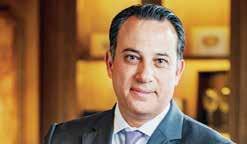

Fairmont the Palm has appointed Dany El Mahgiub as its director of operations. He brings 15 years of experience in hospitality leadership to the role.

El Mahgiub will be responsible for ensuring the financial and organizational success of the esteemed luxury property. A seasoned hotelier, he is making his return to Fairmont the Palm after nearly a decade. In 2012, he began his career as part of the pre-opening team as a restaurant manager.
El Mahgiub brings extensive experience within the F&B industry and supporting management roles at leading establishments in the UAE, including Atlantis the Palm as operations manager for Nasimi Beach, followed by a move to Ronda Locatelli by Michelin chef Giorgio Locatelli.
A dedicated leader, El Mahgiub is an asset to the Fairmont the Palm management team, promising to deliver a new standard of service excellence to hotel guests.
READ MORE ONLINE HOSPITALITYNEWSMAG.COM
MAY-JUL 2023 | HOSPITALITY NEWS ME 13
TAKING THE LEAD WITH MARK PATTEN, SENIOR VP OF FOOD & BEVERAGE AT THE FIRST GROUP
What does it take to ensure the success of such a diversified portfolio of restaurants?
The food and beverage offerings in Dubai are very diverse. Finding markets that haven’t been saturated with restaurants is essential. The secret to success is offering reliable products at affordable prices and top-notch customer service.
Ultimately, the success of a food and beverage business is defined by the satisfaction of customers.
Through the F&B division, you have introduced contemporary hospitality concepts to the region. Can you tell us more about this?
An internationally award-winning chef and highly respected food and beverage operations specialist, Mark Patten is leading The First Group’s fast-growing F&B division. Here, Patten tells us more about the group’s expansion.

Risen Artisanal Café’s brand goal is to provide customers with an artisanal patisserie and bakery, offering top-quality ingredients and products at an accessible price. It sets itself apart with unique menu items ranging from entremets to breakfast items and bread, a unique coffee blend and hot dishes. By being located in convenient and accessible spots, customers can grab a quick bite.
UNLOCKING THE SECRETS TO THE SUCCESS OF EM SHERIF WITH MIREILLE HAYEK
What makes your concepts appealing to audiences in the Middle East and Europe?
The First Group’s portfolio strikes a balance between quality ingredients and entertainment.
We take into consideration market prices when developing concepts and strive to offer exciting menu options and activations throughout the year.
How do you see the future of the UAE’s culinary scene unfolding?
Compared to 10 years ago, the UAE has evolved into a global leader and a considerably more mature market. This is evident in the expansion of diverse categories of brands, from casual dining to high-end restaurants. This shift has been made possible by the commitment of industry experts who are developing new concepts and catering to consumers’ demand for quality.
Today, the UAE offers a range of premium top-end restaurants, as well as midscale options that are accessible to residents and hotel guests. The Middle Eastern professionals’ skillset has improved and can now rival the ones of leading cities such as London, Paris, and New York.
thefirstgroup.com
Mireille Hayek is an intuitive, spontaneous and meticulous restaurateur. However, she doesn’t take success for granted. In this exclusive interview, Hayek shares her journey so far and tells us what drives her ambition.

We believe that the main ingredients for success are quality, consistency, perseverance, presence and authenticity. As a skilled home cook, my passion for showcasing Lebanese culture and my family’s support have fueled my desire to become a flagbearer for my country’s cuisine. At Em Sherif, we strive to create an immersive experience, where customers can touch, see, taste and feel all the aspects that make up our unique landscape. Our goal is to create an authentic and soulful atmosphere in every Em Sherif location. Your daughter, Yasmina, was heavily involved in developing the menus at your concepts. What can you tell us about this mother-daughter collaboration?
Together with my daughter, we form a formidable team. I bring my knowledge of the market and understanding of Lebanese
culinary techniques, while my daughter contributes her expertise in innovative cooking techniques and design.
Do you have any expansion plans or new concepts in the pipeline? We have several openings scheduled in the GCC region and beyond, including Em Sherif Restaurant in Oman and Dubai, Em Sherif Sea Café in Riyadh and Em Sherif Café in Oman, KSA, Bahrain, Jordan and Irbil. Em Sherif has also expanded to Europe with the opening in London at Harrods, in Monaco at Hotel de Paris and soon in Greece, France and Switzerland. We recently launched Em Sherif Deli, which offers ready-toeat items from its extensive menu. The first outlet began operating in Harrods London in January 2022 and the concept is expected to rapidly expand throughout all locations in the coming years.
emsherif.com
F&B NEWS
FOR UP-TO-THE-MINUTE NEWS ON THE STORIES THAT MATTER TO YOU MOST, read it first on hospitalitynewsmag.com
HOSPITALITY NEWS ME | MAY-JUL 2023 14
CHANGING THE FOOD NARRATIVE WITH EMMA BANKS, HILTON'S VP OF F&B STRATEGY AND DEVELOPMENT EMEA

array of soft benefits and showcase our talented #HiltonTastemakers across our aspirational, omnichannel content platform @TasteOfHilton.
The company is recognized across the world at the highest levels as a workplace for women, providing a host of leadership development opportunities from mentoring to international accredit courses. As a testament to our efforts, Hilton was ranked the third best workplace in KSA and the fourth best workplace in the UAE by Great Place to Work® in 2022.
As a seasoned hotelier and F&B expert, Emma Banks, VP of F&B strategy and development EMEA at Hilton, tells us how the brand is securing a better future for professionals thanks to initiatives. How is your company tackling talent retention and promoting diversity and inclusion in the workplace?
When it comes to talent retention, Hilton’s value system centers on nurture and team member appreciation, driven by purpose. We leverage the extraordinary learning and development tools available to us through Hilton University, support individual wellness through “Thrive@Hilton,” promote the wide
Local sourcing and food waste are becoming of greater concern. How is Hilton embracing the sustainability movement?
For clients, sustainability is very important. Increasingly people are leaning toward companies that operate with fact-based accountability, integrity and transparency. Operators can no longer disregard their environmental effects due to the increasing ‘tech-celeration’ in the food and drink market involving both responsible sourcing and food waste management. This also emphasizes the possible cost-benefit of acting responsibly.
Under our Travel with Purpose ESG strategy, we have ambitious carbon reduction targets in line with the Paris Agreement. Last year
ON THE COUCH WITH NICK COMATY, VP OF F&B MEA AT ENNISMORE

What is the secret to creating trendy and successful concepts?
The secret to a successful restaurant is to surround yourself with passionate professionals and create a successful venue. This includes music, sound, food, drinks and service, as well as marketing and PR. It is also important to be consistent, as the only metric of success is guest satisfaction and loyalty.
What can you tell us about your position and what it entails?
we publicly committed to procuring 350 tons of local produce via our aggrotech partner Fresh On Table in the UAE.
Thanks to the commitment of our entire UAE-based business, we ended up procuring 446 tons of local produce resulting in a saving of 128 million food miles. We will soon share our 2023 targets for an even greater impact to support local food security.
In line with our Travel with Purpose strategy, Hilton is committed to cutting waste in half by 2030.
In addition, we launched a Winnow AI technology pilot project across 21 hotels in 10 different countries across EMEA. We have now rolled this out to around 69 properties and are planning for more.
Do you have any projects in the pipeline?
Last year at the Future Hospitality Summit, Hilton announced that it will more than double its presence in the Middle East in the next three to five years across a few markets , including the UAE, Egypt, Saudi Arabia, Kuwait, Qatar and Bahrain.
Naturally, the restaurants and bars in these exciting new hotels have a major role to play. Whether they are self-developed concepts or the result of exciting strategic partnerships, these food and drink venues will be designed with the objective of adding value to the hotel’s market positioning, as a differentiator. hilton.com
True to his mantra of family over everything, Nick Comaty has managed to make Ennismore his second home. We sat with the accomplished F&B professional to learn more about the brand.
I am the vice president of food and beverage operation and development at Ennismore for the Middle East, Africa, Turkey and India. I oversee our existing properties, namely SLS Dubai, 25hours One Central, Hyde Dubai and Mondrian Doha, as well as helping and guiding the team and supporting major activations. On the development side, I am involved with the Carte Blanched team from the
initial assessment and business plan right through to delivery.
What challenges and opportunities are you anticipating?
I try to focus on finding solutions to certain challenges, such as oversupply, lack of talent, short lifespan, low margins and seasonality, as well as creating opportunities by developing our internship programs with international hospitality schools and management programs to find great team members and develop future leaders. Whenever I brainstorm with my colleagues, I realize that there’s never a dull moment in the world of F&B.
Furthermore, to maintain a healthy number of clients per seat, we are establishing restaurants that are smaller than those we used to create a decade ago.
ennismore.com
READ MORE ONLINE HOSPITALITYNEWSMAG.COM Read our interviews in full on hospitalitynewsmag.com
MAY-JUL 2023 | HOSPITALITY NEWS ME 15
5 MINUTES WITH JORDANIAN TOP CHEF ALI GHZAWI
What has life been like for you after winning Top Chef?
In an exclusive interview with Hospitality News ME, Ali Ghzawi, Jordanian patron chef of Alee restaurant and former winner of MBC Arabia’s Top Chef (2019), shares his story and ambitions for the future.
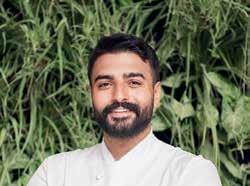
Since winning Top Chef, life has been a rollercoaster. Connecting with millions of people across the region through social media is amazing. Furthermore, the fact that I was among Forbes ME 30U30’s most influential figures in the region is rewarding in itself. I’ve managed to leverage this exposure and my passion to further connect with my fans by opening several F&B venues under my main concept Alee. Also, I’m delighted to share that I'll be participating in Top Chef World All Stars, which will be aired on March 9 on Bravo TV on Peacock.
What can you tell us about your new restaurant?
Alee is an upscale Middle Eastern restaurant that reflects our culture, background and roots. You will find sharing menus that
celebrate the flavors and ingredients of the region with a touch of personalization. We believe that life is all about experiences and moments, which is why we take pride in sharing the beautiful stories of every dish and the inspiration behind it.
The restaurant is divided into three parts: the dining area, lounge and open space that holds cooking demos and serves as a place to teach the community about culinary arts.
How would you describe Jordan’s dining scene and how do international visitors react to it?
Jordan’s culinary landscape has evolved with concepts that cater to tourists from across the world. However, I urge restaurateurs and hoteliers to ensure that our culture and heritage are reflected in their upcoming F&B projects. aleebyali
A THEATRICAL DINING EXPERIENCE WITH ANTONIO LOPEZ
What makes Teatro an award-winning concept and what is the secret behind its longevity?
Teatro, Rotana’s signature restaurant at Park Rotana Abu Dhabi, has withstood the test of time. I genuinely believe there is no single secret to Teatro’s success - rather it largely comes down to the team’s intrinsic passion for consistency, quality, freshness and offering guests beautiful dining experiences to all our guests.
Antonio Lopez, Teatro UAE Restaurant’s executive sous chef, offers us a glimpse into what makes Teatro such a phenomenal success.
What can you tell us about the food you offer?
Teatro, as its name implies, promises a theatrical eating experience from beginning to end. It is an award-winning restaurant, with a dynamic menu filled with the finest dishes, from Thai, Indian, Chinese and
Japanese to Italian, thus spotlighting the world’s finest gastronomy. I would like to mention the excellent chefs in my team who entertain guests with live cooking and those in charge of the sushi bar.
Aside from unique menu items, what experience can guests look forward to enjoying at Teatro?
At Teatro, there are many possibilities, and we are quite open to interactions between our chefs and our patrons. We also concoct food and drink promotions for tableside service with care while the lively ambience, distinctive interior decor, wide variety of wines in our cellar and many other elements undoubtedly help to make the Teatro experience a special one.
rotana.com/parkrotana
FRENCH MEETS ITALIAN WITH CHEF SAVERIO SBARAGLI
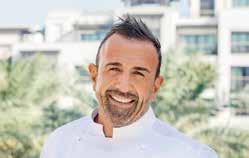
What drew you to Dubai and how would you describe its culinary scene?
Born in Tuscany, chef Saverio Sbaragli grew up with a deep understanding and appreciation of Italian cuisine, and has worked alongside renowned Michelin starred chefs. In this exclusive interview, we discover how the head chef of Al Muntaha UAE is guided by three pillars
My career began in France, where I studied under Michelin-starred chefs Alain Ducasse and Alain Passard. I honed my French cooking skills and discovered the value of consommé and sauces. Afterward, I traveled back to Italy and started working at Florence’s Enoteca Pinchiorri, before joining Il Lago restaurant at Four Seasons Hotel des Bergues Geneva in 2012. It was there that I received my first Michelin star, followed by my second star at Tosca Geneva, where I served as head chef.
At Al Muntaha, I am reimagining traditional French and Italian dishes, and offering Dubai’s diners an exquisite gastronomic experience.
What defines a Michelin-starred chef?

It is a mark of excellence and dedication to
delivering an exceptional dining experience. When Al Muntaha was awarded a Michelin star, it was an exceptionally proud moment for all of us. It is a testament to my team’s dedication to consistently enhancing the guest experience and paying constant attention to every detail.
How would you describe your cooking style?
Through my cooking, I aim to leverage my experience and creativity to take guests on a culinary journey through France and Italy. It brings me great joy to share my love and passion for food with my team and our guests, so I aim to constantly innovate to communicate emotion through my food and plating.
almuntaha.dubai
CHEFS NEWS
HOSPITALITY NEWS ME | MAY-JUL 2023 16
EMF AND CALLEBAUT LAUNCH THE NXT GENERATION OF CHOCOLATE IN THE UAE
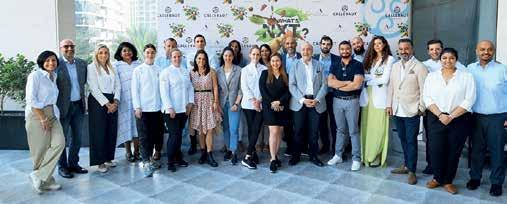
ginger & M_lk chocolate tarts; vegan brownies; exotic travel cakes; and bonbons. Chefs Romain Renard, Panagiotis Samaras, Laura Gonzalez, Bertrand Le Gallic, Vincenzo Delgiudice, Fadi Kurdi and Evah Reaidy prepared a range of vegan desserts. Callebaut invited nutritionist Tina Chagoury to shed light on the vegan movement and explain the benefits of veganism.
Callebaut NXT has entered the UAE market thanks to Callebaut’s official partner EMF Emirates, offering a new product range characterized by exceptional taste, a creamy texture and quality.
After a string of successful launches, chocolate maker Callebaut has officially launched Callebaut NXT in the UAE. The entirely plant-based dark and milky tasting chocolates are completely dairy free.
To mark the launch of NXT, the EMF and Callebaut teams held an event at The Chocolate Academy in Dubai on March 7, 2023, for chefs and artisans, at which seven renowned chefs from across the globe came together to create exquisite chocolate dishes. Chef Marike Van Beurden, pastry and chocolate consultant, created an ensemble of original vegan treats, including: matcha and NXT cookies; an apricot and M_LK NXT chocolate-plated dessert; mango, lime,
DAIRY BUSINESS WITH LAURENT DAMIENS, COO OF CNIEL FRANCE
The NXT range was developed over several years with the support of R&D experts and a team of chefs and artisans. It aims to assist chefs and artisans in catering to the increased demand for vegan, plant-based, allergen-free and environmentally friendly desserts and chocolates. The NXT range not only offers worry-free alternatives for classic and modern recipes, but it also provides how-to guides, inspiration and tips and tricks through the newly launched NXT digital platform. callebaut.com
Laurent Damiens, COO of CNIEL, sheds light on the current trends in dairy and explores sustainability and innovation within the industry.
What are the current trends in dairy consumption and how have they evolved in recent years?
Dairy consumption has increased significantly over the last decade, especially in China, India and Southeast Asia. In Europe and the US, demand is quite stable. Overall, average annual growth of 2 percent has been recorded in the last 10 years. There has been a steady increase in consumption in the Middle East, mainly in the UAE, Saudi Arabia and Lebanon. Even though we continue to have stronger exports from most of the European countries, the
Lebanese market remains lucrative for us as there are still people there with money. The years 2018-2019 witnessed stable consumption despite the pandemic. We thought we would be facing difficulties after Expo 2020, but the opposite occurred. With the influx of Russians and Saudis, who are inclined to import the finest dairy products, especially butter, potential problems were averted. We are expecting an additional boom in the future. Right now, consumption is more about retail and foodservice. However, we believe there will be further growth in Saudi Arabia.
According to a study conducted by La Banque Mondiale, demand for dairy products is going to increase over the next 10 years, as will consumption per capita. We therefore want to continue to be able to produce, and we urge countries to be more sustainable. All in all, I am optimistic for the future.
Which markets are you focusing on?
Two years ago, we were focusing on Saudi Arabia. However, due to the Russian-Ukraine war and the number of Russians fleeing their country toward the UAE, the market has become even more lucrative for us. So we still have two booming main markets and other small but steady markets are flourishing. Iraq could be one such example.

What are the latest innovations in dairy products and how are these shaping the market?
France has always been an innovator of cheese. As Charles de Gaulle once said, “How can you manage a country with 366 kinds of cheese?” Twenty years ago, France recorded over 1,000 kinds of cheese. I believe that in 2024, France will record 2024 kinds of cheese. Every two decades, 1,000 additional kinds of cheese are released on the market. French companies are very competitive; they constantly release new cheeses to cater to the local taste of different countries. On the other hand, we have protected designation of origin (PDO) products that have been made the same way for 200-1,000 years, like Camembert and Roquefort. So we have two different trends: we want to consolidate the know-how of traditional cheeses and the demands of modern consumers in terms of taste and packaging.
Some countries are more traditional, while others are more innovative. For example, in the Netherlands, they mix Gouda with cranberries or coconut. We need innovation in the market. We need to stay true to tradition, while releasing new products. filiere-laitiere.fr
SUPPLIERS
MAY-JUL 2023 | HOSPITALITY NEWS ME 17

Contact
Bahrain: Fine Foods
Egypt: AM Foods
Jordan: Frozen Food House Co.
Kaylani Food Center
Kuwait:
Alyasra Foods
Azzad Trading Group
United Supply Food Services
Oman:
Chef Middle East Oman
Qatar:
Chef Middle East Qatar
Deliopolis
Qatar National Import & Export Co
Saudi Arabia:
Arabian Food Corporation
Gulfwest Company Riyadh
Gulfwest Company Jeddah
UAE:
Aramtec
Chef Middle East Abu Dhabi

Chef Middle East Dubai
Faisal Al Nusif Trading Company
Rastelli Global Middle East
Transmed Overseas Incorporated
your sales representative today.
26288
A SUCCESSFUL FIRST EDITION OF HORECA AND SALON DU CHOCOLAT ET DE LA PATISSERIE IN JEDDAH


The first edition of HORECA Jeddah, which took place from February 7-9, 2023, at Jeddah Superdome, was hailed a success, gathering together more than 15,000 visitors and 100 exhibitors.


Attendees were able to meet prominent international experts, establish connections with professionals from the world of hospitality and foodservice, as well as explore an endless array of stands, brands, products and innovations. Furthermore, the Jeddah edition included three competitions: Hospitality Salon Culinaire, the Barista Competition and the Giffard Mocktail Competition.
A special award was given to chef Thomas A. Gugler, a Swiss culinary educator, consultant and author, for his achievements and contributions to HORECA. Gugler is the president of the World Association of Chefs’ Societies (WACS), the global reference in terms of food and culinary standards.
In addition, the exhibition was marked by the strategic partnership of the Saudi Culinary Arts Commission, a public entity launched and governed by the KSA Ministry of Culture.
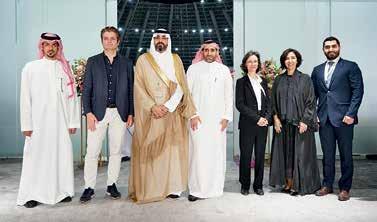
Jad Taktak, CEO of SEMARK Group, organizer of Saudi HORECA, said: “The exhibition exceeded our expectations in terms of the number of exhibitors and quality and number of visitors. We are honored to introduce such a beautiful event to Jeddah, which complements our event in Riyadh.”
Joumana Dammous-Salamé, managing director of Hospitality Services, the company that founded HORECA, stated: “I am thrilled to announce that HORECA Jeddah was a huge success. We have received excellent feedback, and we promise to continue delivering outstanding HORECA events throughout the region.”
Jeddah is the most recent addition to HORECA host cities. The network currently includes yearly events in Beirut, Kuwait City, Amman, Muscat and Riyadh.
Salon du Chocolat et de la Pâtisserie took place concurrently with Saudi HORECA Jeddah.
REVIEW HORECA NETWORK HOSPITALITY NEWS ME | MAY-JUL 2023 20
The world-famous event showcased the best in chocolate and confectionery, as well as local items like dates and Arabic sweets. Other features included a chocolate fashion show, demonstrations, workshops and chocolate-inspired competitions.

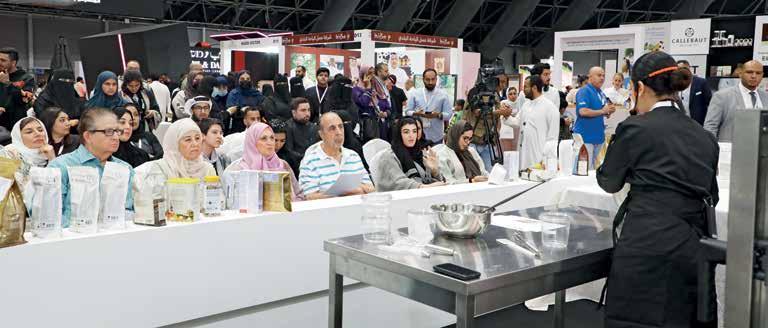

The event gathered together more than 60 chocolate, pastry and ice-cream shops, manufacturers, suppliers and distributors to the delight of 15,000 visitors.
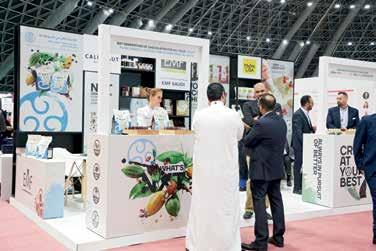
“We were thrilled to bring Salon du Chocolat et de la Pâtisserie Jeddah to life. The industry has come a long way in KSA, so it was the right time to take this step,” said Joumana DammousSalamé, managing director of Hospitality Services, the company behind HORECA and co-organizer of both events. The next HORECA Jeddah and Salon du Chocolat et de la Pâtisserie Jeddah will be held from February 5-7, 2024. salonduchocolat-ksa.com saudihoreca.com

MAY-JUL 2023 | HOSPITALITY NEWS ME 21
A STELLAR EDITION OF HORECA KUWAIT
HORECA Kuwait, the annual hospitality and foodservice event, ended on March 8, 2023, with great feedback from guests and exhibitors.



The three-day trade show attracted over 5,000 visitors from Kuwait and the entire Arab region to explore a wide variety of products and services, as well as attend talks and watch live competitions. In total, more than 100 exhibitors and over 20 international guests were present.


Kuwait is, today, firmly on the hospitality and foodservice map and a top business meeting place for professionals. Indeed, HORECA Kuwait’s 11th edition was rich in new products and innovations, spotlighting opportunities for business owners, suppliers, buyers and distributors.
HORECA Kuwait hosted HORECA TALKS, a series of conferences aimed at tackling a variety of hot topics in hospitality and F&B. Organized in collaboration with Hodema consulting services and Hospitality News Middle East, the program of talks comprised: “Hoteliers’ debate: what to expect from Kuwait’s hospitality sector in 2023”; “Serving up hot trends and the latest F&B concepts in Kuwait”; “Food tech and beyond: what’s cooking in Kuwait?”; and “The great hospitality race: franchising versus homegrown brands in Kuwait.” In addition, three competitions were held, namely the Hospitality Salon Culinaire, the Barista Competition and the Bed Making Competition.
Nabila Al Anjari, general manager of Leaders Group, said that HORECA Kuwait has always championed hospitality and F&B in Kuwait, and remains a key platform for professionals to network and do business.
Similarly, Joumana Dammous-Salamé, managing director of Hospitality Services and co-organizer of HORECA Kuwait, expressed her joy and pride in seeing the event grow over the years. She pointed out that HORECA would always be a place for professionals to meet, do business, explore and create exceptional memories.
Mohamad Najia, executive director of Leaders Group for Consulting and Development, co-organizer of HORECA Kuwait, highlighted the importance of the exhibition for Kuwait’s hospitality and foodservice market. He added: “The exhibition has been really successful over the years. The first edition gathered together 25 participants. Today, 11 years later, that number has grown to almost 80 companies, which means that the hospitality and foodservice industries are buoyant in Kuwait”.
HORECA Kuwait returns to Kuwait International Fair from January 15-17, 2024.
horecakuwaitexpo.com
REVIEW HORECA NETWORK
HOSPITALITY NEWS ME | MAY-JUL 2023 22

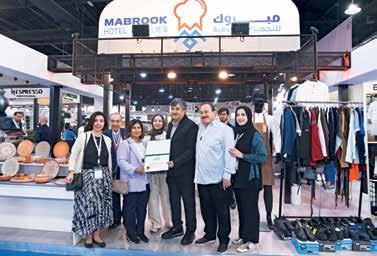
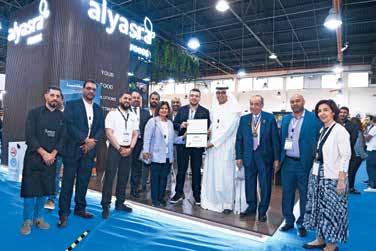




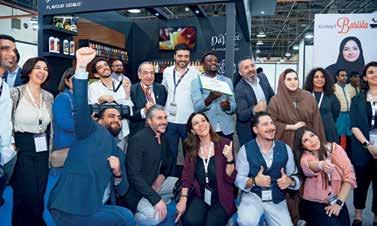
MAY-JUL 2023 | HOSPITALITY NEWS ME 23
HORECA LEBANON’S STRONG COMEBACK
HORECA, the hospitality and foodservice meeting place, is returning to Seaside Arena, Beirut, from April 25-28, 2023. The 27th edition looks set to be an exciting one, with an array of activities, including industry-led talks, competitions and networking events.

Randa Dammous Pharaon, project manager, said: “This year, HORECA Lebanon is held under the theme ‘Connect. Be Inspired. Explore.’ After a two-year hiatus, we are looking forward to welcoming back thousands of trade professionals, who will have the opportunity to discover the products, services and technologies of over 150 exhibitors. Through its various activities, HORECA will bring us all together to discuss and debate challenges and celebrate what Lebanon has to offer."
Indeed, to pay tribute to Lebanese entrepreneurship and the will to overcome difficult market conditions, local production and import substitutes will be taking center stage. The program will feature HORECA Innovations, highlighting new product releases, as well as the HORECA Theater, where talented chefs will host product demonstrations.
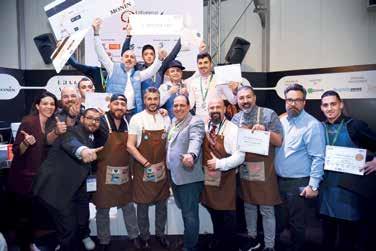

In addition, HORECA’s renowned competitions, namely the Junior Chef Competition, Coffee in Good Spirits and the Lebanese Bartenders Competition, will return to Seaside Arena, with an impressive lineup of expert judges. Michelinstar chef Alan Geaam and award-winning chefs Antonio Bachour and Philip Khoury are just a few of the famous guests who will be present at the renowned trade show. Furthermore, visitors will be able to attend a series of roundtable discussions, which aim to tackle the hottest topics in hospitality and F&B, such as sustainability, technology and opportunities in times of crisis. These HORECA TALKS are co-organized by Hospitality News Middle East and Hodema consulting services.
Joumana Dammous-Salame, managing director of Hospitality Services and event organizer, said: “This year, HORECA Lebanon has partnered with the Association of Lebanese Industrialists and with Lebanese commercial attachés abroad to bolster Lebanese exports and ensure they are promoted more intensively overseas. We have worked hard to put this edition together, to honor the essence of Lebanese hospitality, built on our agility, creativity and hard work.”
horecashow.com
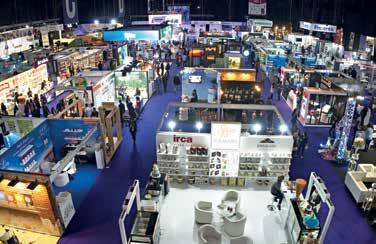
PREVIEW HORECA NETWORK
HOSPITALITY NEWS ME | MAY-JUL 2023 24
25-28 apr 2023
HORECA lebanon
27th Edition
The business meeting place for the hospitality and foodser vice industries. horecashow.com
18-20 MAY 2023
SALON DU CHOCOLAT | DUBAI
2nd edition
Salon du Chocolat Dubai is a show dedicated to those passionate about chocolate. Bringing together professional chocolate tasters, chocolatiers and chocolate enthusiasts. salonduchocolatdubai.com
30 May–1 Jun 2023
HORECA OMAN
2ND Edition
Bringing hospitality professionals and industr y experts together for the only show of its kind in Oman. horecaoman.com
15-17 JUN 2023
THE GARDEN SHOW & SPRING FESTIval
17th Edition
An essential destination for outdoor enthusiasts, with plants, flowers and ideas to enhance and decorate outdoor spaces. the-gardenshow.com
15-17 JUN 2023
TR AVEL LEBANON
7th Edition
An annual celebration of Lebanon’s magnificent beauty spots, travel destinations and the best summer activities. lebanontraveler.com
17-19 0ct 2023
HORECA JORDAN
9th Edition
Bringing together professionals and exhibitors from Jordan and the wider region. horeca-jordan.com
HOSPITALITY SERVICES delivering valuable business
BUSINESS, FOOD & LIFESTYLE EVENTS
26-28 OCt 2023
whisky live beirut
6th Edition
A must for whisky enthusiasts and connoisseurs, showcasing the finest and rarest whiskies on the market. whiskylivebeirut.com
9-11 Nov 2023
BEIRUT COOKING FESTIVAL
9th Edition
The ultimate culinary event highlighting country’s top chefs, leading food and beverage brands, artisanal products and the art of living. beirutcookingfestival.com
9-11 Nov 2023
SALON DU CHOCOLAT | BEIRUT
6th Edition
Dedicated to chocolate, the salon welcomes the country’s top chocolatiers and hosts the finest chocolate brands and chefs from around the world. salonduchocolatbeirut.com
27-29 NOV 2023
SAUDI HOREC A | riyadh
12th Edition
The biggest international food, beverage & hospitality exhibition saudihoreca.com
15-17 JAN 2024
HORECA KU WAIT
12th Edition
Kuwait’s annual hospitality and foodser vice event. Horecakuwaitexpo.com
TBA 2024
SAlon du chocolat
2nd Edition
JEDDAH
The largest event in the world dedicated to chocolate and pastry is coming to Jeddah! salonduchocolat-ksa.com
Publications & DIGITAL PLATFORMS
HOSPITALITY NEWS
MIDDLE EAST
Focusing on the latest news, innovations and trends within the region’s hospitality and foodservice sectors.
Daily news bulletins on hospitalitynewsmag.com
TASTE & FLAVORS
The ultimate English language food and lifestyle reference, packed with recipes, chefs’ picks, gift ideas, home and gardening tips, and lifestyle advice.
Daily updates on tasteandflavors.com
LEBANON TRAVELER
Lebanon’s key tourism reference, highlighting the country’s best kept urban and rural secrets, top destinations and activities.
Daily updates on lebanontraveler.com
INITIATIVES
SAUDI JEDDAH
2nd
6-8 Feb 2024 HOREC A | Edition
KSA's largest food, beverage and hospitality exhibition saudihoreca.com/jeddah
A social initiative that reinforces Beirut’s global reputation as a center of excellence, talent and creativity.
Celebrating the finest culinary experiences across Beirut.
COntact us !
|
DUBAI +971 (0) 58 509 8057 BEIRUT +961 1 480 081
hosp_services hospitalityservices.me Hospitality Services participate@hospitalityservices.me
ALL EYES ON HORECA OMAN


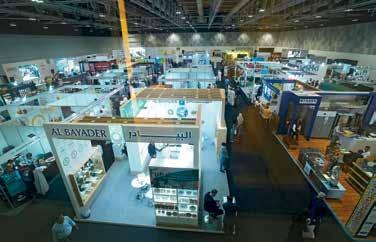


The second edition of HORECA Oman is being held at Oman Convention and Exhibition Centre, Muscat, from May 30 to June 1, 2023. Here’s what you need to know about the famed hospitality and foodservice event.
Following the success of its debut in May 2022, which welcomed more than 5,000 visitors, HORECA is returning to Muscat for the second consecutive year. Co-organized by Hospitality Services, a Beirut-based large-scale event organizer, and Al Nimr Expo, it is regarded by many as Oman’s premier hospitality and foodservice trade show.
According to Maha El-Khoury, project and sales director of HORECA Oman, the event is a must for industry professionals. “Besides our 200-plus exhibitors, representing more than 10 different countries, the forthcoming edition of HORECA Oman features a program packed with stimulating discussions, insightful workshops and exciting competitions that will identify and reward the country’s top talents.”
Indeed, over 100 of the most promising chefs, culinary students, baristas and mixologists are set to go head-tohead in a series of live cooking, display challenges, barista, latte art and mocktail competitions that will put their skills to the test.
Joumana Dammous-Salamé, managing director of Hospitality Services, added: “With a 30-year history, HORECA’s mission has always been to empower local players, support growth in the sectors it serves, encourage networking and create opportunities for the hospitality, foodservice and tourism industries. HORECA Oman is one of our newest shows, yet it is one of the most interesting, as the sultanate is evolving, particularly from a hospitality perspective. It promises to be a fantastic event."
Salim Al Hashmi,ceo of Al Nimr Expo, said: “We are really looking forward to hosting another HORECA Oman and to welcoming professionals from across the region to Muscat, which continues to display great investment and development potential. It is an extremely valuable trade and business platform where visitors can discover the latest hospitality- and F&B-related products, services and technologies.”
horecaoman.com
PREVIEW HORECA NETWORK
HOSPITALITY NEWS ME | MAY-JUL 2023 26
SALON DU CHOCOLAT ET DE LA PÂTISSERIE
SET TO RETURN TO GALERIES LAFAYETTE
Salon du Chocolat et de la Pâtisserie, the largest event in the world dedicated to chocolate and pastry, will be marking its second edition in Dubai, from May 18 to May 20, 2023.



Taking place at the fashionable Le Gourmet in Galeries Lafayette, Dubai Mall, this one-of-a kind event brings together professional chocolate tasters, chocolate masters, chocolate enthusiasts, as well as celebrated authors and pastry chefs from around the world.
The 2023 program will include unique workshops and masterclasses hosted by famous chefs and dozens of chocolate and pastry exhibitors. Visitors will also be invited to discover, taste and buy exquisite chocolates from leading international brands and take part in exclusive meet and greets with renowned pastry chefs.

Joumana Dammous-Salamé, managing director of Hospitality Services, the event organizer, said: “We are delighted to organize this event for the second consecutive year in Dubai. This amazing city, being the top destination on TripAdvisor, symbolizes both innovation and prosperity, not only in hospitality and foodservices but also in all major industries. These constitute the main qualities and values our work is based on.” She added that the event is a celebration of pastry, sweets and confectionery, and provides a great opportunity to showcase local artisanship.
Among its many highlights, Salon du Chocolat et de la Pâtisserie will host a spectacular Chocolate Fashion Show, which will take place daily. A total of 13 dresses created by well-known pastry chefs and ESMOD fashion design students will appear on the catwalk inspired by “La Femme et la Mode.” Participating chefs include Bernard Charles, Karim Bourgi, Dany Mouawad, Charles Azar, Brice Konan-Ferrand, Abdellah Tougda, Julien Jacob, Polina Filimonova, Dimitri Esposito, Edmond Roukoz, Bertrand Le Gallic, Jérémy Molliex-Donjon and Christiane Trilck. Elsewhere, pastry chefs will demonstrate how to prepare exquisite desserts at the Pastry Show and Choco Demo. Even children will be able to experiment with chocolate at the Salon du Chocolat Junior.
Maha El Khoury, projects and sales director at Hospitality Services, said: “Salon du Chocolat et de la Pâtisserie will certainly not disappoint its visitors, as we have prepared an outstanding program that fits chocoholics of all tastes and ages.” She added: “Dubai is known for being unique and captivating in all its activities, so we will do the same. In this regard, we have assembled all renowned pastry chefs and chocolate masters in the most modern city in the world, gathering the elites of the hospitality and foodservice industry.”
Since its launch in Paris almost 30 years ago, Salon du Chocolat et de la Pâtisserie has become an international reference for those interested in discovering the latest chocolate and pastry trends. Today, the show is held in major cities around the world, including New York, Tokyo, London, Brussels, Cologne, Lyon, Shanghai, Marseille, Zurich, Cannes, Milan, Hong Kong, Beirut and beyond.
“From playing host to the inaugural edition of Salon du Chocolat to our incredible in-house pastry chef extraordinaire Dany Mouawad, launching exclusive chocolate lines for the likes of Idriss B and housing arguably the largest collection of gourmet chocolates in town, Le Gourmet’s reputation as a chocolate lover’s haven remains intact. We are so excited to welcome back this one-of-a-kind-event and look forward to another memorable weekend of catching up with old friends over chocolate and conversation,” said Mario Faria, head of food and beverage at Galeries Lafayette, Le Gourmet.
salonduchocolatdubai.com
WHERE TO BE SEEN EVENTS MAY-JUL 2023 | HOSPITALITY NEWS ME 27
FHIS KSA RETURNS WITH ‘INVEST IN CHANGE’ THEME
MAY 2023
1-4 May DUBAI
ARABIAN TRAVEL MARKET Reed exhibitions arabiantravelmarket.com
7-9 May KSA
FUTURE HOSPITALITY SUMMIT The Bench futurehospitalitysummit.com
18-20 May DUBAI
SALON DU CHOCOLAT DUBAI Hospitality Services salonduchocolatdubai.com
20-23 May USA
The Future Hospitality Investment Summit (FHIS) is set to take place in Riyadh from May 7-9, 2023 at Al Faisaliah Hotel, Riyadh, KSA, featuring 110 speakers and 46 sponsors and partners. The 2023 conference program will explore themes from the Saudi Arabian Hospitality Investment Conference (SHIC) and Global Restaurant Investment Forum (GRIF), continuing the focus on sustainability, innovation, start-ups and human capital development, as well as the event’s signature culinary tours which offer a glimpse into exquisite restaurant concepts that are causing a buzz in the Saudi capital.

Held under the banner ‘Invest in Change’, this year’s conference will highlight the importance of continuing to drive positive change across the hospitality industry and shape it for the future by investing in time, intellect and expertise, enabling it to keep up with changes and trends. The newly established Advisory Board for the FHIS Saudi Arabia, comprising 37 senior industry leaders from across the Kingdom and wider region, came together in November to discuss the theme and help shape the agenda for this year’s conference.
“Following our sold-out edition of FHIS in Riyadh last year, we are very excited to be back in the Kingdom this year with our host sponsors Al Faisaliah Hotel and Al Khozama and our many other partners for the event,” said Jonathan Worsley, Chairman of The Bench. “Our new stellar bespoke Advisory Board members for FHIS KSA have shared invaluable input for this year’s conference program with their thoughts on change, transformation, innovation and continued evolution of our industry. The convergence
of thought leaders and industry experts will result in reshaping the industry through revolutionary ideas, groundbreaking innovation and avant-garde practices, and I can’t wait to see Saudi Arabia’s brightest minds and leaders in our industry come together to invest in change.”
The 2023 edition of the summit will bring together leaders from some of the world’s most dynamic hospitality brands, including: Khalid Saud Abu Haimed, chief executive officer, Al Khozama; Dr. Thaib Alharethi, assistant professor, King Abdulaziz University; Abdulsalam Alkuwaity, chief executive officer, SEA; Jimi Daodu, founder and CEO, Vault Hill; Susan Furness, founder and CEO, Web3 Strategist Ventures; Hicham Hassouni, strategy and business development chief officer, Boutique Group; Jerry Inzerillo, group CEO, Diriyah Gate Development Authority; Alex Kyriakidis, adviser to the hospitality and leisure sector and board member, Saudi Heritage Hospitality Company (NUZUL); James Morgan, dean, International Tourism and Hospitality College; Choon Quek, chief transformation officer and CTO, Saudi Tourism Authority; Beverly Rider, CEO, Tonomus Venture Studio, NEOM; Mark Rigby, general manager and regional vice president, Middle East and India, WhiteWater; James Riley, group chief executive, Mandarin Oriental Hotel Group; Ruben Toral, director of health and wellness, QUO Global; Ian Wilson, regional director for hospitality, The Line, NEOM; and Tom Wood, chief executive officer, The Boundary Architectural Visualisation.
futurehospitalitysummit.com
NATIONAL RESTAURANT ASSOCIATION SHOW Winsight nationalrestaurantshow.com
20-25 May DUBAI
THE HOTEL SHOW
Dmg: Events Middle East & asia & DWTC thehotelshow.com
30 May-1 Jun. OMAN
HORECA OMAN
Al Nimr Expo & Hospitality Services horecaoman.com
30 May-2 Jun. ABU DHABI
EMIRATES CULINARY GUILD
Emirates Culinary Guild and Abu Dhabi Chefs Association emiratesculinaryguild.net
SEPTEMBER 2023
10-12 Sep. KINGDOM OF SAUDI ARABIA
THE HOTEL SHOW SAUDI ARABIA
Dmg: Events Middle East & Asia thehotelshowsaudiarabia.com
11-14 Sep. AUSTRALIA
FINE FOOD AUSTRALIA
Diversified Communications Australia finefoodaustralia.com.au
25-27 Sep. DUBAI
FUTURE HOSPITALITY SUMMIT
The Bench futurehospitalitysummit.com
WHERE TO BE SEEN EVENTS
CALENDAR
HOSPITALITY NEWS ME | MAY-JUL 2023 28
G OO D B E C OMES BET T E R

For 100 years, Valrhona has brought out the best in chocolate alongside cocoa producers, employees and chefs. Its mission is to create a fair, sustainable cocoa industry while inspiring creative and responsible gastronomy 100% of the cocoa beans that we use can be traced back to our 17,215 producers: this provides the assurance of knowing where the cocoa comes from and who har vested it, and also that it was produced in good conditions. Valrhona’s commitment resulted in it obtaining B Corporation® cer tification with its exacting standards in January 2020, something it is very proud of. Choosing Valrhona means committing to a chocolate that respects both people and the planet.
TO LEARN MORE ABOUT OUR COMMITMENT, VISIT VALRHONA.COM

THE LANGUAGE OF LUXURY
WITH TIMOTHY KELLY
Nestled on the vibrant shores of Dubai, Atlantis The Royal reigns supreme as a luxurious escape, spearheaded by the executive vice president and managing director, Timothy Kelly, whose unwavering commitment to delivering on promises and exceeding guest expectations has cemented its status as a premier destination. In this interview, we hear what he has to say about the resort's offerings.
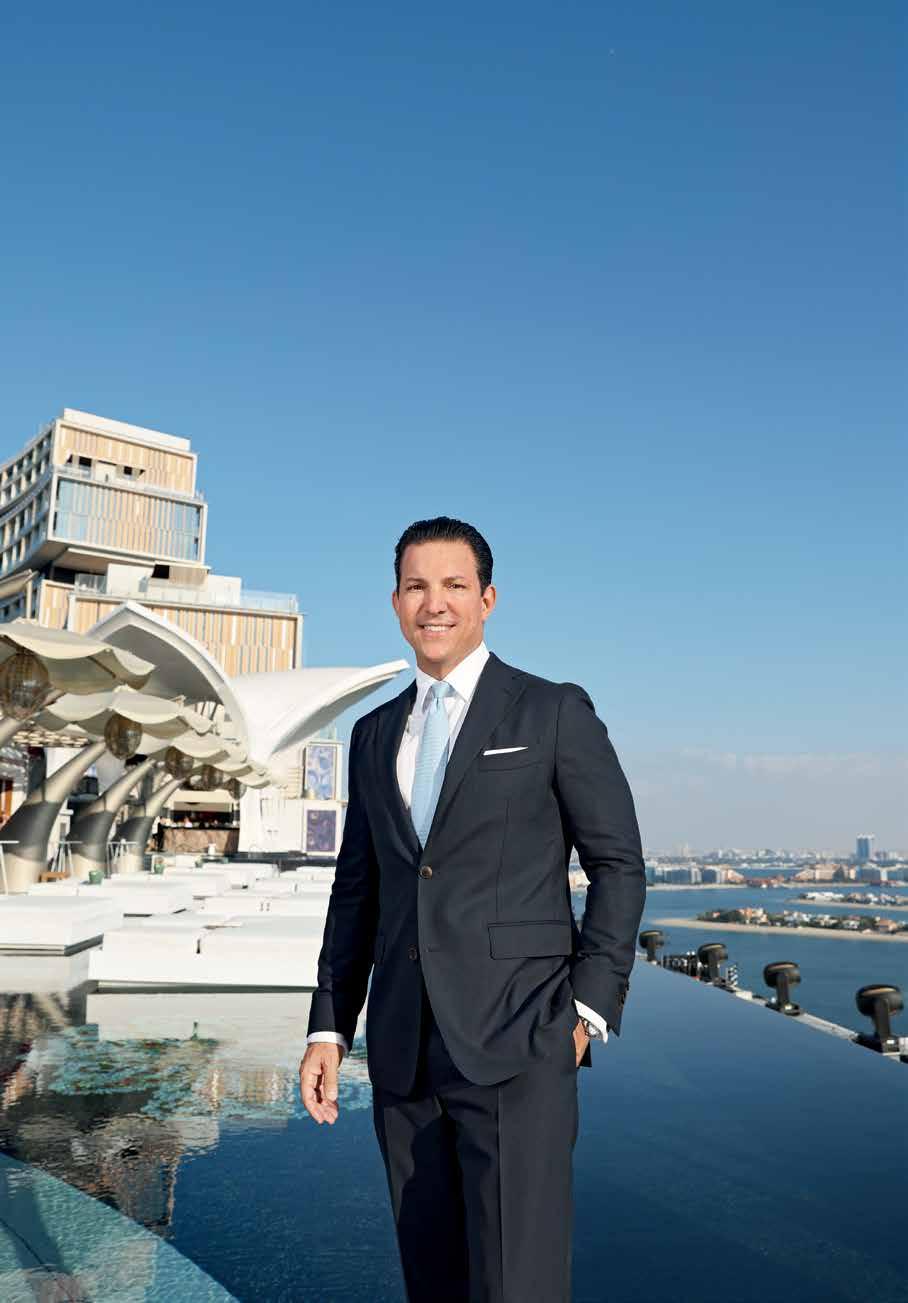
INTERVIEW BUSINESS
30 HOSPITALITY NEWS ME | MAY-JUL 2023
What can you tell us about your professional experience?
I have over three decades of experience and have worked in many major iconic destinations and resorts.
Having managed multiple property portfolios in Las Vegas, Macau and Cotai, I also successfully opened the Wynn Palace Resort and Casino in Macau in 2016. Prior to joining Wynn Resorts, I was the VP of hotel operations at MGM Grand in Las Vegas, where I managed a vast array of brands in the portfolio, with over 6,700 rooms.
I was part of Forbes Travel Guide's Service Advisory Committee, representing the AsiaPacific region for five-star luxury service and maintenance standards. I also served on the board of directors for the Nevada Hotel Lodging Association for six years and was recognized for my work and support of concierge services worldwide, receiving lifetime membership from Les Clefs d'Or International in 2009.
For the past five years, I’ve been responsible for managing Atlantis, The Palm's operations and strategic direction. All administrative, retail, food and beverage, banqueting and special events, marine and waterpark, and recreational services fall under my responsibility. Although my policy in Atlantis Dubai prioritizes people over profit, I made sure that Atlantis, The Palm achieved the highest resort revenue, the greatest guest satisfaction results and most impressive colleague engagement results in its history.
I am also a proud graduate of the University of Nevada in Las Vegas, earning my BSc in hotel administration in 1993 and my master’s in 2018.
So, you could say that my professional experience is leading large, integrated resorts. I’ve opened multimillion resorts, such as the signature Tower Suites that were part of MGM Skylofts, as well as the USD 4.8 billion Wynn Palace hotel in 2016 in Macau and, most recently, Atlantis, The Royal in Dubai.
How would you describe your leadership style?
My leadership style is people over profit. I build great teams and have certain expectations from them. My open-door policy means that anyone can come into my office at any time and have a conversation about anything.
I am good at developing strategies that deliver great results and surrounding myself with the best talent at all levels of the organization. I think that building great teams is probably the secret to my success in achieving outstanding results throughout my career.
Atlantis The Royal has been designed to challenge the boundaries of our imagination. How do you see it reshaping the definition of ultraluxury travel?
With regards to Atlantis The Royal and how it's designed to challenge the boundaries of imagination, I believe that its incredible architecture and design are extremely complicated, so much so that it can be appreciated close up and from afar. Take the “S” curve design of the building and the fact that it was basically designed from the bottom up, as if it were a bespoke, custommade suit. No two rooms are the same size, and there's no area of the tower, from the podium level to the very top of the 43rd floor, that resembles another. It stands tall amongst the beauty of the many glorious buildings found in Dubai.
We have villas in the clouds, and there are 44 pools throughout the tower. Interestingly, we have suites with more outdoor than indoor space. So, imagine yourself 30 stories high with a great pool and a mesmerizing view that's totally private!
In my opinion, we have the best suite on the planet: The Royal Mansion. It is 11,000 square feet and boasts two terraces, one that faces the Arabian Gulf and the other that affords a spectacular view of the Dubai skyline. It's among the world’s most expensive suites, retailing for USD 100,000 a night, and hosted Beyonce, who performed during the unveiling of Atlantis The Royal. The suite comprises four bedrooms but has the capacity to increase to 15 bedrooms. Besides having its own security, cinema room, safe room, office and gym, it also comes with a dedicated butler team, a team of chefs and spa staff, all of whom exclusively serve guests who stay there.
What really sets Atlantis The Royal apart is that it's the first integrated resort in the world that was designed with Instagram and social media in mind.
What differentiates Atlantis The Royal from other properties?
It is the only integrated resort in the world designed for social media. The hotel was conceptualized to provide outstanding views from every angle. No matter where guests stand — whether it's in the lobby, tower or restaurant — they can enjoy Dubai’s beautiful scenery. Although Atlantis The Royal may appear like an overpowering 43-story resort, it is quite intimate because of its vertical design.
In addition, our food and beverage offering is quite something. At Atlantis, The Palm and Atlantis The Royal, we proudly have the
largest number of celebrity chefs found anywhere in the world under one roof. This makes us a top choice for foodies and lovers of gastronomy. Our guests can select from 17 different restaurants anchored by Dinner by Gaston Acurio, all concepts we are proud of.
When it comes to wellness, what sets us apart is the fact that we have a 6,000 sq. ft. wellness clinic. There, guests can receive advice from healthcare professionals using proactive medicine versus reactive medicine. They can also access cutting-edge therapies using peptides and stem cells as mechanisms in which to better their health, wellness and quality of life. This makes us a pillar for wellness. Furthermore, we offer unique experiences. For example, guests can meditate with dolphins.
We have an impressive retail selection anchored by Valentino, as well as a Baccarat and crystal store. Louis Vuitton, the first of its kind in a hotel in the region, will open later this year.
In terms of entertainment, we have our ultralounge Ling Ling and the largest water park in the world. Guests can also access Atlantis Dubai’s entertainment facilities, our family entertainment called Wavehouse.
We believe that Atlantis The Royal is truly unique from a product perspective, but what really sets it apart from Atlantis, The Palm is that it's the first integrated resort in the world that was designed with Instagram and social media in mind. Guests are surrounded by Instagrammable and compelling features. Upon entering the resort, they walk through a “waterfall” with flames infused in glass to reach the lobby, which is filled with trees made of crystals. We also have aquariums with special art features, remaining true to our ocean theme.
What can you tell us about the grand reveal weekend?
The grand reveal ceremony was quite special for us. It was a very magical moment to host big names like Beyonce, Kendall Jenner, Jay Z, Rebel Wilson and Liam Payne. Our main objective was to raise awareness and capture the world’s attention, which we managed to do. The success of the campaign was phenomenal, as the event became a viral sensation, with over 45 billion impressions. How has the initial opening period been?
Since we opened on February 10, we have been quite active. To summarize, we are well ahead of our initial projections. The resort has been very well received. We didn’t want to have a product that competes with Atlantis, The Palm, rather, one that complements it; and that’s exactly what we have achieved not only for Atlantis but also for Dubai.
MAY-JUL 2023 | HOSPITALITY NEWS ME 31
SALMAN GASIM
ON TRAILBLAZING AND NURTURING HOSPITALITY TALENT IN KSA
Salman Gasim is the CEO of the Saudi Tourism Training and Recruitment (STTAR) Institute and the CEO of Swiss Hospitality Company. He also serves as the vice president of the Saudi Regional European Business Council at the Federation of Saudi Chambers. Here, he discusses the Kingdom’s rapidly changing hospitality industry landscape and the key role earmarked for homegrown talent in driving change.

INTERVIEW BUSINESS
HOSPITALITY NEWS ME | MAY-JUL 2023 32
How do you see the future of Saudi Arabia’s hospitality industry landscape evolving?
I am confident that Saudi Arabia will reshape the world tourism map by offering authentic and unique experiences and destinations to visitors across all segments, in line with the goals set out in Vision 2030. We will witness more travelers coming from the West and Far East to the Middle East, alongside a substantial increase in the number of domestic tourists, which is expected to more than double in the coming years.
Alongside the massive infrastructure development underway across the Kingdom which is supporting the realization of Saudi Arabia’s vision, I also expect to see an unprecedented improvement in the quality of life, which will encourage more visitors from international communities to not only visit us and experience life here, but also relocate and settle in the country.
The younger generation of Saudis are very ambitious, driven, keen to learn and eager to welcome the world to their homeland.
What are the key investment opportunities that Saudi Arabia offers?
Saudi Arabia holds a wealth of openings for investors. It has made a serious commitment to reforming the economy which has had a profoundly positive effect on the business environment and created unprecedented investment opportunities across the country and beyond.
Among the many initiatives introduced, the Tourism Development Fund (TDF) was established in 2020 as part of the Kingdom’s attempts to create more appealing financing opportunities. With a capital of USD 4 billion, the fund provides investors with access to high-potential tourism projects in key locations. In addition, the recent introduction of the Events Investment Fund (EIF) presents numerous opportunities for investors in the Kingdom’s cultural, tourism, entertainment and sports sectors.
Human capital development is a key component of Vision 2030. What is Swiss Hospitality Company doing to help the Kingdom achieve its aims in this area?
When Swiss Hospitality Company was established in 2014, it was with a vision to revolutionize the tourism and hospitality industry, and to upgrade the service quality to where it deserves to be by merging worldclass international standards and authentic Saudi hospitality values. In 2016, Vision 2030 was announced, and, a few years on, the Ministry of Tourism was set up with three key objectives, including one of creating 1 million jobs by 2030.
In 2020, we were given the mandate to design and develop “Ahlaha,” (Tourism Human Capital
Development Strategy) which will bridge the qualitative and quantitative human capital gaps by 2030 through 15 initiatives and programs, complemented by five regulatory schemes. The Tourism Human Capital Development Strategy has paved the way for the introduction of several capacity development initiatives to be delivered within and outside of the Kingdom. Swiss Hospitality Company and STTAR Institute have made a substantial contribution through their expertise and added value to these initiatives. For example, in 2022, STTAR Institute trained over 10,000 Saudi talents in person across the Kingdom, enabling them to become professionally qualified in a variety of tourism and hospitality segments, such as hospitality marketing in tourism, F&B operations, hotel revenue management and other hospitality functions spanning more than 20 fields. Today, we are committed to extending our impact by continuing to upskill and qualify Saudi talents across Saudi Arabia and introducing new topics of focus, in collaboration with new international strategic partners.
What sets Saudi talents aside from the rest of the global workforce?
Saudi youth make up over two-thirds of the nation’s population and they are very ambitious, driven to learn and eager to welcome the world to Saudi Arabia. The government is heavily invested in developing Saudi talent, ensuring access to best training and education opportunities, which helps create a pool of very competitive and talented human capital with an edge. Under the Vision 2030, the Human Capital Development program was launched with the strategic vision of preparing citizens for the challenges and opportunities of the future global labor market on the pillars of strong educational foundation, employability skills, opportunities and wellness. Overall, a sound ecosystem of education, training, opportunities and initiatives ensures the excellence and competitiveness of Saudi talent.
Why is Saudization so important for the Kingdom’s future?
The Saudization program aims to increase the employment of Saudi nationals in the private sector. This initiative is fundamental to our socioeconomic development when you consider the rapid rate at which the Kingdom’s economy is growing. In addition, we as a nation have great faith in the Saudi people, believing them to be our greatest asset, which is why they are such a significant focus in the Kingdom’s 2030 Vision and feature in all of its strategic objectives in one way or another. The Saudi government successfully implemented a range of Saudization laws to encourage the private sector to provide career opportunities for both men and women, while also making available a generous set of subsidy schemes, recruitment initiatives and programs through the Human Resources Development Fund (HRDF). As an example, HRDF offers subsidies for Saudi talents wishing to obtain professional certifications, such as the Certified Hospitality
Supervisor and Certified Rooms Division Executive one, through a program offered by the American Hotel & Lodging Educational Institute.
What is needed now to further nurture local talents?
While we take Saudization seriously, our primary focus is on developing local talents to international standards, increasing competitiveness in the workforce and enabling people to take on more qualified roles – what we like to call “talent-ation.” These types of jobs require higher qualifications and are typically more competitive but pave the way for employees to play a part in driving the development of the sectors in which they are based. I am thrilled that Swiss Hospitality Company is contributing directly to these efforts through its strategic consultancy mandates for key government organizations, including the Ministry of Tourism and Culinary Arts Commission, where we have benchmarked world best practices in developing highly qualified, top caliber talents for qualified jobs. We’ve then designed a set of nationalscale programs and initiatives with a detailed execution plan to achieve the “talent-ation” objectives, in addition to the Saudization KPIs. In parallel, at STTAR Institute, we are heavily focused on designing unique training programs in a way that develops a professional mindset, work skills and industry knowledge. By devising this model, we’ve been able to generate positive results and outcomes for many clients and partners, such as Diriyah Gate Development Authority. In this instance, we designed and delivered a unique tour guide training program, with the result that some of the trainees were selected to represent the Kingdom at the Saudi Pavilion in Expo Dubai 2020. Our objective as a country is to reduce unemployment to 7 percent by 2030 and I sincerely believe that we will in fact surpass this target, given the gargantuan efforts combined of the government, the private sector and NGOs in a single ecosystem.
What do you believe should be the focal points when devising standards for Saudi hospitality initiatives?
Saudis have always been known for their genuine hospitality culture, so it makes sense to factor that in when designing and delivering development initiatives. However, we also believe in merging these local hospitality values and ethics with the latest industry trends, best practices and service styles to produce new Saudi hospitality standards. There’s no doubt that these are better experienced in person than read on a page. I’d encourage every reader to try our hospitality for themselves by visiting us and interacting with our Saudi talents in person.
What’s your advice for anyone hoping to become a hospitality success story in KSA? Be yourself, dive into the opportunities and take risks. Also, since Saudi Arabia and its people are renowned for their hospitality and culture, I advise embracing it and always offering the same in return – it will be appreciated.
MAY-JUL 2023 | HOSPITALITY NEWS ME 33
NUSRET GÖKÇE

ON WHY EATING SHOULD BE EXCITING
AND HOW SUCCESS SERVES AS MOTIVATION
From humble beginnings that involved traveling abroad to learn his trade on borrowed money and with no language skills, Nusret Gökçe (aka Salt Bae) is now a world-famous chef and owner of the hugely popular luxury steakhouse brand Nusr-Et and #Saltbae burger restaurants, found around the globe. In this open and honest interview, the internet sensation tells HN what he thinks sets his luxury dining experience apart from others and how a determination to be the best at what he does is enough to stop complacency from setting in.
INTERVIEW BUSINESS
34 HOSPITALITY NEWS ME | MAY-JUL 2023
What were your earliest sources of inspiration and motivation?
I was born in Paşalı, a small Turkish village in Şenkaya, Erzurum, which still only has a population of around 1,400 people today. If I’m honest, I have to admit that village life was far from easy – resources were limited, conditions difficult and prejudices rife. It was very different to the big city lifestyle of Istanbul, Ankara or Izmir in Turkey.
I started out on my journey when I took a job as a butcher’s apprentice. I was only 13 years old, but needed the job due to financial difficulties. I worked 20 hours a day, learned fast and tried to get as many tasks done as possible. It paid off and I got a job at what was the best steakhouse in Turkey at that time. The job instilled a curiosity in me. I began to wonder how this type of business worked around the world and how I could do it better to become the best. It was in this context that I opened the first door toward changing my life.
You took a bold decision aged 25 which set you on the path to success. What can you tell us about it?
It was when I was at my most curious that faith came into play. I was aged 25, with no English language knowledge, when I decided to travel to two countries famed for their meat - Argentina and the USwith just USD 500 in my pocket, which I’d borrowed. Looking back, I realize this was a bold move, but I learned the business, worked hard with an insatiable appetite to become better and met the right people. I knew to appreciate and value them. This is how ‘I’ became ‘we’ over time. We have grown with faith, dedication and constant effort since I opened my first restaurant in Etiler, Istanbul, in 2010. And today, I work even harder to ensure my story continues to develop. As a result, I think fame is a reflection of sincerity, working from the heart, not giving up, always being prepared to go the extra mile and staying true to yourself. Long story short, I set out on a path, I believed in the path I took and I worked hard for the sake of what I believed in. I never gave up and I still look for ways to improve. Success is my biggest motivation.
What’s the backstory to your unique, world-famous style and seasoning/ serving meat dishes?
I think that food should appeal to all the senses and my style, which is recognized for being so distinguishable from others, refers to this. From the day I opened
my first restaurant, I’ve made it a point to personally serve my guests at their tables and chat with them to make sure that I’m offering them a spectacular dining experience. These visits and warm conversations have provided me with the room to improve and treasured friendships. Over time, I’ve developed my current style and have created a dynamic service atmosphere to make the dining experience enjoyable, different and lively.
I think eating should be exciting; the service should support the flavors for the palate, while appealing to all the senses with its style. When it comes to taste, there are many crucial points, ranging from the nature of the food and cooking techniques to marination. These are all very important. I’m a firm believer in looking at the subject as a whole, but recognizing that it’s made up of taste, smell, appearance and service, which are all parts that are essential. There is no end to learning and working, but I think getting the taste right, so that it hits the spot, comes from looking at the subject with love. There is then also a heartfelt quality to it.
We’re always thinking how we can take our experience to the next level, while treating guests to exquisite flavors.
Your restaurants offer luxurious dining experiences. What does this entail?
When talking about a luxury experience, I think that first, it’s necessary to speak about quality. Quality inevitably produces luxury. Only high quality, individually selected products enter Nusr-Et kitchens. I think, too, that the trick here is to focus not only on the quality of the food, but also on the quality of the service, architecture and interaction with the guests. Once again, it’s necessary to think of the whole package. From the hostess that greets you at the door and the waitress at your table to our cherrypicked kitchen teams - these parts make up the entire service experience. Food and its number one accompaniment - service - should always be impeccable and I have been working on this since day one.
So, in addition to the unique food we offer, I think that we also put forward emotional luxury through the communication we establish with our guests. The greatest
luxury is bonding, touching our guests’ hearts and leaving an unforgettable mark. Our shows during service, the world-class meat selection offered and our goldplated meats merit another mention, since we focus on luxury within this framework. We’re always thinking how we can take the experience to the next level, while treating our guests to exquisite flavors. As a team, we have an innovative and entrepreneurial mindset.
Having branched out around the world, how do you adapt your offering to local tastes, while maintaining your unique style?
I think I’m quite lucky here, since our main product is meat, which is universal and a big part of the food and beverage industry, wherever you go in the world. My focus has always been my meat and how to make improvements, while the biggest challenge was to differentiate with what is a truly universal product. In this regard, I’m incredibly proud that I’ve managed to create something that stands out from the rest. Visit any of our restaurants today and you won’t find huge menu differences from one location to another, just some regional additions from time to time. I’ve been able to achieve what I’ve done so far by targeting excellent quality, practicing what I do in my job thoroughly, working hard, non-stop learning, improving myself, keeping focused and not taking success for granted. My secret is putting my character out there. I love my job; my restaurants are everything to me. They made me who I am today.
If you could be known for one thing, what would it be?
As the master of my craft and a world meat pioneer. I set my heart on this, working 20 hours a day, sleeping at the restaurant and having many sleepless nights, but I never gave up. I dedicated my life and my heart to transforming meat into art and this is what made me the best. I changed my destiny and my fortune. As you can tell, I’m in love with what I do. Let me be known for this.
Do you have any new projects in the pipeline?
Of course - we keep moving forward, taking firm steps in that direction. We have goals set around the world, including in Argentina, Mexico, Brazil and new locations in Europe, the Far East and beyond. If you place a world map in front of you, anywhere and everywhere is a possibility. Nusr-Et is a very powerful brand, recognized and desired worldwide.
MAY-JUL 2023 | HOSPITALITY NEWS ME 35
THE HUMAN SIDE OF HOSPITALITY
Hospitality relies on the people performing the wide range of roles across the industry to keep the wheels turning, from kitchen staff and receptionists to IT experts and management. With competition among employers tough and staff turnover high, eight HR professionals share their thoughts with HN on how the sector can identify, hire and hold on to talents.

INFLUENCERS BUSINESS
36 HOSPITALITY NEWS ME | MAY-JUL 2023
What recruiters are looking for
Ongoing staff shortages, together with the tendency that candidates have to not stay long in a job, are forcing employers to rethink their whole recruitment processes and structure. Many employers desperate to tackle the issue of staff shortages are now accepting people from different sectors without any experience in hospitality. If candidates have the right attitude, a
charming personality and are willing to learn and grow, then employers can teach them the skills they need through theoretical and on-job training.

Attracting the new generations
Gen. Z are the hospitality recruiters’ new target market for filling roles in the industry. To successfully attract them, we need first to understand their characteristics, their requirements and what makes them tick. Gen. Z’s expectations include quick promotions, a job that will offer them the opportunity for international travel, flexibility
over authority, a company’s mission that aligns with their own values, various opportunities for growth and development, empathetic leaders, consistent feedback and overall happiness in their working environment. It is also a generation that values experiences over material stuff.
The retention challenge
By observing Millennials and Gen. Z, and their attitude towards the job market, we’ve noticed that they are looking for balance between professional and personal life, for appreciation and respect from employers and for fair remuneration packages. If we want to retain staff within the hospitality industry, a change in our attitude and approach is a big must. For employers, this includes: creating a positive culture in the workplace, where employees can come together, bounce ideas off each other and feel nurtured and appreciated; and adopting a system of consistent training and reskilling, as a way to keep their employees interested and engaged, so they are less likely to look for other opportunities elsewhere. Having provided them with the “tools” to perform their duties, employers should entrust their people to produce quality work without constantly micromanaging them. new skills (23 percent), meeting people from all walks of life (21 percent), and the ability to travel the world (20 percent) as the most desirable attributes. When asked to identify their dream job, the top choices were business manager, project manager, engineering, and sales manager – all roles that can be achieved through a career in hospitality.
The retention challenge
who are passionate about delivering highquality guest experiences and can think on their feet.
Attracting the new generations
What recruiters are looking for
The hospitality sector is being transformed by digitization and automation to improve the guest experience. To support this, hospitality companies need to recruit digital specialists, including data analysts, mobile app developers, designers and online marketing managers, among others. In hospitality, we need individuals

Last year, we commissioned a survey in the UAE to analyze what young people want from their ideal job in a post-pandemic workplace. The survey revealed that 64 percent have considered taking a role in hospitality during the previous 12 months. Among the benefits that a job in hospitality offers, respondents pointed to learning
Employees today value a company with a clear purpose, a focus on sustainability and strong wellbeing resources. They seek a diverse and meaningful work environment, where individuals are empowered with the tools, technology and culture to unleash their full potential and achieve their career aspirations. According to the survey, respondents who have considered taking up a job in hospitality said they would want an employer who: values their employees (39 percent); offers opportunities to work in different countries (28 percent); and champions sustainability throughout their operations (25 percent). Millennials and Gen. Zs said it would be very important for them to work for an organization that had strong mental health and wellbeing policies in place. Job stability, social interaction in the workplace and strong policies on diversity, equity and inclusion also emerged as key areas of importance.
 MARIA DAVIES
Managing director of global recruitment
Carers4World
MARIE-LOUISE EK
MARIA DAVIES
Managing director of global recruitment
Carers4World
MARIE-LOUISE EK
37 MAY-JUL 2023 | HOSPITALITY NEWS ME
Vice president, human resources, Middle East, Africa and Türkiye Hilton
What recruiters are looking for
The hospitality sector is looking for a variety of skills and qualities when it comes to recruitment. Some of the key things important to employers in the sector are: customer service skills; communication skills: flexibility; attention to detail; teamwork; experience; and language skills.
Attracting the new generations
One of the main attractions is the flexibility that the industry offers. Many hospitality jobs are part-time or offer flexible schedules, which is ideal for students or those looking for worklife balance. Others include career opportunities, the opportunity for social interaction and travel. Hospitality jobs often require creativity and innovation, whether it’s designing a new menu or creating a unique guest experience, which can offer openings for those who enjoy using their creativity to solve problems and come up with new ideas.
Overall, the hospitality industry offers a variety of benefits that can make it an attractive career choice for new generations.
Hiring hurdles
The hospitality industry faces several challenges in hiring new talents, which include: high turnover rates, meaning employers need to constantly source new candidates and ensure that they have a steady pipeline of talent; seasonal demand, making it difficult to find employees who are willing to work only during the busy season; competition for talent, with employers often having to compete with other businesses in the industry for top talent; work-life balance, due to the long or irregular hours of some roles; and language barriers, which can make it difficult to find qualified candidates for certain positions, such as customer-facing roles.
The retention challenge
Retaining employees is important for the success of any business. Ways that employers in the hospitality sector can retain their employees include: providing competitive compensation; creating a positive work culture: offering flexible schedules; providing opportunities for advancement; providing regular feedback; and listening to employee feedback.

Attracting the new generations
Besides being a people-oriented industry, hospitality is creative. You are creating a product — be that food, drink or a hotel stay experience — and there’s always new ways of making it more enjoyable for your customers. It also offers attractive perks to the staff and their families in terms of discounts on restaurants, entertainment and venues, as well as travel opportunities. Opportunities for career growth and advancement are another draw. With the right skills and experience, individuals can move up the ranks from entry-level positions to managerial roles and even to executive positions within a company.
Hiring hurdles
What recruiters are looking for
The hospitality sector typically looks for a range of skills and qualities when recruiting new employees, depending on the specific roles and positions being filled. Some of the key things that employers in the hospitality sector may look for in candidates are: relevant
experience in a similar role or industry; customer service skills and excellent communication; flexibility; collaboration and teamwork; attention to detail; and technical skills, such as knowledge of specific software or equipment, cooking skills or language proficiency. More broadly, the hospitality industry values candidates who are passionate about providing excellent service, willing to learn and adapt, and are able to make a positive contribution to the team and the guest experience.
The pandemic altered the hiring landscape across most industries, including hospitality, especially with the introduction of remote working benefits. Challenges now include: attracting suitable and qualified candidates; ensuring a good candidate experience; hiring quickly; building a strong employer brand; and recruiting fairly.

INFLUENCERS BUSINESS
AOUNI KAWAS
Managing partner
Kawas Consulting
HOSPITALITY NEWS ME | MAY-JUL 2023 38
OLA HADDAD Director of human resources Bayt.com
What recruiters are looking for
The hospitality sector in Saudi Arabia is looking for the right candidates to drive the tourism industry forward in line with the Kingdom’s Vision 2030 roadmap. Candidates with a positive attitude and passion for hospitality, and excellent skills in communication, customer service and problem-handling and solving, especially those who are fluent in Arabic and English, are a must. Individuals with a relevant degree in hospitality or related fields and
experience working in this industry are always preferred. The hospitality sector in Saudi Arabia is constantly on the lookout for individuals who are flexible, adaptable, value diversity and are able to work in a fast-paced environment as part of a team.

Attracting the new generations
The future for the hospitality industry is undoubtedly bright, with the sector potentially able to attract new generations for a variety of reasons. These include: the tourism industry being in the midst of rapid growth; a high demand for skilled workers; competitive salaries; a dynamic work environment; and plenty of international exposure.

Hiring hurdles
The main challenge is a shortage of local talent with the necessary skills and experiences, especially at a managerial level. Another challenge is high turnover, which is mainly due to strong demand across the market. However, we remain optimistic since the Ministry of Tourism recently introduced several initiatives focused on creating awareness among Saudi nationals about the opportunities in the hospitality field. The ministry is also channeling substantial investment into learning and development for Saudi citizens through various local and international training programs.
The retention challenge
Retention of employees has always been challenging and a key focus for any and all organizations all around the globe.
I believe implementing some of the basic practices within the organization, like paying competitive salaries and benefits, offering the right environment, allowing employees to speak their minds, showing appreciation and respect to them, encouraging their input and feedback, identifying and investing in high performers, offering the ability for them to grow through different learning and development programs, and keeping them engaged in different entertainment and sports activities throughout year, can really make a difference for any organization and this is what we, as Rotana Hotels, work toward achieving.
schedules. These are two aspects which are definitely attractive to the new generations looking to commence their careers. Another wonderful advantage of working in the hospitality industry is having the opportunity to make an impact on the communities around, not just at their work at the hotel. If they want to give back to their local community, we offer a number of industry-leading programs which they can enroll on.
Hiring hurdles
What recruiters are looking for
There are several key characteristics we look for when recruiting our teams. First and foremost, we look for “people that are passionate about people,” as caring for others is in our DNA and the nature of our business. We also look for
individuals that work with purpose, who have attention to detail and love creating experiences for guests, as we create memories that stay, by connecting people and cultures. Moreover, our team members love challenges, solving problems, are supportive and have fun working as a team.
Attracting the new generations
The hospitality industry offers fast career development, alongside flexible work
The hospitality industry has a nature of being 24/7, which doesn’t suit every profile. It is also highly competitive in which, of course, everyone is looking to recruit the best talent in the market. One of the main challenges we observed is that as business recovered in our region, there was a high demand for talent, yet unfortunately many countries remained closed or had restricted travel - therefore, hotels were recruiting from the same local pool of talent. As borders started to re-open, we have been given the opportunity to recruit from a much wider pool of talent internationally.
ALEX RAWSON
SVP talent and culture, Middle East, Africa & Turkey for premium, midscale and economy brands
Accor
YASIR AL RADHWI
MAY-JUL 2023 | HOSPITALITY NEWS ME 39
Area director of human resources – KSA Rotana Hotel Management Corporation PJSC
What recruiters are looking for
Since the announcement of Vision
2030, the hospitality industry in Saudi Arabia has undergone a tremendous expansion, with the Kingdom taking its place among the world’s most attractive tourism destinations. This growth needs to be met by a skilled workforce which is passionate and possesses the required skillsets and competencies to deliver
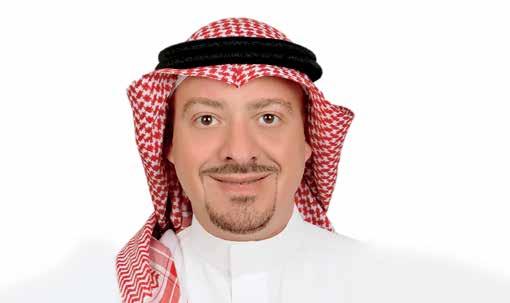
the best services for customers. With demand rising rapidly for employees meeting these requirements, especially in hotels and F&B, the Ministry of Tourism has launched a variety of training programs and continues to do so, in collaboration with top hospitality institutes globally and in the Kingdom. These programs include various levels and pathways to equip Saudi citizens with what they need to form part of the workforce capable of meeting the demands of the market, take the sector forward and thrive. These initiatives are
paving the way for the creation of great jobs and careers for Saudis now and also for the next generations.
The retention challenge
Investing in an employee’s growth, together with wage increments and retention bonuses are effective tools that organizations consider when it comes to employee retention. Retaining employees in the hospitality industry was highly challenging in the past, since most jobs were considered temporary by many jobseekers rather than offering a sustainable career, with interest instead largely focused on other industries such as oil and gas, due to the rapid training and development programs, high wages and incentives offered. With Vision 2030 in place, the Kingdom is now attracting the most renowned hospitality organizations to the market and competing to deliver the best services and experiences for their guests, placing Saudi Arabia among the top tourism destinations. In this context, most hospitality organizations are now focused on developing adequate and fruitful training programs for their staff while continuously assessing their succession planning, which has resulted in a significant boost to employees’ morale and sustainability.
NADINE YETISENER
Vice president, people and culture EMEA

Four Seasons Hotels and Resorts
What recruiters are looking for
We focus on hiring talent with heart; skills can be learned. It is more than simply a matter of choosing the most qualified or most experienced candidates. We typically select people who, while diverse in their backgrounds, experience and skills, share one common quality – a genuine passion for delivering

intuitive service and connecting with others in meaningful ways. Many strong candidates come from other customer service-orientated industries and roles with transferrable skills, while some may have less relevant experience, but are a good fit in terms of attitude and passion for hospitality.
Attracting the new generations
A career in hospitality appeals to the new generation’s sense of adventure and desire to travel. Working in hospitality offers a meaningful way to connect with
others and experience the world. In this industry, we get to make a genuine difference every day. Sometimes, this could be a small gesture of helping people get to a meeting on time − other times, it may be a bigger difference, such as arranging a once-in-a-lifetime experience for a guest. This makes it an attractive choice for young people who wish to make a positive impact on the world and the lives of others.
Hiring hurdles
As we embrace the pent-up demand for travel post-pandemic, we are continuing to address labor shortage impacts. Great progress is being made on this front as we know that the industry provides fantastic opportunities and exceptional career paths. Hospitality often has a reputation for being fast-paced and demanding. Here in the MENA region, we are contributing to an improved work-life balance by shifting to a fiveday week from the industry’s typical six-day working week. When it comes to hiring, the new generation is effectively interviewing us and rightfully so. It is increasingly important among young people to choose to work for a company that aligns with their personal values in areas such as sustainability and diversity and inclusion.
INFLUENCERS BUSINESS
HOSPITALITY NEWS ME | MAY-JUL 2023 40
TAREQ ABDULLAH SAWAN HR advisor, Ministry of Tourism, KSA

THE FUTURE OF TRAVEL IS EXPERIENCE
Michael Donald, co-founder and customer experience specialist at Halo Business Consulting, looks at how travel is evolving in a post-pandemic era, when hybrid working, environmental awareness and a thirst for adventure are among the factors driving destination selection decisions.

As we progress through 2023, it’s evident that a number of travel and tourism trends are evolving in this post-pandemic period, with the common theme of travelers wishing to seek out new and authentic experiences having become a powerful inspiration for travel.
Purposeful travel

The push for more sustainable travel has been gathering momentum for a number of years. However, a new sense of responsibility toward travel has also emerged in a world that remembers, all too clearly, what it felt like to be banned from travel altogether - and even ordered to stay at home - for long periods of time in recent years.
Fewer trips, longer stays: many people are now looking to travel to fewer places and spend longer at a destination, focusing on quality and fully immersing themselves in the location and the people. Hybrid working is allowing us to take longer holidays that are interspersed with working days throughout the trip.
Experiential travel: in a recent survey, 74 percent of Virtuoso travelers said they’re willing to pay more to travel sustainably if they know where their money is going. And 70 percent agreed that traveling sustainably actually enhances their vacation experience. Travelers are seeking out companies and experiences that focus on “benefitting local people and the economy” and “preserving natural and cultural heritage.”
Carbon reduction: the focus on reducing carbon footprint is also evident across the tourism and hospitality industries. Slower train travel is seen as a more sustainable option and there has been an influx of innovative train companies lining up to offer creative and ethical solutions for potential customers to travel with a lower carbon footprint. Businesses that have started programs of carbon reduction are looking to communicate this with potential customers, while accreditations like Green Key are now being recognized by Google and positively affect visibility across search and booking platforms.
TOURISM BUSINESS
42 HOSPITALITY NEWS ME | MAY-JUL 2023
Mixing business with leisure
While business travelers adding a few days of fun at the end of a work trip is nothing new, we are starting to see these travel decisions focused first on the leisure destination, followed only afterward by plans being made to also work remotely from that location. The post-pandemic era of hybrid and remote working is now allowing this to happen from a social and business perspective. Free from pressure to be physically back in the office, employees can spend the morning on a beautiful beach in Thailand before logging in to start work remotely at 9am in Europe.
Set-jetting

While product placement has long been recognized as an effective marketing tool in TV and cinema. Today, places are also an established “product.” Game of Thrones was partly filmed in Croatia and Northern Ireland, with this exposure proving a huge draw for fans when they came to book their next holiday. More recent series, like Emily in Paris and White Lotus, are having a similar effect by boosting bookings for trips to Paris and Sicily, with travelers looking to replicate the experiences of their favorite characters by stepping into their shoes on location.
Adventure travel
When Booking.com recently polled 24,000 customers across 32 countries, almost half of those (44 percent) admitted to looking for holidays with a more back-to-basics feel, while 55 percent sought out “offgrid”, escape-from-reality experiences (55 percent). Even more (58 percent) said they used 2023 as an opportunity to learn survival skills. Perhaps in part taking a cue from the classic coming-of-age movies that Hollywood has provided, adventurous outdoor holidays are undoubtedly having a renaissance. Whether it’s a trip to Disneyland, a waterpark or a magical desert adventure, these holidays are also more likely to include multiple generations of extended family members, with older relatives happy to relive previous experiences alongside children and grandchildren, together with cousins, nieces and nephews.

Hybrid working is allowing us to take longer holidays that are interspersed with working days throughout the trip.
The metaverse and virtual travel
A number of hospitality and travel companies announced moves into virtual real estate, while early experimentations with NFTs and Crypto were taking place. Despite the second half of 2022 being marked by highly publicized losses in this field, there is little doubt that the next generation of the web will offer travel industry players huge opportunities to market their business to prospective customers.
A new kind of all inclusive
Aligned with the adventurous spirit that is a hallmark of the contemporary traveler, the concept of an all-inclusive holiday is now being adapted and tailored to particular lifestyles rather than a generic one-size-fits-all. Moving away from the idea of traditional all-inclusive, which was fast becoming synonymous with “cheap” or “all-you-can-eat”, creative operators are now finding ways to protect their businesses from the increasing cost of living, while continuing to offer great value to their customers in a highly competitive market.
gohalo.co.uk
In collaboration with
43 MAY-JUL 2023 | HOSPITALITY NEWS ME
OMAN: A UNIQUE GEM IN THE GCC

Justin Kenny , consultant at Colliers for the Hotels MENA Region, explains how the sultanate is carving its own identity as an attractive destination with a diverse offering, despite tough competition from its neighbors.
Oman has made substantial investments in its hospitality sector in recent years, with a focus on luxury resorts, eco-tourism and cultural tourism. To date, it has had to contend with fierce competition from neighboring countries, including the UAE and KSA, which have well-established hospitality offerings. However, the sultanate is now focused on establishing itself as a destination in its own right and building on its many strengths, which include stunning natural landscapes, a well-established commitment to sustainable tourism and an ideal geography for multi-location stays.
Post-pandemic project pipeline
Over the past seven years, the Omani hospitality market has experienced consistent growth in quality branded supply. That said, growth was impacted by the Covid-19 pandemic, resulting in lower year-on-year growth from 2020 to 2022 compared to the period 2015-2020. The adverse impact of the pandemic has also led to the delay of several property openings in Oman. Despite these setbacks, Oman’s hospitality market has a healthy pipeline of supply expected to open in the next five years.
Several factors are driving this growth, including the Omani government’s vision to diversify the economy, an increase in disposable income and large-scale masterplan developments. As the global travel industry recovers, Oman is wellpositioned to capitalize on its strengths and attract more tourists to the country.
Oman’s hospitality market has shown steady growth in recent years, with a compound annual growth rate (CAGR) of 9.5 percent from 2015 to 2022. The supply in markets analyzed is expected to continue to grow at a CAGR of 8.5 percent from 2022 to 2027, reaching approximately 19,500 keys by 2027.

Sharper focus on leisure
Approximately 76 percent of identified branded supply in Oman is allocated to the Muscat market in 2022. Data indicates that Muscat achieved a CAGR of 10.3 percent from 2015 to 2022. The market is expected to continue to grow at a CAGR of 9.2 percent from 2022 to 2027, reaching approximately 15,200 keys by 2027.
In terms of inbound tourist trips, Oman welcomed 1.4 million visitors in 2022, an
increase of 305 percent on the previous year. Inbound visits in 2022 were down 38 percent on 2019 figures, with forecasts pointing to a full market recovery, reaching pre-pandemic levels, by 2023. The largest source markets for Oman’s tourism industry are GCC countries, followed by India, Germany and the UK.
In recent years, Muscat has undergone a transformation, moving away from a reliance on corporate and transient demand, and toward becoming an established leisure destination. This shift has been driven by the introduction of new luxury resorts and the opening of the Muscat International Airport in 2018, which have helped to stimulate leisure demand in the market. The development of more leisure-centric developments, in line with Oman Vision 2040, is expected to further increase leisure demand for Oman. Some notable projects include the newly opened Jumeirah Muscat Bay, the upcoming Four Seasons resort and private residences in Muscat, and the upcoming Hotel Indigo in Jabal Akhdar.
COUNTRY REPORT BUSINESS
HOSPITALITY NEWS ME | MAY-JUL 2023 44
Tourism package potential
A unique feature which differentiates Oman’s tourism landscape from the rest of the GCC is the availability of tourism circuits, which are popular among the group leisure segment. These two-tothree-day destination hops enable visitors to experience the country’s diverse geographical features through what is typically provided as a five-to-10-day itinerary. Tourists get to enjoy a range of experiences, including old city tours in Muscat, mountain adventures in Jabal Akhdar, cultural tourism in Nizwa and dolphin watching in Masirah Island or Bandar Al Khayran. While neighboring KSA offers similar circuit packages, Oman's strength lies in activity concentration and relatively time-efficient accessibility between stops. The tour packages in Oman involve journeys that are typically two-to-three-hour drives or 40-60-minute flights from one location to the next.
Differentiation is key
There are several steps Oman could take to further elevate its profile as a destination and boost demand:
Develop authentic experiences: to differentiate itself from competitors, Oman should focus on offering authentic experiences and capitalizing on existing cultural and geographical strengths, such
as its ancient forts, museums and traditional markets. Similarly, Oman’s coastline and mountains provide unique features and landscapes, making it an ideal destination for resorts and hotels. Salalah and the greater Muscat area are the markets offering the greatest beach resort opportunities. Jabal Akhdar and the emerging Jabal Shams are prime mountainous destinations identified for further hospitality development.
Focus on sustainable tourism: Oman has made a high-profile, robust commitment to sustainable development and eco-friendly tourism. By reinforcing these values, it could attract environmentally conscious travelers who are looking for destinations that align with their own beliefs. Developing eco-tourism initiatives that are sustainable and environmentally friendly will generate interest among tourists who are interested in nature-based activities, such as hiking, birdwatching and camping. With easy accessibility to Muscat but still sufficiently distanced from the capital city, Ad Dakhiliya has been recognized as a market offering considerable opportunities to develop eco-centric hospitality offerings. Its diverse landscape combines farmland, elevated deserts and mountains with attractive oases.
Lifestyle hotels: the growing number of Gen. Y and Z travelers offers significant opportunities for urban lifestyle hotels in Muscat and lifestyle/all-inclusive resorts in
Salalah. These demographics tend to prefer urban environments with access to local culture, entertainment and nightlife. Urban lifestyle hotels cater to these preferences by offering stylish and modern accommodation in vibrant settings. Together with lifestyle/ all-inclusive resorts, they represent a unique selling point for Oman’s hospitality industry, which has traditionally focused on luxury beach resorts and corporate city hotels. By targeting the demands of these generations and providing a differentiated offering, providers of lifestyle hotels can attract a new segment of travelers and contribute to the growth of Oman’s tourism industry.
Firm foundations
Oman holds strong hospitality potential thanks to its unique culture, rich heritage, stunning natural landscapes and a pioneering commitment to sustainable tourism. Moving forward, the country looks set to continue prioritizing its unique selling propositions and leveraging its strengths, with a focus on national identity and a diverse, authentic hospitality mantra. Providing authentic experiences rooted in history, while continuing to promote sustainable tourism and creating a new push into lifestyle hotel concepts presents a broad range of opportunities that will support inbound tourism demand, attract FDI to the industry and elevate the overall appeal of the destination.
colliers.com

Oman holds strong hospitality potential, thanks to its unique culture, rich heritage, stunning natural landscapes and a pioneering commitment to sustainable tourism.

1,500 1,800 150 450 150 300 100 2022 2027 (f) Supp y Breakdown 5-Star 4-Star 3-Star SA 200 400 450 650 200 200 2022 2027 (f Supply Breakdown 5-Star 4-Star 3-Star SA 3,850 5,500 3,350 5,500 1,600 2,700 950 1,450 2022 2027 (f) Supp y Breakdown 5-Star 4-Star 3-Star SA Supply Overview Ad Dakhiliya Supply Overview Muscat Supply Overview Dhofar Existing Supply ~850 Keys P peline Supp y ~400 Keys Supply CARG 2022-2027 8 0% Existing Supp y ~9,750 Keys Pipeline Supp y ~5,400 Keys Supply CARG 2022-2027 9 2% Existing Supply ~1 800 Keys P peline Supp y ~850 Keys Supply CARG 2022-2027 8 0% In collaboration with
Note: supply indications have been rounded to the nearest 50. Note: supply indications have been rounded to the nearest 50. Note: supply indications have been rounded to the nearest 50. 1 1 1 1 1 1 1 1 1 2 2 2 1 1 1 1 2 2 2 2 2 3 3 3 3 2 2 3 3 4 4 4 4 5 6 6 7 7 3 4 4 4 5 5 5 6 7 7 7 8 8 6.8 8.0 8.9 9.9 11.0 11.9 12.2 12.8 15.2 16.7 18.0 19.1 19.4 0 5 10 15 20 25 2015 2016 2017 2018 2019 2020 2021 2022 2023 (f) 2024 (f) 2025 (f) 2026 (f) 2027 (f) Number of Keys (000's) Evolution of Branded Hospitality Supply Ad Dakhiliya, Dhofar, and Muscat Governorates Ser vic ed Ap ar tmen ts 3-Star 4-Star 5-Star Tot al 1 1 1 1 1 1 1 1 1 1 1 1 1 1 1 1 1 2 2 2 2 2 2 3 3 2 2 2 2 3 3 3 3 4 4 5 5 6 2 2 2 3 3 4 4 4 4 5 5 6 6 4.9 5.7 6.7 7.4 8.1 9.0 9.2 9.8 11.4 12.5 13.8 14.8 15.2 0 2 4 6 8 10 12 14 16 2015 2016 2017 2018 2019 2020 2021 2022 2023 (f) 2024 (f) 2025 (f) 2026 (f) 2027 (f) Number of Keys (000's) Muscat Evolution of Branded Hospitality Supply Muscat Governorate Ser vic ed Ap ar tmen ts 3-Star 4-Star 5-Star Tot al MAY-JUL 2023 | HOSPITALITY NEWS ME 45
WHY WE’RE STICKING WITH JAPANESE CUISINE

Light, healthy and convenient, sushi unsurprisingly remains a top eating trend internationally, with regional appetite on the rise for sushi and other Japanese dishes. Nada Alameddine, managing partner at Hodema consulting services, tracks both the history of Japanese food and the latest trends, from humble rolls of rice to flavorsome fusion experience.

EYE ON BUSINESS
46 HOSPITALITY NEWS ME | MAY-JUL 2023
When we think of Japanese food, our thoughts immediately turn to sushi. However, these small garnished rolls of rice have come a long way since the 1960s, when nigiri sushi was first introduced to Little Tokyo restaurants in New York. Translating to “sour rice”, due to it being soaked in rice vinegar, sushi can now take all shapes and forms - a far cry from the strict Japanese traditional recipes that are sashimi, nigiri, chirashi, maki and temaki. The dish is now one of the top eating trends and has established itself as a classic meal option for many across the globe.

The sushi takeover
And it looks set to remain so for the years to come, since sushi ticks all the new eating habit boxes. First, it’s light and healthy, offering a great diet option for those avoiding fat, sugar, processed food and gluten. The only fat is from the seafood, with sugar coming from the teriyaki sauce, which is optional. Another plus is the ease with which sushi can be eaten. Suitable for eating at a restaurant table, an office desk or on a park bench, varieties are usually sold in boxes with disposable sticks, which is just what busy workers need. Sushi also adapts to all types of budgets, since it is usually sold in sets or pairs. In addition, it is the ultimate delivery meal, since there’s no risk of it getting cold on the way.
Sushi should benefit from the exponential growth of the online delivery and takeaway market - an industry on course to reach multimillion-dollar levels in the coming years. All these factors combine to make sushi the ultimate fast casual-eating option in many countries.
Regional appetite
Food and beverage investors have been immersing themselves in the sushi business for many years now, building successful chains across the globe, such as Genji and Ace Sushi in the US, YO! Sushi in the UK, Sushiro in Japan and Sushi Shop in France. Some have expanded their business in the Middle East, such as YO! Sushi, which can be found in the UAE, KSA and Bahrain. Even if some of the ingredients are not always available for chefs, the region has become home to a large offering of outlets, benefiting from demand from expatriates in the emirates and a steady fan base in Kuwait, Saudi Arabia and Egypt. Mori Sushi has opened several branches around Cairo, in Alexandria and on the coastal route, while Sushi Ko is well established in Lebanon. The first Japanese restaurant in Saudi Arabia dates back to 1985 and, since then, numerous establishments have popped up across the country, including Sushi Yoshi and Samurai. The Kingdom even boasts its first local sushi chef, Khulood Olaqi, who runs Oishii Sushi in Riyadh. The conveyor belt concept that has taken over the sushi world has also found its habitués across the region.
As the ultimate delivery meal, sushi should benefit from the exponential growth of the online delivery and takeaway market.

When tradition meets fusion
But of course, Japanese food is certainly not limited to sushi. The cuisine is varied and complex, mixing ingredients with exotic flavors and names, such as shirako (fish prostate) and nama tamago (raw eggs). Japan has opened its doors wider to tourists in recent decades, allowing us to discover a range of local delicacies, many of which are foreign to our western or oriental palates. The milder options, such
as udon noodles or deep-fried meats, have traveled to our plates, thanks to fusion restaurants. Nobu, the celebrity chef who owns outlets in the US, Canada, across Europe and in the UAE and KSA, has made high-end Japanese cuisine a trend. Many have since followed suit, with Japanese and foreign chefs experimenting with traditional and fusion ingredients. Dubai has been the mecca for Japanese cuisine in the region for some time, but KSA is now quickly catching up as the country is boosting its leisure and tourism industry. This boom in Japanese establishments in the region can be seen through the Middle East & North Africa’s 50 Best Restaurants’ awards, held in Abu Dhabi in January. The list of nominees shows that traditional Japanese dishes are on the rise, fusion experience is on trend and sushi artistry is a must-see. It is clear that Cairo should no longer be considered a second-class dining spot, with fine Japanese cuisine now available in the city. A new entry at No.50, Bonjiri was launched by Maryam Alnusif in Salmiya in Kuwait. Then, moving up, we find Reif Kushiyaki in Cairo and Dubai, Zuma in Abu Dhabi and Dubai, Hoseki in Dubai (with its sushi master and only nine seats), Myazu in Riyadh and Kazoku in Cairo.
More in the making
But Japanese cuisine aficionados needn’t worry since there are more flavors on the way. In New York, Kimika restaurant is already causing a stir with its “Itameshi” concept, a surprising mix of Italian and Japanese dishes. The menu offers Cavatelli pasta with a pork ragu, studded with edamame and a dollop of burrata; and a Japanese curry arancini. Vegan sushi options are also ones to watch, with the American chain Whole Foods Markets now selling Kikka Sushi’s vegan tuna and salmon sushi varieties made out of konjac root, which mimics the taste and texture of raw fish. Vancouver-based Konscious Foods is also offering frozen plant-based sushi and onigri. For sit-in options, vegan sushi bar Kusaki in west Los Angeles and New York’s Shojin are already both serving plant-based omakase. hodema.net
In collaboration with 47 MAY-JUL 2023 | HOSPITALITY NEWS ME
IS F&B OUTSOURCING ON ITS WAY OUT?
Ralph Nader, CEO of Amber Consulting, charts the growing trend among hotel owners to take back their F&B offering inhouse and highlights the benefits of doing so, which include regaining control in key areas and opportunities to increase profits.

For most hotel owners, outsourcing F&B operations was traditionally a no brainer. Given the high level of expertise required and the low profit margin associated with the F&B industry, the advantages of outsourcing far outweighed the benefits of putting in the work to create a homegrown concept. Retaining the services of an F&B operator meant that hotel operators could focus on other outlets and services, while leaving the hassle of F&B capital expenditure and payroll to successful regional and international brands with exceptional freestanding concepts. However, times and trends are changing worldwide, including in the Middle East, as our research shows.
The outsourcing vs. inhouse F&B question is particularly important to industry players in the Middle East, given that revenues from hotel restaurants in the region have always made up a larger portion of hotel income compared to their counterparts in the US and Europe. Back in 2014, STR Global reported that hotel F&B in the region totaled 37 percent of hotel revenue, with an estimated 5-10 percent growth annually, compared to the approximate hotel F&B revenue of 25 percent globally. Today, in the postpandemic era, the Middle East’s growth is at a nascent stage, with F&B revenues its strong suit, as Marriott’s CFO pointed out in 2021 in an interview.
A change of tack
A shift is underway in the strategic approach being adopted by hotel owners, from an automatic outsourcing tactic to a more calculated decision, weighing both in-house and outsourcing options. Against this backdrop, there is also a rising awareness that in-house F&B operations can help to drive hotel revenue growth.
The benefits of outsourcing are well known and well documented, studied extensively over the years by industry experts. Increasing the bottom line with minimum effort, while making the maximum potential profit from a recognized regional or international F&B brand, was almost always the preferred scenario and understandable, since potential profit wasn’t adding up to a worthwhile total for hotel investors. However, several factors are now generating a shift in strategic approach:

• Restaurants have begun to prove profitable in recent years, as attested by the surge in F&B management companies now capitalizing on opportunities. The F&B industry emerged a star performer from the pandemic, as demonstrated by the countless innovations on the F&B scene, from food delivery and home-cooked meals to several revitalized and adapted concepts.
• Consumer trends have been increasingly shifting toward experiential outlets. This includes omnichannel and immersive experiences, with augmented reality (AR) and hyper-personalization now added to the mix.
• Competition in the hotel industry is still increasing, bringing with it an urgency around the need for differentiation. F&B segments hold the key to enhancing a hotel’s value proposition.
Having noted how well restaurants performed during tough economic times, hotel owners are reconsidering their strategies for F&B, and increasingly deciding to make them an essential component rather than an ancillary or additional one. Significantly, they are also now viewing them more and more as a customer acquisition channel in their own right.
The question hotel owners are asking is: why outsource, when I can keep my operations inhouse and put extra effort into building a more coherent and more differentiated hotel brand identity through F&B offerings?
F&B BUSINESS
HOSPITALITY NEWS ME | MAY-JUL 2023 48
Driving hotel revenues from inhouse F&B
The main disadvantage of outsourcing F&B was the limited involvement it gave hotels in the area. Owners traditionally lost control of product quality and felt excluded from influencing strategic decisions and creative involvement and marketing – disadvantages that sometimes proved to be significant and were often underestimated. In fact, keeping operations inhouse can allow hotel owners to increase their RevPaR in several ways, including:
Collecting F&B data: F&B data is crucial to obtain an exhaustive figure of guest spending. Limited involvement in F&B means less data is being shared with hotel stakeholders. A business needs a complete picture of its customers' activities to use it to its advantage. Only then can it make tweaks to the customer journey and introduce key adjustments through its marketing channels.
Maintaining and harnessing the advantages of creative control: as the region enters a period of post-pandemic growth, it is important to recognize that expansion is synonymous with change. Businesses will need to continue navigating uncertainty and respond swiftly to changing consumer needs and trends. Keeping their F&B operations inhouse will allow them flexibility when it comes to adapting their offerings without clashing with a third-party strategy that they might not agree with.
Offering guests a seamless experience: retaining the services of an international F&B brand can undoubtedly bring with it prestige by association. However, coming up with innovative and unique concepts creates a power balance and can also give stature to the owner of the original idea when smartly executed. When outsourcing, space is usually rented to the operator, thereby restricting dining in an area of the hotel. Transforming corners of a hotel into F&B spaces can prove to be a more efficient strategy, creating a smooth and uninterrupted experience for the guest, while also increasing F&B spending. Bringing these ideas to fruition is easier to do internally, since franchises and full-grown brands already have welldefined offerings, with little or no room for flexibility unless they make changes to their brand identity.
Adopting this strategy also paves the way to develop group sales as an additional revenue stream, such as corporate or personal events. These are key elements in upscale hotels and, for planners who are choosing between event spaces that are similar in terms of location and price, F&B can easily become the deciding factor.
Transforming corners of a hotel into F&B spaces can create a smooth and uninterrupted experience for guests, while also increasing F&B spending.

Weigh the pros and cons
Opting to keep F&B operations inhouse is far from challenge free for hotel owners, with lack of expertise an area of weakness that often caused problems in the industry. Decisions need to be made carefully and should be determined by each individual hotel’s specific business needs, taking account of the broader economic situation. Longer-term objectives should be reconciled with the hotel’s shortterm needs, with any moves made well calculated rather than based solely on profitability. However, there’s no doubt that by taking responsibility for this area of the business, hotels have the opportunity to create exciting alternative experiences for their guests and meet demand for something different, while unleashing F&B’s potential as a profit center.
amber-consulting.com

In collaboration with
MAY-JUL 2023 | HOSPITALITY NEWS ME 49
WHAT DO GUESTS REALLY WANT?
Today’s travelers have diverse wish lists when planning their trips, featuring ‘must includes’ that range from eco-conscious, locally focused stays and wellness experiences that go beyond spas to loyalty programs and apps to make quick, easy bookings. With a list of his own at the ready, Jad Shamseddin, COO of Aleph Hospitality, shares his thoughts on the criteria motivating guests in 2023 and what hotels need to do to attract them.


It's essential for an operator to understand what motivates hotel guests if they are to provide them with the best possible experience.
As a starting point, a hotelier needs to have some knowledge of a guest’s lifestyle, which will enable operators to craft a genuinely personalized experience, tailored to the needs and preferences of each individual. Key lifestyle factors that may influence a hotel guest’s stay include travel purpose, age, dietary needs, fitness and wellness expectations, technology, environmental awareness and cultural interests.
In today’s world, it’s crucial for hotels to use AI and machine-learning algorithms to analyse guest preferences and behaviors, and offer targeted recommendations for activities, dining and entertainment options. Creating these personalized experiences will help to increase guest satisfaction, drive loyalty and generate positive reviews.
Some of the most common motivators for hotel guests include:
1. Comfort and relaxation: above almost all else, guests are looking for a relaxing, enjoyable stay. Comfortable beds, clean rooms and amenities, such as spa services and pool areas, all help to create a satisfying experience.
2. Convenience and accessibility: guests want a hotel that is in a convenient location and easily accessible, close to public transportation, restaurants and other attractions.
Creating personalized experiences will help to increase guest satisfaction, drive loyalty and generate positive reviews.
3. Advanced technology: in our tech-driven world, guests expect hotels to provide high-speed Wi-Fi, voice-activated room controls, virtual concierge services and contactless check-in and check-out. Hotels need to be using data and technology to anticipate their guests’ needs and provide customized services and amenities. Guests will also expect hotels to offer mobile apps or other digital tools that allow them to access information and services quickly and easily, whether to contact housekeeping or room service, or find hotel facilities and make bookings at outlets or spas.
4. Cost and value for money: with increases in the cost of living a topic of debate worldwide, value for money is likely to be high on the agenda for visitors. Guests want a hotel that provides competitive, clear pricing and no hidden fees.
TRENDS BUSINESS
HOSPITALITY NEWS ME | MAY-JUL 2023 50
5. Personalized service: guests like to feel special and appreciated during a stay. Operators should be prepared to offer a personalized service, remembering a guest’s preferences and providing bespoke recommendations. Data will facilitate this, making available individual details, such as room temperature and bedding preferences, alongside food and beverage choices.

6. Safety and security: high on any guest’s priority list, this includes having secure access to their room, safe storage for their belongings and seeing visible security measures in place. Visitors also expect hotels to prioritize health and safety in our post-pandemic world. This could include measures like contactless check-in and check-out, enhanced cleaning and disinfection protocols, and access to health and wellness facilities.
7. Loyalty programs and rewards: these have long appealed to visitors, especially programs that offer rewards and benefits for repeat business. However, beyond earning points, today’s guests also want to be able to manage their loyalty program rewards and redeem points directly from a user-friendly app that gives them full control.
8. Sustainability: increasingly aware of the environmental impact of travel, guests are looking for hotels that prioritize sustainability and eco-friendly
operations and practices. They expect hotels to adopt sustainable practices, such as reducing waste, especially plastic, conserving and using renewable energy, and using eco-friendly and locally sourced materials and products.
9. Unique experiences: many guests are motivated by authentic experiences, such as staying in a historic building or participating in local culture and heritage events. Hotels can tap into this by offering unique activities and events that showcase the local area.
Research indicates that guests have also increasingly sought out one-of-a-kind, memorable experiences beyond the traditional offerings provided by hotels in recent years and chosen their place of stay accordingly. These include:
1. Culinary experiences: many hotels now offer unique dining experiences, such as farm-to-table meals, cooking classes with renowned chefs and wine tastings.
2. Wellness programs: guests are often looking for services that go beyond spa treatments, such as yoga and fitness classes, and meditation sessions.
3. Adventure activities: hotels located in scenic areas are now offering a variety of adventure activities, such as hiking, zip-lining, mountain biking, skiing and water sports.
4. Cultural experiences: varying from guided tours of historical sites and art and craft workshops to music and dance performances, these enable guests to immerse themselves in the local culture.
5. Eco-tourism: hotels are incorporating an environmentally focused element into their offerings through activities such as birdwatching, jungle treks, nature walks, history tours and wildlife safaris.
6. Personal development: increasingly popular, these can encompass workshops on mindfulness, leadership and creativity, among other topics.
7. Unique accommodation: for guests looking for something other than four walls, operators have taken to providing more unusual places of stay, such as treehouses, igloos and yurts, to give travelers a one-of-a-kind experience.
8. Volunteering experiences: there are opportunities for hotels to enter into partnerships with local organizations to offer visitors volunteering experiences. These can include beach cleanups, work at animal sanctuaries and community service projects.
In an era when demands are high and trends are constantly evolving, hotels need to stay ahead of the curve and display the ability to adapt to changing guest expectations. Those that can provide exceptional personalization, innovative technology and sustainable practices, while maintaining high levels of cleanliness and safety, are the most likely to succeed in attracting and retaining guests.
alephhospitality.com
In collaboration with 51 MAY-JUL 2023 | HOSPITALITY NEWS ME
The past two years have brought about sweeping changes in global consumer spending trends, forcing industries across the spectrum to reinvent their strategies at a matching pace to meet the converging needs of consumers and their own fiscal targets.
Dark kitchens

According to a recent report from our research partner Mintel, consumers, after having put their own needs on the back burner to prioritize public health and safety, are now emerging from the pandemic keen to re-focus on themselves, and brands will need to help them take center stage in the years to come.
For consumers who have gotten used to ordering online from the comfort of their homes and getting everything delivered in no time, convenience is paramount. As restaurants seek to find ways to offer their delivery customers the experience and levels of service they expect, one of the key developments in the supply chain domain has been the proliferation of dark kitchens. In the UAE, hybrid, delivery-focused dark kitchen operators are transforming the F&B delivery scene. Brands such as Kitopi, Kitchen Nation, Kitchen Park and Kitch have found great success and are in the process of spreading their networks even further to cover most of Dubai’s population. As the rise of such hyper-local fulfilment channels poses a potential and pertinent threat to conventional restaurants, operators should consider devising creative strategies to be part of this model rather than try to compete with them. Apart from joining hands with delivery services and their dark kitchens, restaurants would also do well to adopt dark kitchens of their own by setting aside some space in their kitchens and focusing on making quick deliveries to their marketplace customers. Another scenario is for a hotel or restaurant with an under-utilized kitchen to collaborate with a dark kitchen platform and let them run their operations from this kitchen or a part of it.

CONSUMER TRENDS THAT THE HOSPITALITY INDUSTRY CANNOT AFFORD TO IGNORE
In today’s operating environment, pivoting from an established business model and adapting marketing tactics to accommodate new trends are a must.
Vineetha Sony, Head of Trade, OCO Global, explains why acting on consumers’ changing tastes, preferences and needs is essential for both success and survival.

Health, wellness and sustainability
Consumers are also becoming increasingly particular about health and wellbeing. The proliferation of health and lifestylerelated information and awareness during the pandemic has transformed the way consumers look at food and nutrition, including the way food and beverages are packaged. This has compelled fast-moving consumer goods (FMCG) companies to address how they present and package their products while also considering and possibly changing the materials they use in them. Increasing consumer demand is pushing brands to use more cruelty-free or vegan ingredients in food as well as cosmetics and cleaning products.
With sustainability one of the key trends set to drive most sectors in the coming years, making the transition from single-use toiletry amenities to reusable or plantbased ones is another essential move for hoteliers. The challenge of a certain section of customers still viewing single-use toiletry amenities as an indicator of luxury remains. However, this can be worked around with the help of clear messaging that conveys the fact that the use of these alternatives is a responsible initiative and not a costcutting measure.
Most studies on consumer trends show that shoppers are likely to buy from a brand that demonstrates social responsibilities and prefer to be associated with companies or brands that align with their values.
Localism and social responsibility
Most studies on consumer trends show that shoppers are likely to buy from a brand that demonstrates social responsibilities and prefer to be associated with companies or brands that align with their values. In the same Global Consumer Trends 2023 report, Mintel states that over the next two years, consumers will continue to grow more connected to their local environment as the world faces rising geopolitical and financial insecurity. In this context, both international and local brands could benefit from collaborating with local businesses and coming up with schemes to support the specific needs and behaviors of local communities. Global brands can capitalize on this trend by highlighting how their local sales and profits are being used to improve the community in which they are present. Diversified sourcing
Brands will also have to re-evaluate their supply chains and reliance on other countries due to global uncertainty. While this does not mean global supply chains will cease to exist, global brands must expect increased scrutiny by customers on whether they take their local commitments seriously.
From dark kitchens and sustainable practices to localism, wellness and supply chain reevaluation, the combination of factors that are driving change in the consumer goods industry is extensive. For hospitality industry players, having a finger on the pulse of the market’s direction and a willingness to alter established business models and marketing tactics to suit the shift in trends matters more than ever before in today’s operating environment.
ocoglobal.com

TRENDS BUSINESS
In collaboration with HOSPITALITY NEWS ME | MAY-JUL 2023 52



www.wtm.com/atm/hospitality Part of: Destination Partner: Official Partners: Working Towards Net Zero DUBAI M on 1 - Thu 4 May 2023 #ATMDubai
MODERN DESIGN MEETS TRADITIONAL LIVING
Rabih Geha, founder of Rabih Geha Architects, offers his perspective on blending contemporary and longstanding elements to create timeless, awe-inspiring spaces, brimming with appeal and authenticity.

As the world continues to modernize, it is all too easy to overlook the timeless allure and significance of traditional design. However, there is a burgeoning movement in design and architecture in hospitality that seamlessly melds contemporary and traditional elements to create mesmerizing spaces that leave an indelible impression.
At Rabih Geha Architects, we translate this trend through the utilization of local craftsmanship and antique pieces, blending traditional and modern architectural elements, using natural materials and bespoke furniture, giving a contemporary twist to traditional components and integrating the outdoors.
The riveting juxtaposition of modern and traditional design is also apparent in our residential projects, whether in restoring historic mansions or creating modern homes that are imbued with the charm and elegance of traditional architecture.
Ultimately, lacing modern design with traditional living not only honors and celebrates cultural heritage, but also accommodates the needs and expectations of contemporary lifestyles.
Artisanship, artistry and antiques
Incorporating local craftsmanship and antique pieces is a highly rewarding strategy to achieve a perfect mix of modern design and traditional architecture.
For Nisrine restaurant, the chic Lebanese eatery in Qatar, we paid tribute to Lebanese artisanship and architecture by sourcing furniture, lighting, flooring and accessories from reputable Lebanese brands and manufacturers known for their traditional artistry and designs, such as Maison Tarazi and Nada Debs. This provided the space with an authentic appeal that accentuated the desired mood of warmth and nostalgia.
A parallel approach was taken with the restoration of M House, a 19th-century Lebanese mansion, where we meticulously preserved as much of the original aspect of the property as possible. To ensure the continuity of its ancient aesthetic, we sourced new tiles from 19th-century properties to replace those that were too damaged to salvage. These new tiles were then meticulously cleaned, polished and seamlessly integrated with the original flooring. This emphasis on traditional craftsmanship imbued the interiors with an unmistakably traditional atmosphere.
Antique furnishings, such as a stunning mother-of-pearl chest of drawers, tables, mirrors and grand crystal chandeliers from the client’s personal collection were carefully retained to add a sense of history and elegance to the overall design.
Old meets new
Preserving a two-century-old Lebanese property, while integrating modern amenities, was no easy feat, but the restoration of M House is a testament to how traditional architecture can be seamlessly melded with contemporary living. The aim of the four-year-long project was to modernize the property’s basic functions, while retaining its traditional character, and the result is a stunning blend of old and new.
We took great care to ensure that the mansion’s historical and cultural significance was safeguarded. This meant stripping bare all four façades of the property to remove any mechanical, electrical or structural fixtures that detracted from its original charm. The first and second floors were expanded to increase the living space and an elevator shaft was added, connecting the first to the first-floor mezzanine.
A decaying structure on the east side of the property was demolished to make way for a new multi-level car park and a fresh canopy connecting the residence to the new parking annex was added.
The white cantilevered steel beams of the new parking annex were designed to visually integrate with the main architecture, while remaining structurally independent from the residence’s façade.
ARCHITECTURE AND DESIGN BUSINESS
HOSPITALITY NEWS ME | MAY-JUL 2023 54
In collaboration with
The beauty of bespoke
Achieving a perfect union between traditional architecture and modern living requires a delicate balance which can be realized through the use of natural materials and bespoke furnishings.





Nisrine restaurant beautifully exemplifies this fusion with the careful curation of furniture and materials. Custom-made pieces that incorporate traditional motifs, patterns and colors, and natural materials, such as wood and marble, lend the space a distinctly traditional, Mediterranean atmosphere, accentuated by bespoke contemporary lights affixed to the vaulted ceilings. Meanwhile, at M House, the use or reuse of natural materials was crucial to maintaining the authenticity of the 19thcentury mansion. White Carrara marble in the guest bathroom and internal staircase, original stone molded architraves, handcarved railings and sandstone walls are used throughout the property, while custom-made furniture like marble consoles and a modern dining table enhance the mansion’s lofty interior.
All about interpretation
The combination of traditional architecture with modern living can be further achieved by reimagining traditional elements. For Nisrine restaurant, where we aimed to create a visual representation of nostalgia and family traditions, we incorporated towering, white-washed and arched ceilings typical of old Lebanese architecture.


C House, a three-story residence nestled in the mountains of Lebanon, similarly features a traditional façade with triple arcades, which inspired much of the interior design. To create a contemporary interpretation of these traditional elements, we paired the façade with modern interiors and a patchwork of elegant and contemporary furnishings. A tubular ceiling, painted in black, and a hardwood runway were installed to further accentuate the contrast between old and new and to connect both ends of the reception area.
Bringing the outdoors indoors
The integration of the outdoors can be an effective way to marry traditional architecture with modern living. For example, with Nisrine restaurant, the aim was to capture the essence of family gatherings and childhood memories while providing a contemporary dining experience. To achieve this, we chose to feature the Nisrine wildflower, commonly found in the lush gardens of the Mediterranean, and transplanted it to Doha. To bring our vision to life, we turned to de Gournay, renowned for their hand-embroidered and handpainted wallcoverings, who rendered the wild Nisrine flower atop a metallic red background, surrounded by olive and citrus trees, and the serin bird, using coats of pomegranate-colored pigment over silver-gilded paper.
rabihgeha.com

The integration of the outdoors can be an effective way to marry traditional architecture with modern living.
C House Lebanon
C House Lebanon
C House Lebanon
Nisrine Restaurant Qatar
M House Lebanon
M House Lebanon
MAY-JUL 2023 | HOSPITALITY NEWS ME 55
M House Lebanon
FOUR TECH TRENDS THAT ARE SHAPING THE NEW TRAVEL ERA
With travel worldwide in the midst of a resurge following more than two years of global uncertainty, travelers have understandably developed high expectations for their long-awaited trips. Joy Ghosh, head of commercial, hospitality, Indian Subcontinent, Middle East, Africa and Turkey at Amadeus, explains how tech innovations are enhancing the travel experience in 2023.
At Amadeus, we see four powerful trends emerging that will impact the travel industry over the coming months in unique and innovative ways.

1. New experiences in a new universe
Perhaps the most significant of these trends is the evolution of the metaverse, a term which, for some of us, may conjure up images of simulated worlds visited through gaming or other virtual reality platforms. In 2023, however, the metaverse – the merging of virtual, augmented and physical reality – will influence many aspects of our everyday lives, including the ways in which we fulfill our travel dreams. Through virtual tourism, travelers will be able to enjoy deeper, sometimes more exciting cultural experiences, such as virtual concerts and exhibitions or 3D virtual theme park visits or cruises.
Technologies such as those developed by Amadeus’ Airline Digital Innovation team, which allow people to get a complete idea of a travel experience before they actually buy a ticket, are among the latest trends. People will no longer have to rely on search engines for travel ideas – instead, thanks to conversational AI, they can obtain personalized travel inspiration.
2. Data as a cornerstone for strategic growth
The most valuable commodity for hoteliers in this day and age is, undoubtedly, data. Knowing how to use it to drive demand, understand trends and stay ahead of the competition is critical for those who intend to develop strong revenue strategies. For this reason, it’s essential to have a hospitality business intelligence suite (software solution), such as Amadeus Hotel Business Intelligence Solutions, which can give decision-makers a complete overview of rates, occupancy and distribution trends, allowing them to develop creative media plans, support sustainability measures
and maximize the value of each traveler. Forward-looking data, including on-thebooks occupancy and rate information, will enable hoteliers to easily maximize opportunities and build the right strategies at the right time.
Integrating biometrics into the hotel’s management system improves convenience and efficiency for guests, while also providing opportunities to enhance security and create smoother overall operations.
3. Biometric solutions for a smoother experience

Biometrics — fin-tech (financial technology) solutions of voice, fingerprint, handprint or facial recognition payment systems — have been with us for a while. However, these solutions have recently undergone a significant development within the travel industry and beyond, driven by a demand among travelers for smoother and more secure payment experiences and faster, more streamlined processes during trips, such as when checking in at a hotel or airport, or using rental car services. Against this backdrop, biometric solutions have become a critical facility at airports, offering touch-free and stress-free touchpoints for customers, including bag drop, security and lounge access. Cameras located at each stage of a traveler’s journey through the airport ensure a safe endto-end experience for the passenger. The same goes for Departure Control Systems (DCSs), where they enable better connectivity between airports and airlines, which, in turn, improves airport operations by enhancing security and increasing passenger-handling capacity.
4. Hospitality also stands to benefit Biometric applications are also making their presence felt in hospitality settings. When hoteliers integrate biometrics into the hotel’s management system, they not only improve convenience and efficiency for their guests, but also provide opportunities to enhance security and create smoother overall operations for the business. Casinos, restaurants, theme parks and other entertainment venues are also recognizing the benefits of biometrics, developing solutions that provide access to certain areas and identify guests, linking visitors to tickets, events or reservations.
Innovation is helping to create a bright outlook for the industry in 2023. The more hoteliers are able to incorporate these new trends and technology solutions into their overall business plans, the better off they will be in terms of delivering memorable experiences and preserving the loyalty of their customers.
amadeus.com
TECHNOLOGY BUSINESS
HOSPITALITY NEWS ME | MAY-JUL 2023 56
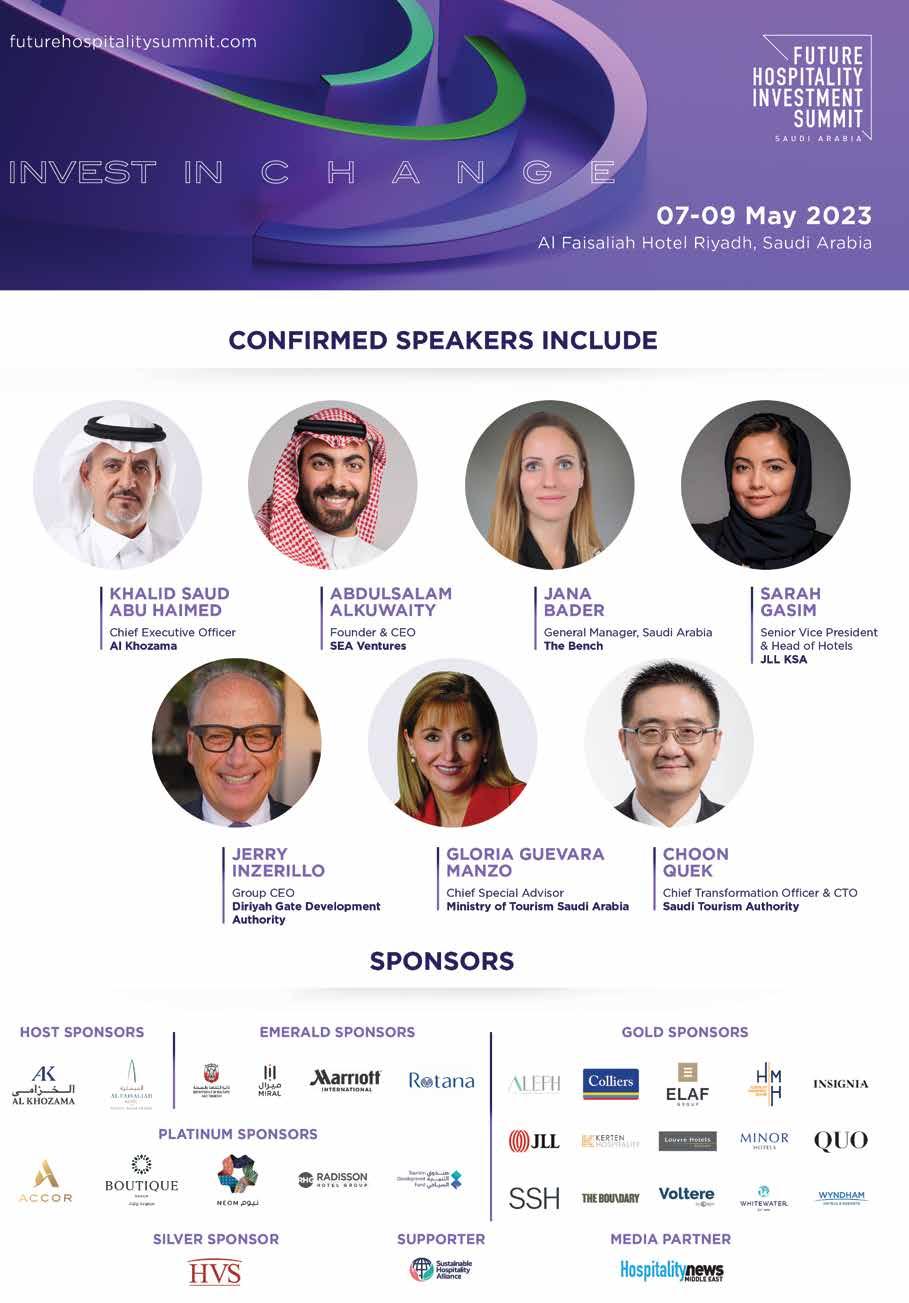
One of the key areas of building a great working environment is to grow a team with a gender balance that is equal and fair throughout the entire organization. While women make up as much as 54 percent of the hospitality workforce, according to a World Tourism Organization report published in 2019, they are frequently to be found in lower paying and less prestigious roles, such as housekeeping and food service. According to the report, this gender gap is evidenced differently in various regions, Africa and Asia scoring higher, and Europe and the Americas lower. The gender gap is not only about having a numerical balance of men and women in the workplace, it is also about ensuring that women are fairly represented in leadership and executive roles, and that their pay reflects the responsibilities that they carry, rather than based upon gender.

While this may look like a reasonably easy problem to solve, it has many important elements that must be considered if support is to be provided to women as they participate in leadership.
Equal pay: this is the easiest of the challenges to overcome and can be done at the stroke of a pen. Implement a policy of pay grades and apply it equally to all, no matter the gender of the holder.
CLOSING THE GENDER GAP
Work still needs to be done to ensure that women are represented in higher-grade roles and remunerated accordingly, as Mark Dickinson of DONE! Hospitality Training Solutions points out.

Equal HR and hiring policy: ensure that the HR team are fully conversant with an equal opportunity hiring policy based upon ability, experience and qualifications, and not on any biases toward any particular group.

As we seek to close the gender leadership gap, flexibility will remain a key word, allowing leaders to be creative in fulfilling their obligations.
Help out with the difficult stuff: raising a family and running a business are both exceptionally challenging occupations and combining the two creates specific problems that few workplaces are ready to address. The most obvious one is childcare. Creating childcare facilities or provisions for parents is a necessity for allowing top performance. A distracted mind benefits no one and creating a support system benefits everyone. Parental leave for either gender plays an important role in closing the gender gap as you may employ one half of the equation, while the
other parent may be working somewhere else, requiring them to carry the family duties in support of their partner.
Support flexible working patterns: work from home and work flexibility became the norm during the Covid-19 pandemic and businesses were able to function in different ways, while facing the challenge of personnel not being present in an office all the time. As we seek to close the gender leadership gap, flexibility will remain a key word, allowing leaders to be creative in how they fulfil their obligations.
Offer learning opportunities: training, mentoring and coaching all play a significant role in creating excellence in the workplace. It is essential that women and men are given equal and fair access to learning opportunities and are provided with powerful mentors and coaches, with the specific objective of advancing their growth within the organization to assure greater business success.
Current leadership within the industry must resolve to take personal responsibility to address gaps through an individual commitment to building exceptional companies that are led by a fair representation of men and women at all levels of their organizations. done.fyi
HUMAN RESOURCES
In collaboration with
SOLUTIONS 58 HOSPITALITY NEWS ME | MAY-JUL 2023
MANAGEMENT
WHY EMBEDDED INSURANCE IS ON THE RISE

Embedded protection products are proving increasingly popular among customers in the post-pandemic travel revival. Peter Smith , vice president, Strategic PartnershipsTravel, EMEA, at Cover Genius, outlines the reasons.
Travel is quickly reaching pre-pandemic levels, faster than anticipated. According to the UNWTO’s World Tourism Barometer, international tourist arrivals could reach 80 percent to 95 percent of pre-pandemic levels in 2023, with the Middle East seeing the fastest recovery. Arrivals have already climbed to 83 percent of pre-pandemic numbers.
That said, travelers’ needs have evolved, as have the options for how companies respond to their constantly changing needs - especially in the travel and hospitality sectors.
Customer expectations are changing Today’s digital-savvy travelers have higher expectations. They are increasingly looking to the brands they trust for more relevant, convenient and cost-effective protection, avoiding the second step of seeking out protection from other sources. They want transparency and convenience from the get-go, including embedded protection for their flight, accommodation, products, events and services.
For example, the recently released 'Refund Protection Report,' conducted by Momentive.ai and commissioned by Cover Genius, found that consumers booking travel who are offered ‘Cancel for Any Reason’ (CFAR) protection are highly likely (60 percent) to make the purchase, more so than if they are offered a more limited refund protection option, or no protection at all. Travelers that purchased CFAR protection are also more satisfied with their experience, reporting a 12-point increase in average Net Promoter Score (NPS).

Providing protection
Overall, traditional insurers have let travelers down during the pandemic. In the Embedded Insurance Travel Report, conducted by Momentive. ai and commissioned In Cover Genius' 'Embedded Insurance Travel Report,' 20 percent of global customers who made a claim for pandemic-related reasons were not covered, despite purchasing travel insurance for pandemic protection. As such, the demand for more relevant embedded protection products has risen significantly as the industry emerges from the pandemic. Companies wanting to provide a better, more convenient service need to ensure their customers are protected for the right reasons. Insurtech can help travel brands achieve this with easy-to-understand policies that can be bundled or unbundled, at optimal pricing and using automated claims processes with instant claim payments that support them when things go wrong.
Whilst the travel and hospitality industries have been embedding protection for many years, there are still opportunities for businesses to enhance the customer experience. By working with partners that share their focus on customers and have the ability to continue to innovate, they can offer more relevant solutions.
Insurtechs offering embedded protection understand that customers likely want their entire service to be intuitive and online.
Being customer-centric
Customer sentiment toward travel protection has generally skewed negatively, based on their experience with the claims process. Increasingly, customers look for clarity, ease of use and quick resolutions, resulting in a higher level of service and post-claim NPS (Net Promoter Score).
Part of being customer-centric, means focusing on the customer experience from end to end. Since customers today are much more digital, their claims process should also be digital-first. For example, insurtechs offering embedded protection understand that customers are part of the digital ecosystem and likely want their entire service to be intuitive and online. More importantly, the embedded solutions being offered also need to be understood by the customer and relevant at the point of purchase.
AI, NLP and big data

The travel and airline industry is tied to a lot of legacy technologies that are still full of pain points. Insurtechs help travel brands modernize their offerings with AI and Natural Language Processing (NLP) to provide tailored products relevant to customer needs. The data captured at points of purchase are integral to this process.
Overall, the travel industry has realized the need to make it easy for customers to purchase relevant products that offer the right protection, at the right price. There is no magic ingredient that gives customers everything they want, but transparent, relevant offerings in a convenient package can give them just what they need.
covergenius.com
In collaboration with MAY-JUL 2023 | HOSPITALITY NEWS ME 59
COFFEE CULTURE MUCH MORE THAN A QUICK CAFFEINE FIX
Coffee as a gesture of hospitality and essential component of social gatherings may date back centuries, but this staple beverage has certainly moved with the times, which may well help to explain its unwavering popularity across both continents and generations. While the region’s modest, unassuming street cafés continue to attract loyal customers with a strong Arabic coffee, global giants and successful homegrown outlets are drawing in the younger generations looking for exciting new creations, such as nitro cold brew and infused espressos, and remote workers grabbing lunch. The options available vary greatly, but one unifying thread is the sharp focus on sustainability at each point in the journey, from bean to cup.
Our Special Report highlights the trends, talking points and topical issues relating to what remains the region’s undisputed favorite drink.
FEATURING
P.61
WHY HYBRID COFFEE SHOPS ARE A WIN-WIN
P.62
THE GULF COFFEE TAKEOVER
P.64
WAKE UP AND SMELL THE COFFEE
P.66
WHAT’S BREWING ACROSS THE COFFEE MARKET
P.70
WHAT’S MAKING WAVES ON THE GREEN COFFEE SCENE

P.72
WHY COFFEE SHOPS ARE CAUSING A STIR
P.74
ALL-NEW INDUSTRY INNOVATIONS
COFFEE SPECIAL REPORT HOSPITALITY NEWS ME | MAY-JUL 2023 60
WHY HYBRID COFFEE SHOPS ARE A WIN-WIN
Combining caffeine hits with lifestyle fits, today’s coffee shops offer much more than a quick pitstop, as Naim Maadad, chief executive and founder of Gates Hospitality explains.

Whether it’s hybrid cars or hybrid working, we’ve all witnessed an increase in the blurring of the lines between products and services over the past decade. Beneficial for both a business, which can add an additional revenue stream, and consumers who can get “the best of both worlds,” hybrid models are often a win-win, and that includes coffee shops too.
Multi-functional destinations

As a native of Australia, a country renowned for its specialty coffees, innovation and experimentation, I should know better than most. A place where “coffee culture” is practically part of the constitution, it’s no surprise that Melbourne is regarded as the coffee capital of the world. But this and other hubs are not alone in their innovation, and in typical style, Dubai has quickly caught up. Whether it’s the corporate chains, authentic Arabic coffee houses or independent roasters, the scene continues to evolve into something that’s much more than a pitstop. Instead, coffee shops have become destinations to work from, meet people, collaborate or indeed spend some solo time with a book. That’s why, from a concept perspective, these places need to be unique in their ways and where - whisper it - the coffee almost comes secondary.
All about footfall
In recent years, we’ve seen the formation of a variety of hybrid coffee shops start to pop up, combining caffeine hits with lifestyle fits that extend beyond fitting out for mobile working. We’ve seen cafés merge with padel courts, transforming into wine bars come nightfall and even offering takeaway haircuts. Indeed, at Reform Social & Grill, we’ve teamed up with the barbers Chaps and Co. to do exactly that.
Coffee shops have become destinations to work from, meet people, collaborate or indeed spend some solo time with a book.

A business within a business combination automatically offers a higher footfall of traffic, targeting consumers from a market perhaps ordinarily not reached. By adding an extra element, you go beyond being just another coffee shop in a crowded marketplace to something that’s different,
quirky and can stay open for longer - a lifestyle venue that caters to much more. Take Cycle Bistro in Jumeirah, for example, where I can enjoy a coffee and a healthy paleo bite to eat, all whilst having my bike serviced at their workshop or looking through their retail store. And with traditionally higher profit margins on retail products and services, companies can also ensure that the extra revenue keeps their coffee prices low, while offering a range of food options.
Futureproofing in uncertain times
The concept works both ways, offering retailers the opportunity to add coffee to their existing model. We already know that coffee can prolong the amount of time consumers spend in a retail business and give operators added opportunities to showcase their products. By doing so, businesses are reminding us that diversification so often makes sense. Whilst coffee culture looks like it’s here to stay for now, adding that extra revenue stream and opening up to new markets puts in place extra layers of futureproofing, offering resilience against current trends, consumer habits and disposable income fluctuations. gateshospitality.com
In collaboration with
61 MAY-JUL 2023 | HOSPITALITY NEWS ME
In recent years, Gulf countries have established themselves as the number one destination for global corporate, sport and leisure events. The coffee business, long popular in the US and Europe, has found itself carried along in the momentum of this Middle Eastern takeover.


In January, Dubai hosted the “World of Coffee” trade show for the second consecutive year, bringing the global industry’s java experts to the UAE, removing any doubt that the region has now rightfully claimed its place alongside the leading coffee market players.
That said, Arabic coffee has long been one of the keystones of the region’s culture for all social tiers, even receiving UNESCO Intangible Cultural Heritage status in 2015. It is only more recently that the presence of expats in the Gulf has added another dimension to the local coffee scene, resulting in new options being offered alongside traditional ones.
From popular coffee houses also serving hooka pipes and juices to small takeaway kiosks and roadside vans, the regional coffee landscape has evolved to include
THE GULF COFFEE TAKEOVER
From international brands to homegrown names, and now supported by apps and influencers, the regional coffee scene is booming. Cup in hand, Nagi Morkos, founder and managing partner at Hodema Consulting Services, tells us about the latest trends currently captivating coffee lovers across the MENA and beyond.
trendy cafés serving a wide range of specialty coffees, with numerous successful international brands choosing to put down roots.
Dubai remains centerstage
The long-established presence of global franchises in the emirates, pioneered by Dunkin’ Donuts in 1997 and then RAW Coffee Company with its specialty coffee, helped the market to embark on a strong, steady growth path.
Building on Dubai’s status as a hub for global trends, the authorities opened the Dubai Multi Commodities Centre with the aim of “positioning Dubai at the heart of the world’s leading coffee supply chains.” The free trade zone provides storage for the beans, processing, roasting, packing and delivery, while also acting as a go-between for producers and retailers. In addition, the center gives access to training programs set up by the Specialty Coffee Association.
Dubai also houses the first roastery in the region, titled Coffee Planet, which was launched in 2005 as a chain of stores, diversified its activities in 2008 and can now produce 300 tons of coffee and 3 million capsules per month.
Roasters have multiplied in the UAE in recent years. CAFINTO, RAW, Gold Box and Alchemy Coffee have joined Coffee Planet in roasting beans. Created in 2010, Café2go was one of the first UAEborn brands. The company has already expanded into Qatar and Libya, and is now eyeing the rest of the region. Other local brands include Slash Coffee, Shot Specialty Café and Joud Coffee.
Saudi Arabia, the new coffee nation
Saudi Arabia is playing a pioneering industry role, producing its own coffee from plant to cup, rather than importing beans like its neighbors. The Saudi “Khawlani” beans might be a mystery to many coffee lovers, but the government took steps to bridge a key gap last year when it named 2022 the Year of Saudi Coffee. The Kingdom set out to promote its local production to both domestic consumers and global investors via the Saudi Coffee Company, managed by the Public Investment Fund (PIF), last year through large advertising campaigns. Jeddah’s Coffee Festival, meanwhile, also revealed a growing interest among locals
COFFEE SPECIAL REPORT
HOSPITALITY NEWS ME | MAY-JUL 2023 62
for specialty coffee. According to the PIF, consumption is expected to increase steadily by 5 percent each year to reach 28,700 tons in 2026.
There are currently about 2,500 coffee plantations located across the Jazan, Aseer and Al Baha regions. With its mild climate, Al Baha has been selected as the country’s next coffee hotspot, with a “development city” in the works. For now, most of the beans are exported to neighboring countries, such as the UAE and Yemen.
Brands hold their own
The World Coffee Portal, one of the industry’s primary information sources, forecasts that the Middle East’s branded coffee shop market will reach 11,840 outlets in 2027, representing five-year growth of 5.9 percent, with Saudi Arabia accounting for 40 percent of all branded outlets in the region.
Starbucks remains well ahead of the competition, covering more than 70 percent of the region’s market and with more than 1,000 stores, followed by others that include Dunkin’ Donuts (788 outlets), Costa Coffee, the Coffee Bean & Tea Leaf and Caffè Nero. Taking third place in terms of outlets is Barn’s (431 stores), a Saudi brand which was one of the first drivethrus in the 1990s. Other names of note include Café Bateel, which received a nod at the World Culinary Awards in 2021, and Overdose Coffee, which owns 30 outlets across the Kingdom. Bafarat, a landmark in Jeddah, has now opened in London.
Outlets flourishing far and wide Iraq is the surprise addition to the countries on the fastest-growing markets list regionally, recording a 16.7 percent increase in the number of outlets opened last year. US-based Cinnabon is a new name, having just launched in Baghdad.
Kuwait is a competitive and also mature market. According to the World Coffee Portal, the sector is home to 655 outlets, with figures indicating a rise of 11.8 percent last year. Starbucks (franchised to Alshaya Group), Costa Coffee and Caribou Cafe have the lion’s share of the market. Canadian Tim Hortons and British Pret A Manger are recent openings. The most prosperous local brand is Caf Cafe, which doubled its outlets last year to 26. Independents, such as Blank Sphere, Grind Coffee Co. and 50 Degrees Espresso House have also made their mark.
In Egypt, Cilantro and Qahwa are attracting crowds, with the market remaining dynamic, while small traditional Arabic coffee kiosks also continue to be highly popular. Jordanian Tche Tche and Caffé Strada are in vogue among youngsters and in Qatar, Meesh Cafe and Mokarabia are elbowing their way onto the busy international franchise scene. Despite its critical economic situation, Lebanon still offers a wide range of specialty coffee establishments that range from well-known international names to the local landmark Cafe Younes, BN Coffee Bar, Kalei, Sip and Concierge Coffee.
The Middle East’s branded coffee shop market is expected to reach 11,840 outlets in 2027, representing five-year growth of 5.9 percent.

Apps and influencers support growth In a sign that demand for delivery is going from strength to strength, the successful Kuwait-based delivery app COFE App is now connecting java drinkers to 700 branded coffee shops across Kuwait, Saudi Arabia, Egypt and the UAE.
Looking ahead, international names are expected to keep doing well, while mid-sized and independent coffee shop operators are poised for further growth, according to the World Coffee Portal. The rise of “coffee influencers” on social media adds a glamorous aspect to the industry, although challenges, including inflation and possible market saturation, hover in the background as risk factors.
hodema.net

In collaboration with 63 MAY-JUL 2023 | HOSPITALITY NEWS ME
WAKE UP AND SMELL THE COFFEE
Daniel During, principal and managing director of Thomas Klein International, tracks the journey of our go-to morning caffeine fix, from bean to cup, doing the math along the way, with some insightful and surprising results.

As you venture through the city neighborhoods in the UAE, from Abu Dhabi to Ras Al Khaimah, it’s not unusual to come across at least two “specialty coffee shops.”
The UAE has rapidly established itself as not only an international destination welcoming expats and tourists from all over the world, but what many consider to be one of the top five global coffee hubs, joining the ranks of Melbourne and Seattle. Its coffee culture has undergone a rapid transformation, moving away from traditional production methods, such as “dallah,” toward the prevalence of chain coffee shops, like Starbucks.
Small, but special

Luckily, however, UAE nationals have developed a taste for specialty coffees - acquired through their extensive travels – leading to the introduction of a growing number of smaller, specialized coffee shops which prioritize taste and technique, and offer a wide selection of beans sourced from small-scale farmers from the world’s best, but not necessarily most popular, coffee-producing countries. These beans are sourced from boutique producers and retailed at a
maximum premium. The coffee shops provide a range of flavors and intensities to cater to different preferences and curiosities, offering an experience that cannot be found in the large chains such as Costa, Starbucks and the likes. Not that these chains will go out of business - there is enough market for them too, but today, the coffee connoisseur and seasoned traveler have other options.
Swallowing price hikes
This is no surprise. The trend goes hand in hand with the large number of people that have moved to the region looking for job opportunities over the years. As the population diversifies, so, too, do the taste buds and expectations. Yet with this comes the question many of us have asked ourselves: “When did my everyday coffee order get so pricey?”
The answer has its roots in multifold cost increases, including rent, retail in general and, subsequently, dining experiences. Business owners have faced increased costs, as much as the next person. Seeking cheaper rent options, investors started looking at neighborhoods, rather than premium malls, as optional locations
for their business. Thanks to that costdriven creativity, many neighborhoods in Dubai now house some of the most popular coffee shops. However, while Singapore is ranked as the most expensive city to live in, alongside New York, according to the World Economic Forum, the average price of a cappuccino there would cost you around 16.71 AED, less than the 19.65 AED average in Dubai. To really understand how this has come to be, we need to go back to the building blocks of a business.
A costly cup
Before your aesthetically pleasing coffee shops open, business owners must first secure the location, which often carries a steep price tag. But this is just step one - next come employee salaries, visa fees, government costs, maintenance fees, equipment, furniture, marketing expenses and many others. According to an interview conducted by Arab News with Leon Surynt, owner of Nightjar Coffee in Dubai, the cost of the ingredients in your cup of coffee alone amount to 20 percent of the total cost. The remainder is divided into fees, wages and other costs, causing his profit to drop to 20 percent of the selling price per cup.
COFFEE SPECIAL REPORT
HOSPITALITY NEWS ME | MAY-JUL 2023 64
Returning to the comparison between Dubai and Singapore, even though the emirate doesn’t tax income or have a corporate tax, its registration procedure fee is higher, representing 17.2 percent of the average income per capita. Compare this with Singapore, where the fee is only 0.4 percent of income per capita.
Notably, the cost of coffee beans has risen significantly in recent years, largely due to major global changes, such as the Covid-19 pandemic, which adversely affected supply chains and, in turn, impacted the major coffee-producing and exporting countries.
Many coffee-producing countries have also been severely affected by climate change. Farmers all along the coffee belt in Brazil, known as the world’s largest coffee-producing nation, have struggled with the aftermath of droughts, large fires and loss of land for cultivating coffee beans. Limited supply and high demand have triggered hikes in the price of Brazilian coffee beans in recent years. In other words, the 19 dirhams you spend on a cappuccino aren’t just covering the cost of coffee beans, milk, personnel and rent, but also contributing to the viability of the coffee industry as a whole.
In order to differentiate themselves in an oversaturated coffee shop market, many new establishments have positioned themselves as luxury brands.

The luxury factor Representing hospitality and tradition, coffee and tea have always been an important factor in the Arab world. In fact, in a culture that holds high coffee standards, the experience of going out for a cup of coffee can be compared to that of a Westerner visiting a bar for cocktails or a good bottle of wine. The expectations are high and with the misguided logic that is so prevalent today, it’s assumed that higher prices must equate to better quality and expertise.
In order to differentiate themselves from their competitors in our oversaturated coffee shop market, many new establishments in the UAE have therefore positioned themselves as luxury brands. This strategy allows them to overprice their products and sell not just a good cup of coffee to their customers, but a full experience, which often includes stylish and photogenic surroundings, unique and trendy drinks, such as pink lattes or coffees with gold toppings, and with it, high-quality customer service.
The UAE has a larger-than-worldaverage, high-income society which is willing to pay a premium for luxury experiences, with the result that coffee shops offering a premium experience are finding success. The UAE coffee shop market is competitive and businesses must differentiate themselves to attract and retain customers. By offering a luxury experience, coffee shops can establish a loyal customer base and increase their revenue.
All about choice
If you’re ever driving in Ras Al Khaimah, you may be surprised to see how many specialty coffee shops are lined up one after the other in the same location. Some in street malls and others in trucks, they pave the alleys of every neighborhood. One of these coffee shops, called Glug, is surrounded by five other businesses that offer the same service and the same rare coffee beans, all with charming interiors and skilled baristas. Yet Glug’s cappuccino costs 23 Dirhams, 15 percent more than their next-door neighbor.
But what about the average consumer who simply wants a simple, traditional, no-fuss coffee? Just as specialty coffee shops are present in large numbers, so are smaller cafeterias that sell you an espresso or Nescafe for a very reasonable price, catering to individuals who may prioritize convenience and affordability over ambiance and atmosphere. Ultimately, the choice of where to go for coffee and how much to pay for it depends on your preferences and priorities. Next time you’re having a coffee, however, remember that you’re not just paying for the ingredients, but also for everything that made it possible, and for the many families involved in the process, enabling them to offer their kids a decent life. That’s called fair trading.
thomaskleingroup.com

In collaboration with
65 MAY-JUL 2023 | HOSPITALITY NEWS ME
WHAT’S BREWING ACROSS THE COFFEE MARKET
Industry professionals update us on the latest developments on the coffee landscape, from new tech trends focused on automation and multi-functional systems to cold brews that provide a perfect alternative in sunny climes and even hot chili infused espressos.

COFFEE SPECIAL REPORT
66 HOSPITALITY NEWS ME | MAY-JUL 2023
Favorite products and methods
My favorite products are always quality coffee beans and quality water since these are the basic ingredients and the base for any coffee drink from which you can build other drinks. To optimize the quality of a drink, I pay special attention to the tools we use in coffee preparation. These include the pots we use to prepare our traditional style coffee, distribution and tamping tools, scales and timers. I use special pots handmade from copper and lined with silver since they offer better control over heat and the temperature inside the pot, while also reducing the risk of burning the coffee slurry. We use scales and timers to carefully dose our coffee and ensure consistency in the preparation of each cup.
What’s causing a stir in 2023
I’ve noticed an increasing number of customers leaning toward products that promote health and wellbeing recently and a rise in demand for gluten-free and plant-based milk. Other trends evident

What’s causing a stir in 2023
When it comes to on-trend coffee options, cold brew coffee is proving to be particularly popular, having established itself as an in-demand item on menu boards and a major draw for attracting customers through the door. Characterized by a smooth, low-acid coffee concentrate, cold brew is made by steeping coffee grounds in cold water for several hours. Nitro coffee, meanwhile, is a variation of cold brew infused with nitrogen gas, which has become another top talking point due to its creamy texture and frothy head.
With social media having made it impossible to ignore the visual value of what we eat and drink, it’s unsurprising that latte art, which involves creating intricate designs on the surface of the drink, has also become a popular trend in coffee shops. Many outlets now offer latte art classes, with some baristas even garnering fame for their skills in this field.
Prioritizing sustainability


Although coffee is produced in over 50 countries, the majority of its farmers are smallholders. The coffee industry faces several sustainability challenges, including environmental degradation, poverty and the impact of climate change. To help tackle these issues, many coffee shops and roasters have moved to make sustainable sourcing practices a priority. This involves working with farmers who use sustainable farming methods that
include the growing popularity of crafted mocktails that are coffee focused and feature a creative mix of flavors. We’re also seeing a greater use of capsules and drip bags, largely because they’re more convenient and easy to use.
New techniques
Automation and advanced technology are becoming big in the coffee industry and helping to advance both preparation and quality of service. Vistoria Arduino recently launched its Mavrick machine which can produce espresso, espressobased drinks, filtered coffee and tea in one machine. Its advanced technology allows baristas to control different parameters of the espresso machine to produce high quality drinks and explore a range of possibilities, while focusing on the service. Other companies have also worked on compact machines that can produce drinks with the press of a button, with customers controlling different parameters from a tablet and creating a wide range of drinks from one faucet.
are environmentally friendly and help to maintain soil fertility. These farmers also often receive higher premiums for their coffee, which can help to improve their livelihoods. In addition, coffee shops are working to minimize waste and reduce their carbon footprint through practices such as using eco-friendly packaging – think compostable cups and biodegradable straws, for example –while also recycling coffee grounds and even, in some instances, installing solar panels to help power their operations.
A final thought
Quality is a crucial aspect of the industry and coffee shops must ensure that their products meet the highest standards. Against this backdrop, quality checks are essential to maintain the integrity of the coffee and give customers confidence that they are receiving the best possible experience. Coffee shops and roasters typically use a process called cupping to assess the quality of their coffee. This involves tasting and evaluating the coffee’s aroma, flavor, acidity, body and aftertaste. Experienced cuppers can identify defects and inconsistencies in the coffee and adjust the roasting process accordingly to ensure that the coffee meets the desired flavor profile. Conducting regular quality checks on equipment, such as espresso machines and grinders, to ascertain that they are functioning correctly is another essential measure.
SARA ALALI
AST trainer, WBC & WBrC sensory judge, founder of THAT boutique cafe
FAHAD ALTHUBYANI Founder, Roaster Project
MAY-JUL 2023 | HOSPITALITY NEWS ME 67
MESHARI ALYAQOUT Founder and CEO


Brewever Consulting Company

Favorite products and methods
I prefer the coffee dripping methods like pour over and cold brew in preparation, using devices by Kalita, Hario (V60), Origami and Yama. I’m more drawn to gravity methods because they allow better control of the different parameters in relation to the coffee. The filter media, in particular, can be made from different materials, like metal or specific kinds of paper and fabric. The various materials of the cone, with different thermal conductivity, also help better control the brew. The size of the cone itself can be set, based on the coffee or the number of people to be served. I view cold brew as a personal choice and, because it can
get really hot in our region, with high temperatures, cold brew represents a way of preserving the coffee notes while still enjoying a refreshing beverage.
What’s causing a stir in 2023
Two ongoing trends at the antipodes are increasing in popularity, namely instant coffee-based beverages like “Dalgona” and the “healthy” coffee-based ones, combining proteins with other active substances. Named after a popular Korean candy, “Dalgona” is made by whipping equal parts of instant coffee powder, sugar and hot water until the mix becomes creamy. It’s then added to cold or hot milk. The healthy beverages are part of a general wellness trend, proving particularly popular for supporting improved sports performances. We’re also seeing more specialty coffee shops offering their Coffee of the Day (COD) as a Ready to Drink (RTD) cup to grab and go rather than have at the table.
New techniques
The xBloom Specialty coffee machine is certainly one to watch. Its technology combines grinding and brewing with the convenience of a capsule espresso machine, meaning it can help coffee lovers who aren’t experts or don’t have the time to brew obtain consistent results every day. Its key innovation is
Favorite products and methods
The most important factors when preparing a good cup of coffee are the water, the beans and the equipment being used. There are many methods to choose from, but I always prefer to work on the standard barista base traditional espresso coffee machine.
What’s causing a stir in 2023
Today it’s all about specialty coffee, which is defined as a crafted quality coffee-based beverage, judged by the consumer to have a unique quality, a distinct taste and personality different from, and superior to, the common coffee beverages offered. The beverage is based on beans that have been grown in an accurately defined area and meets
that the machine focuses on the brewed coffee itself rather than the espresso. Significantly, some known specialty coffee roasters are actively participating in the xBloom development to automate its parameters, based on how they’d like a barista to brew their coffee, with a focus on the grinding. Another noteworthy feature of the machine is the brewing method, designed to be as close as possible to the human moves when it comes to blooming. It also makes the processes tidy, saving cleaning time and using a compostable material for the cups, which is definitely a plus.
A final thought
Sustainably remains a topical issue. We are still a long way off from reaching real sustainability in the coffee industry, largely because this is a highly complex matter affecting every sector in the chain, from the plantation stage to the final component, which is the consumer’s cup. There are many aspects requiring study in terms of environmental, social and economic costs and benefits, meaning it’s crucial to continue debating subjects and thinking outside of the box, with the aim of finding innovative solutions that will address all the relevant issues.
the highest standards. There are separate single origins and different methods of roasting which make the coffee special. I’m a fan of Panama Geisha and Ethiopia varieties personally, but again, it depends on the origin and the roasting profile.
New techniques
Cold brew coffee has become increasingly popular as a novel brewing method. It has a smooth and mild flavor profile which is completely different, as a result of the low-energy process, prolonged water-grind contact and lengthy preparation time. Cold brew coffee is relatively easy to make. Simply coarsely grind some coffee, add cold or room temperature water, let it steep for between 12 and 24 hours, then separate the coffee grounds from the liquid.
COFFEE SPECIAL REPORT
ANTHONY BEDOYAN CEO
Golden Goose FZ LLC
68 HOSPITALITY NEWS ME | MAY-JUL 2023
Favorite products and methods
Favorite products to work with when preparing a coffee drink are the ones that can give me data and precision in every cup. For example, coffee grinders that have scales mean that I get the same amount of ground coffee I need every time. Secondly, I’ve seen espresso machines that have scales for measuring the extracted coffee which interest me, since I like to weigh my coffee out in an espresso machine.
What’s causing a stir in 2023
I think one of the key coffee trends we’ll see over the next five years is the development of super-automatic espresso machines. These new machines can give the consistency we are looking

for when preparing coffee to serve in a coffee shop. However, the barista remains a necessity in the process to adjust the recipe in these machines because coffee is alive and requires our care and attention throughout the day. Other trends that have caught my eye include coffee tamper needles, which are proving useful for providing consistency and equal coffee packing before distributing and tamping.
A final thought
I’m really looking forward to seeing and hearing about the changes taking place in the industry at the World of Coffee event, which takes place in Athens, Greece in June.
Favorite products and methods
Choosing a single favorite product is difficult since it depends on what type of coffee I’m brewing and preparing. If we’re talking about espresso and cappuccino, I immediately think of four elements: our house blend of coffee beans; the ondemand grinder machine Mahlkonig e65s; Monin coffee syrups flavors; and the Faema E71 GTI coffee machine. I am a loyal fan of Faema, especially this model, due to its high consistency, durability and endless brewing options. When we’re talking about latte drinks, I usually go for regular cow’s milk and would never use non-dairy options. For Arabic coffee, I would always choose our house blend, without cardamom, brewed on hot sand with copper Syrian Cezve.
What’s causing a stir in 2023

There are three coffee trends standing out for me in 2023 which are:
• Buttered coffee, where a tablespoon of butter is usually added to a cup of black coffee to make the caffeine stronger and bring out the natural nutrients in the brew.
• Koji fermented coffee, where a type of ancient Japanese mold spore is added to
the green beans prior to roasting. The mix is usually left to sit for several days to allow the mold to ferment.
• Hot chili infused espresso, which combines the bold and rich flavors of espresso with the spicy kick of hot chili peppers.
New techniques
There are several new techniques in coffee preparation that have emerged in recent years. My favorites include:
• Infused espressos, which involves adding different ingredients to the espresso, either during the brewing process or afterward, allowing the flavors to meld together and create a unique taste.
• Nitro cold brew, when cold brew coffee is infused with nitrogen gas, resulting in a creamy and smooth texture.
• Pour over, which involves adding hot water over coffee grounds in a filter, allowing the coffee to slowly drip into a cup.
• Cold drip coffee, which is made by slowly dripping cold water over coffee grounds for a lengthy period of time - usually between eight and 12 hours - to create a smooth and rich coffee concentrate that can be diluted with water or milk.
 LOUKAKIS CHRISTOS QC
Wisecup Coffee Roasters
MAHMOUD IZHIMAN Operations manager, Izhiman Coffee Ltd
LOUKAKIS CHRISTOS QC
Wisecup Coffee Roasters
MAHMOUD IZHIMAN Operations manager, Izhiman Coffee Ltd
69 MAY-JUL 2023 | HOSPITALITY NEWS ME
As a green coffee supplier with boots on the ground in 33 countries, we recognize the importance of anticipating trends and consumer preferences. To help do this, we keep in close communication with our customers, primarily roasters, and our supply chain partners at origin. All along the supply chain there are multiple points where consumer preferences and trends can be perceived and acted upon.
Understanding on the rise
In the case of the MENA region, consumers tend to prefer naturally processed coffees which are less acidic and have higher sweetness, fuller body and fruity flavors. For this reason, we have, historically, found greater demand for Brazilian and Ethiopian coffees. However, we have seen increased demand for Colombian and El Salvadorean
WHAT’S MAKING WAVES ON THE GREEN COFFEE SCENE
Maria Barquin, green coffee merchant at SUCAFINA Specialty, explains how post-harvesting innovation is driving shifts in behaviors among the region’s coffee lovers.
coffees in recent years, thanks to the innovations at the post-harvesting levels in these countries.
Putting sustainability at the core of operations
Sustainability has long been at the heart of the way we do business. Sustainably produced and sourced coffees are huge priorities for many roasters and consumers, so we are always looking to bring these coffees to market. We also look for opportunities to transform harvest and postharvest practices within our own vertically integrated supply chains. There’s been a real interest in experimentally processed coffees recently. Many of these have the potential to reduce water usage and thus present sustainability solutions long term and we’ve worked with our producing partners to make
THE HOME OF BRANDS TOGETHER WE SHAPE A DYNAMIC ECONOMY

sure we are able to source these coffees and supply roasters with high-quality, cutting edge and sustainably produced coffees that meet these demands.
Diverse offerings for demanding consumers

We source coffee from 25 different countries across all four producing continents, enabling us to purchase higher-end qualities, including regional blends, certified coffees, estate lots, micro lots, experimentally processed coffees, exotic varieties and more. We provide full traceability information for these coffees, including details such as producer name, grade, region, altitude, varieties and processing method.
sucafina.com/emea
COFFEE SPECIAL REPORT
MEET THE MEMBERS JOIN THE FAMILY HOSPITALITY NEWS ME | MAY-JUL 2023 70

WHY COFFEE SHOPS ARE CAUSING A STIR
While coffee culture might have been slower to take root in the Middle East than across some other regions, it has certainly caught up in recent years, with bustling cafés today in malls and on street corners offering countless interpretations of our favorite drink. Christian Salloum, founder and managing director of BrandPortunity Hospitality Consultancy, tells us what’s brewing on the regional coffee scene.

Given that the Middle East has longstanding and rich historical connections with coffee, having likely originated in Yemen, alongside other countries, it’s unsurprising that coffee is a firm favorite on the beverage list and coffee shops are among the most popular meeting places. However, it was only in the last decade that the coffee culture really gathered momentum across the region. Today, a diverse range of coffee trends and initiatives are evolving rapidly in outlets across the region, from the UAE and KSA to Kuwait, with the examples that follow among those leading the way.
Specialty coffee: these have become increasingly popular in the GCC region, with many coffee shops offering high-quality, single-origin coffee. This trend is driven by rapidly growing interest in coffee quality and a desire for a unique and personalized coffee experience.

Third-wave coffee: this movement has as its focus the artisanal and craft aspects of coffee-making. The emphasis is on the quality of the coffee beans, the live roasting process and the brewing method. A significant number of coffee shops have begun offering hand-crafted coffee using traditional brewing methods like pour-over
and siphon across the region, where this trend is generating considerable interest.
Arabic coffee: while specialty and thirdwave coffee are gaining popularity in the region, traditional Arabic options remain an important part of the culture, with cardamom or other spices still sought after and used to create a variety of flavors in drinks.
Instagrammable coffee shops: Instagram is firmly established as a major platform for sharing photos of food and drinks, and coffee shops in the Middle East have been keen to ensure they’re not left behind. Many coffee shops have designed their interiors with Instagram in mind, featuring eye-catching, minimalist and photogenic décor which encourages customers to take photos and share them on their social media accounts.
Home brewing: with the rise of specialty coffee, many enthusiasts and “coffeepreneurs” have started brewing coffee at home using manual brewing methods like pour-over and French press. This trend has led to a growing demand for high-quality beans and brewing equipment. Keen to tap into rising demand, several coffee shops are now selling this equipment and related products as part of their retail offerings.
Non-dairy milk options: with the number of people adopting plant-based diets or looking for alternative products due to dietary restrictions on the rise, coffee shops in the Middle East have accordingly begun offering non-dairy milk options like soy, almond and oat milk. This trend reflects a growing interest in health and wellness, alongside a desire among owners to be inclusive and cater to diverse customer needs.
Design trends and menu offerings
Coffee shops in the Middle East have seen significant changes when it comes to design and menu offerings in recent years. With coffee culture gaining pace in the region, coffee shops have evolved from places to grab a quick drink into go-to hubs for meeting, gathering and even studying. For many, they are an integral part of their lifestyle. Against that backdrop, several important factors need to be taken into consideration when designing a coffee shop and planning its offerings.
Menu ranges: coffee shops typically offer a variety of food menu items, ranging from small snacks and pastries to more substantial meals. Popular options include croissants, muffins and sweet pastries, with more extensive menus containing sandwiches, salads, pasta and other light lunch options.
COFFEE SPECIAL REPORT
HOSPITALITY NEWS ME | MAY-JUL 2023 72
Specialty drinks: in addition to traditional coffee offerings, many coffee shops in the Middle East now offer specialty drinks, such as matcha and turmeric lattes, and other non-coffee-based options. These drinks cater to customers who are looking for something different or who may not be coffee drinkers.
Healthy options: with interest in health and wellness continuing to rise, more and more outlets are now providing healthy food and drink options, which include not only plantbased milk alternatives, but also gluten-free baked goods, vegetarian savories, sugar-free desserts and superfood smoothies.
Local flavors: incorporating local flavors into a menu is a smart way to adapt products to meet local taste preferences, particularly in markets like Saudi Arabia and the UAE. This can be done by using ingredients such as dates, saffron and cardamom, aligned with specific flavors and preferences, depending on the location.
Stay ahead of trends: it’s also important to keep a close eye on shifts in consumer behaviors in order to provide the experience customers are looking for and meet their changing demands. This could involve experimenting with new flavors and ingredients or introducing new menu items.
Drilling down into design
A significant number of coffee shops in the Middle East have started offering
co-working spaces to cater to growing demand from remote workers and freelancers. These spaces are designed to be comfortable, with plenty of natural light and power outlets, and often offer highspeed internet and printing services. Outlets have also started incorporating other elements into their design, such as bookstores, art galleries and intelligent gaming shelves, which encourage customers to stay for longer and spend more, while offering them an addedvalue experience.
In collaboration with

More than great coffee

Alongside having excellent products and the right décor in a coffee shop, selecting a location that caters to the local community, whether it be businesses, residents, tourists or other target markets, will be key in determining success. Skilled baristas and well-trained chefs are also critical to support your strategies and provide excellent service to customers.
Keeping it simple
There has also been a significant shift toward simple and minimalist designs that create an inspiring atmosphere and can often help in keeping capital outlays down. Coffee shops are now being designed to reflect their individual brand and concept, with comfortable furniture, appropriate lighting for different times of the day and a color scheme that creates an eye-catching and memorable experience for customers.
In addition to strategy, marketing will play a vital role in attracting customers, whether through social media campaigns, local advertising or word-of-mouth referrals to create a buzz. Hosting events or promotions is another way to stand out from the competition and generate excitement. As any operator will know, being familiar with and implementing the national legal and regulatory requirements before embarking on a coffee shop project is a must. This includes obtaining all the necessary licenses and permits, ensuring food safety guidelines are followed and complying with labor laws. The work involved is extensive and the market competitive. However, there’s no doubt that with coffee shops a firm fixture on today’s F&B scene, the scope for launching an outlet that delivers results is considerable.
brandportunity.com
Experimenting with new flavors and ingredients or introducing new menu items is important for meeting customers' changing demands.
73 MAY-JUL 2023 | HOSPITALITY NEWS ME
INNOVATIONS
Claire Harriman, business development director at trade magazine Roast, talks us through the latest cutting edge creations taking the world of coffee by storm.

A400 FRESH BREW FROM FRANKE COFFEE SYSTEMS

The A400 Fresh Brew allows for consistent, bean-to-cup fresh coffee with less waste. The machine has a small footprint of just under 13.5 inches wide, adjustable stainless-steel feet

and an 8-inch intuitive touchscreen. This fully automatic machine walks customers through the ordering process in three quick steps with an advanced user interface. The unit has two bean hoppers with dedicated grinders to ensure a quality flavor in each drink. With a 9-inch cup clearance, the A400 Fresh Brew can produce up to four sizes of hot coffee.
us.coffee.franke.com
MACH 2 ESPRESSO MACHINE BY MAVAM

A single-group version of Mavam’s commercial countertop espresso machine, the Mach 2, has been released, in addition to pre-infusion technology for the brand’s under-counter espresso units, and a new under-counter steam unit. The compact version of the Mach 2 includes a smaller stainless steel steam boiler, but is otherwise identical in performance.

mavamespresso.com
LUCCA ATOM 75 ESPRESSO GRINDER
A collaboration between coffee equipment retailer
Clive Coffee and Italian grinder maker Eureka, the Lucca Atom 75 is a self-dialing espresso grinder that comes equipped with a patent-pending combination of hardware and software called TrueGrind. This technology provides continuous recommendations for optimal grind settings as conditions change. luccaespresso.com
QUINDIO POUROVER COFFEE MAKER BY WOLF & MIU L
The Spanish boutique design company Wolf & Miu has revealed a new set. The Quindio coffee maker is composed entirely of wood and ceramics, including a wooden stand, a dual-walled ceramic dripper and a ceramic carafe with a wooden lid. wolfmiu.com

ILLY COLD BREW BLADE SYSTEM

This patented dispensing unit creates a one-touch system that makes two different cold brew preparations with the simple twist of a knob and exclusive venturi spout. This system dispenses illy cold brew or nitro-style illy cold brew Aria without the need for nitrogen tanks or an external compressed air source. illy.com
QUANTUMPAK’S FUTURE OF COFFEE PACKAGING
Working with Archytas, QuantumPak’s robotic system can reduce production staff requirements for coffee-roasting businesses by turning the current semi-automatic bag filling, sealing and labeling process into a fully automatic operation. QuantumPak’s Archytas robotic arm system will open, label, fill, seal (including nitrogen flushing) and date-code bags of coffee weighing up to 2 pounds.

quantumpak.com
TOMO INSULATED VESSEL BY MIIR
Drawing its name from the Japanese word meaning “friend” or “companion,” the MiiR
Tomo is an insulated capsule with a roll-stop handle. It is built to store, tote and retain any temperature of beverage before pouring into two twist-off sipping mugs. Alternatively, users can sip directly from any angle with the inner leakproof 360 Lid. The Tomo accommodates 1 liter or 33 ounces of liquid. miir.com
COFFEE SPECIAL REPORT ALL-NEW INDUSTRY
HOSPITALITY NEWS ME | MAY-JUL 2023 74
LA MARZOCCO’S SPECIAL EDITION LEGACY LINEA MINI
Following the success of previous editions, this new model is strongly inspired by the Linea Classic, which turns 30 this year. It takes inspiration from the design and colors of one of the first versions of the iconic machine that made the La Marzocco brand and products known the world over. home.lamarzoccousa.com
ENCORE ESP BY BARATZA
The Encore ESP is Baratza’s new, espresso-optimized coffee grinder, reengineered to make high-resolution grinding simple,



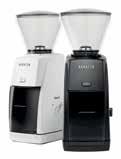
repeatable and approachable. Inside, the metal adjustment system’s innovative dualfunction design provides micro-stepped adjustment from setting #1-20 for espresso, followed by multipurpose macro steps that produce grounds suitable for filter. It’s another way Baratza is making specialty coffee accessible for all. Available in black or white at resellers. baratza.com
TODDY’S CAFE SERIES
Made of brewer’s grade stainless steel, the Toddy Cafe Series packs trusted Toddy cold brew convenience into a front-ofthe-house-friendly

design. With the 10-liter (2.5 gallon) Cafe Series, restaurants and coffee shops can proudly put their cold brewers on display, piquing customer curiosity and fostering engagement. Utilizing singleuse, compostable filters, the flagship Cafe Series brewer offers multiple serving options. Dispense directly from the brewer or attach a hose to fill a keg or other storage vessel. toddy.com
COFFEE ROAST DEGREE ANALYZER FROM ROASTRITE
RoastRite, a developer and manufacturer of coffee roast analyzers, has introduced RA-720BF, the latest generation in its coffee roast degree analyzer BigFoot line. Coffee roast degree analyzers are designed to translate caramelization of coffee grounds and beans to recordable data, assisting roasters in adjusting their roasting process, as well as controlling batch-to-batch roast consistency. roastrite.com
BLACK EAGLE MAVERICK ESPRESSO MACHINE BY VICTORIA ARDUINO

The Black Eagle Maverick is a new highvolume commercial espresso machine in Victoria Arduino’s Eagle machine line. Following previous Black Eagle models, the Maverick features significant innovations in energy efficiency and a proprietary extraction method called “Pure Brew,” designed to broaden the range of extraction possibilities for barista-led experimentation. victoriaarduino.com
GENESIS BREWING MACHINE BY WILBUR CURTIS
This new super-automatic machine from Curtis grinds and brews roasted coffee to produce drinks ranging from 12 to 24 ounces, with a head of foam on the surface. The machine is intended for convenience, cafe and noncommercial foodservice settings. wilburcurtis.com
BRUVI’S SINGLE-SERVE COFFEE SYSTEM
With patent-pending brewing technology and a coffee-first approach, Bruvi offers an innovative, eco-conscious solution for coffee pod disposal, thanks to bio-enzyme infused capsules designed to substantially break down in a landfill more rapidly than untreated plastics through an organic process that leaves no microplastics behind. Bruvi makes seven different beverages, including filter coffee, highpressure espresso and Americanos, cold brew (the first from a single-serve capsule system), matcha lattes and more. bruvi.com
COLD BREW COFFEE SYSTEM FROM RONNOCO
The new proprietary machine is an automatic small-batch cold brew coffee system that continuously pumps fresh water through 16 ounces of Ronnoco-supplied coffee grounds to make a 192-ounce (1.5-gallon)

batch of ready-to-drink cold brew in 60 to 75 minutes. ronnoco.com
FIORENZATO’S ALLGROUND HOME GRINDER
Italian commercial coffee grinder manufacturer


Fiorenzato has released the first product in its newly launched home line, the

AllGround. An all-purpose electric burr grinder, the AllGround has an adjustment collar offering a range of settings, such as “espresso,” “moka” and “filter.” The grinder is offered in a variety of colors and materials.
fiorenzato-usa.com
In collaboration with
MAY-JUL 2023 | HOSPITALITY NEWS ME 75
roastmagazine.com
BAKING TRENDS: WHAT YOU KNEAD TO KNOW
From balancing artisanal methods with hi-tech innovations to meeting a surge in demand for sourdough and the glorious Viennoiseries revival, four experts talk us through the latest developments in the wonderful world of baking.
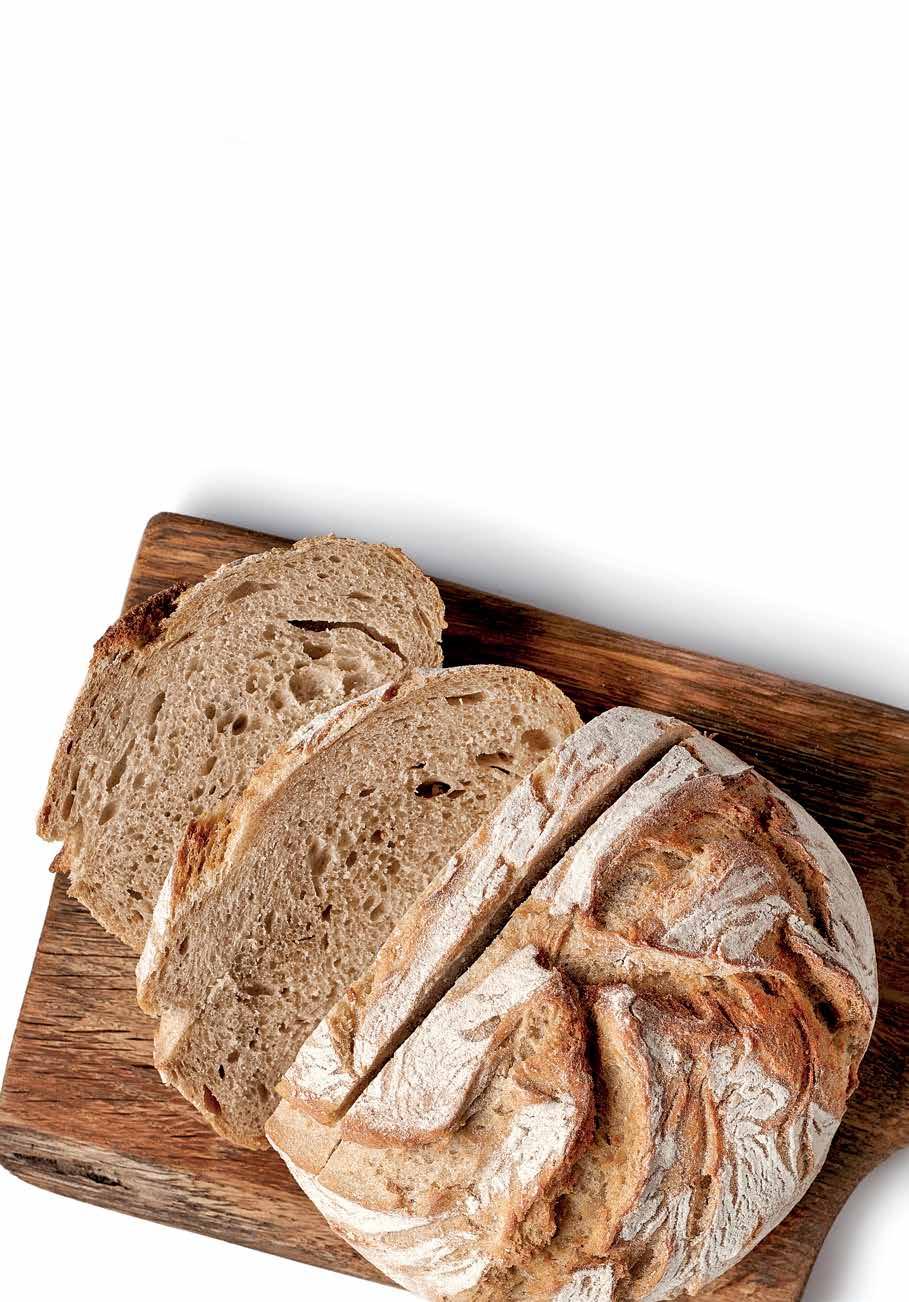
EQUIPMENT PRODUCT ZONE
HOSPITALITY NEWS ME | MAY-JUL 2023 76
What’s trending
Customers are looking for desserts with less sugar in them, so we are working on meeting these demands, while also focusing on using quality ingredients simply, but with finesse, while playing with textures.
Go-to equipment
I couldn’t be without my Rational Oven, which I think leads the way in terms of quality, efficiency and consistency. It’s also very user-friendly and makes baking an easy and enjoyable task, with choux pastry ready in just 25 minutes. I view it as a valuable investment for my concepts.

Industry innovations to watch New tech is undoubtedly important in our industry and will increasingly facilitate our work by reducing everyday challenges. The key is to stay up to date on new workplace innovations and current trends as they enter the market.

What’s trending
We’re seeing more natural ingredients being used, such as natural colors, in part driven by people looking for clean labels showing products made with simple ingredients. There’s also more handcrafting taking place for items like croissant dough, leading to new shapes, innovations and the mixing of trending ingredients with classic flavors. Ingredients that were traditionally purchased are now being made, like praline and nut pastes, which is raising the quality and also decreasing costs.
Go-to equipment

My heart has always been in pastry and with this comes precision so I would have to say highly accurate or different scales. I use platform scales for bigger recipes and quantities, but then have precision scales for weighing anything less than 5 grams –pectin and agar powder, which significantly impact recipes, for example – to ensure consistency. I think rechargeable scales are a great idea since they make your work portable, enabling you to move around the kitchen as required.
Industry innovations to watch Speed ovens are becoming highly popular, featuring a combination of new technology, including the ability to switch from speed function to convection, that creates unbelievable results. Air fryers are another tool that have become almost standard in people’s homes, enabling quicker, healthier cooking.
KARIM BOURGI Chef/owner Kayu-Calla-Oppa-Pikado
MAY-JUL 2023 | HOSPITALITY NEWS ME 77
PAUL HAYWARD Consultant chef/owner
SUMAIA SHOWAIL Founder AYSH Academy

What’s trending
Demand for sourdough breads is on the rise, due to the ever-increasing awareness around health and wellbeing, and bakers are responding to this in their own way. Most stay true to their roots and focus on preserving the artisan and rustic feel of the loafs, while others, especially younger bakers, are keen to make the end product more “instagrammable,” spending more time on shapes, designs and drawings on the loaf itself. The beauty of sourdough is that either way, the bread itself remains tastier and healthier than commercial loafs. The Viennoiseries market is making a strong comeback and again, the impact of social media has sharpened the focus on not only taste and flavors of Danish pastries, but also presentation.
Go-to equipment
The first answer that comes to mind is my hands since when a baker uses their own hands, they are able to feel the dough, communicate with it and transmit their love and passion, which is the ultimate ingredient in every recipe. Another favorite tool is my wooden dough roller, which was given to

me by my late mother. The doughs I roll with this have a charming and magical taste to them. On an industrial level, my favorite tool is the proofer, which allows me to not only save time, but also achieve consistent results without the use of improvers.
Industry innovations to watch
The baking industry has felt the impact of global challenges, such as increases in the cost of living, from higher prices of raw materials to rises in labor costs and utilities. Bakery suppliers are doing a superb job in responding to these challenges, with equipment like mixers and ovens becoming more power efficient and environmentally friendly. New technology is also helping to save time, add convenience and sometimes reduce labor. Applications enable us to operate retarder proofers and convection ovens can run a sequence of different programs without the need for physical attendance. However, we still believe in artisan baking and while we make use of certain technologies, we stop at the point where we’d lose the connection with the dough.
What’s trending
Healthy living continues to be a major trend, with consumers more focused on plant based, organic, natural and sustainably sourced and traceable products. Today we can find locally grown and sourced products much more easily and their variety and quality has evolved over the years through greater efforts to meet rising demand. Eating with your eyes remains a major trend, with people still giving huge importance to the “instagenic” appeal of products. Personalization of products is another emerging trend and requires our industry to ensure we can meet consumers’ demands by having the flexibility needed to customize products or offer a product range that appeals to a broad range of customers.
Go-to equipment
I’m a bit of a traditionalist, although I like trying out fancy new pieces of equipment, so I tend to combine the best of both worlds – old and new. I don’t reject new tech, but I don’t use it to replace the basic pieces of equipment that every baker and pastry chef needs either, so for me, my Kenwood tabletop mixer, with all its different attachments is irreplaceable. This little robust machine has worked long and hard, allowing me to whip my cream or eggs, knead my dough, juice fruits or grind
nuts and spices. The mix then goes into my Miwe oven, which is also irreplaceable and fills me with joy and pleasure. Well adjusted, calibrated and with the right level of basic maintenance it has never disappointed me and I know that whatever goes in will come out perfect!
Industry innovations to watch
There have been ongoing efforts to improve quality control and consistency of products, like a 3D bread quality x-ray scanner I came across which checks if your bread has developed any large irregular holes inside the dough during the fermentation process and identifies them, so the products can be removed before they’d reach customers. Continuous mixing technology is another innovation, with some mixers now also equipped with a hydrobond technology which instantly hydrates dry materials without adding excess heat to the dough. However, while innovation is focused on increasing efficiency and productivity, certain steps in baking have to be followed. While machine manufacturers today remain focused on automatization and efficiency, they are also taking into account the importance of following artisan steps in baking methods that will improve the quality of the final product.
EQUIPMENT PRODUCT ZONE
CHRISTIANE S. TRILCK Head of faculty Richemont Masterbaker
HOSPITALITY NEWS ME | MAY-JUL 2023 78
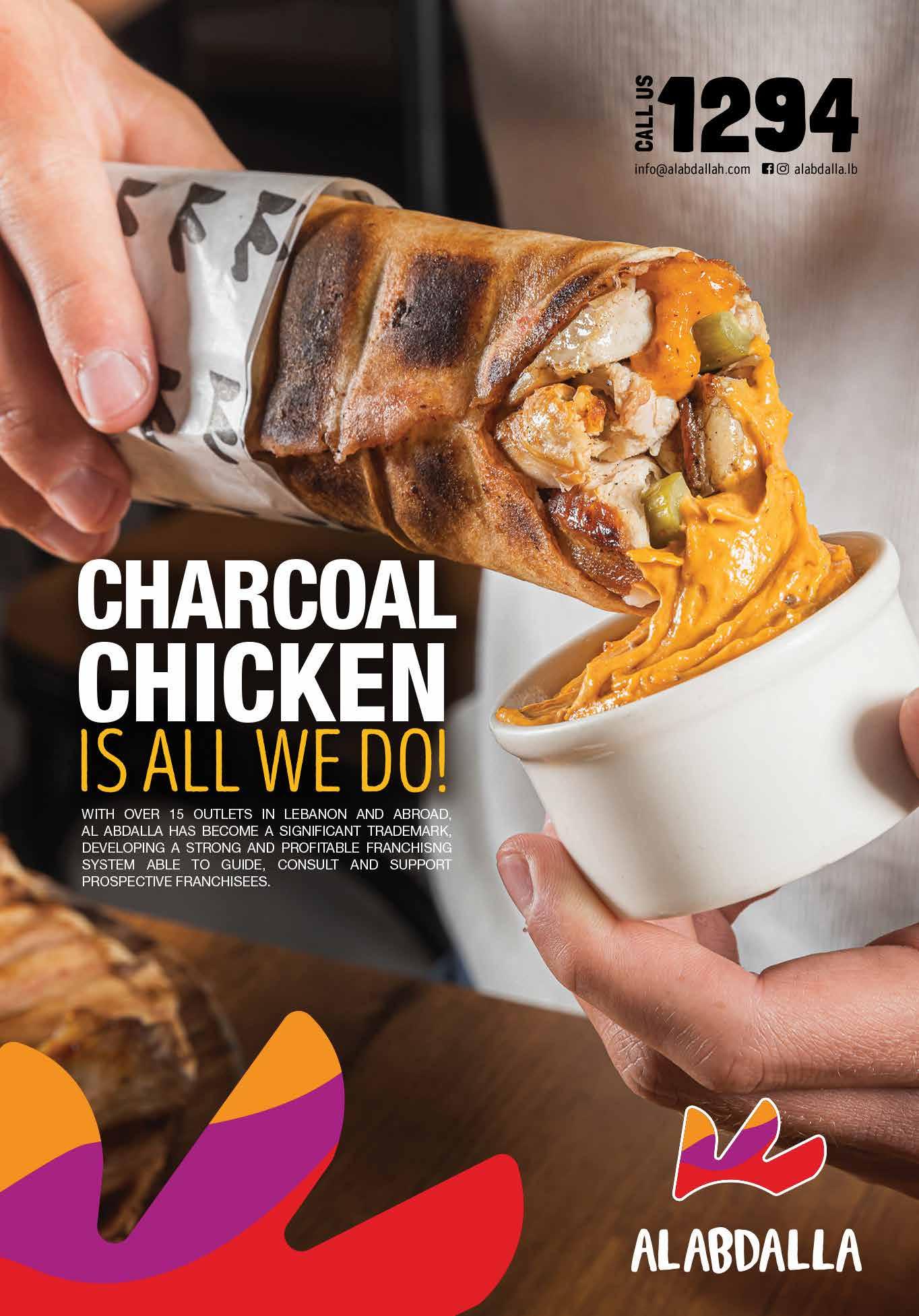
KAMIL BOULOOT

Choosing your cuts
The key factors to consider when selecting quality meat for a particular dish are the degree of marbling, color, firmness and texture. All of these traits contribute to the palatability of the dish and ensure that the meat being served is juicy, tender and flavorsome.
Getting the best from your meat
It’s important to plan ahead by selecting the appropriate meat cut and applying the most suitable cooking method. You can then choose the garnish, seasoning and/ or sauce that best complements the meat dish. Seasoning should be added according to your personal taste and to enhance the flavor of the meat. For meats with a high
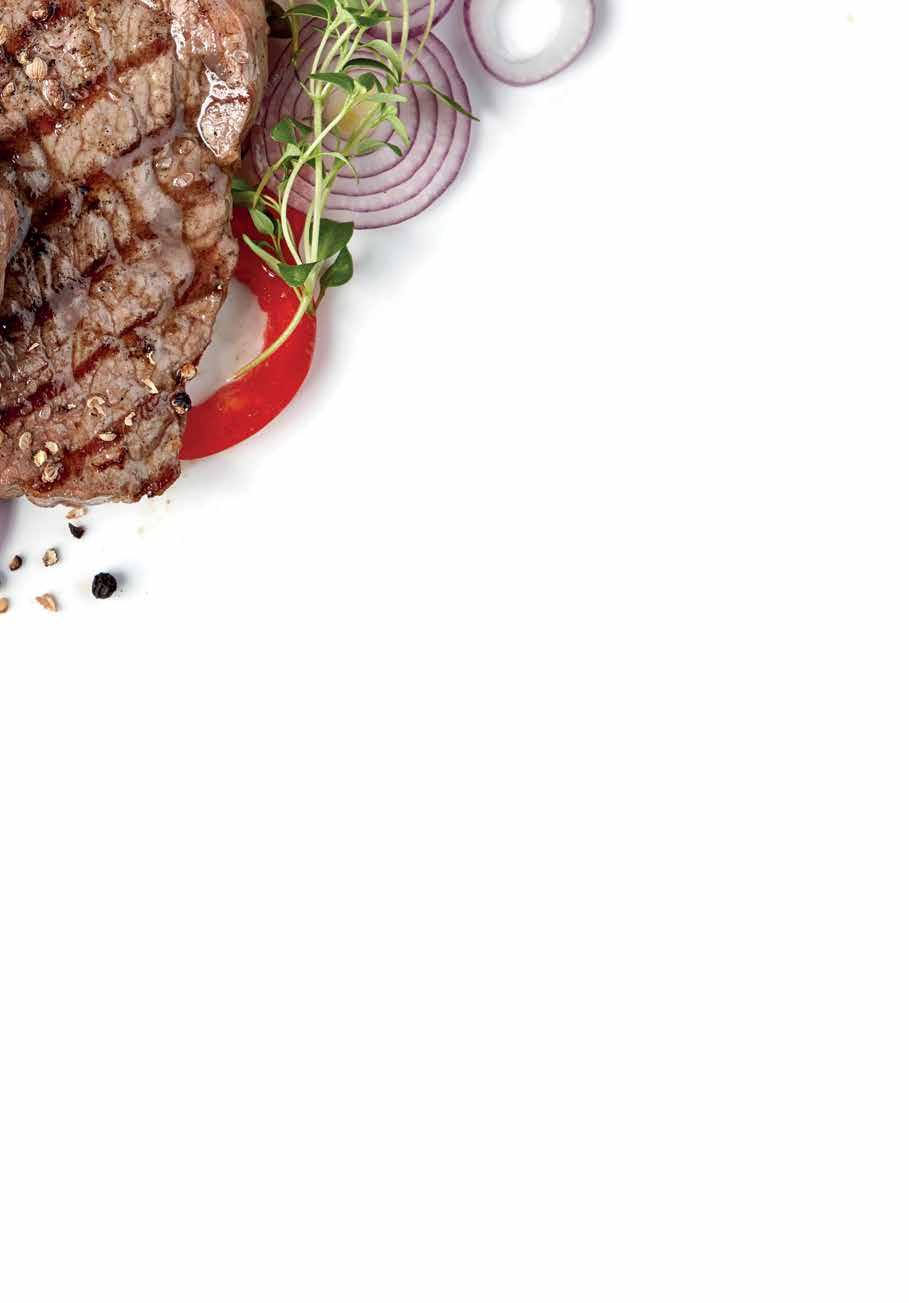
MORE THAN MEATS THE EYE
Five experts get their teeth into the tasty topic of meat industry trends, sharing their thoughts on everything from getting creative with lesser-known cuts to the importance of careful sourcing and good animal welfare.
marbling score, seasonings such as salt and pepper are sufficient to accentuate the flavor, while for those with medium marbling scores, basting can augment the taste.
Lesser-known cuts
Many chefs prefer to work with primary meats, such as ribeye, tomahawk or fillet, simply because they make excellent steaks. However, I also enjoy preparing dishes using lesser-known cuts, such as the flank steak with a high marbling score. Since we introduced this item with a charcoal crust to the menu, it’s become the most requested dish at our restaurant.
Meat aging and tenderizing
The current trend is for dry aging, where meat is stored in a temperature and humidity controlled environment. However, I find the wet ageing process the most effective technique for increased juiciness and tenderness, resulting in more flavorsome meat. Chefs need to know the length of time required to age different cuts of meat, since they vary. For example, rump steak will take longer than a tomahawk or a ribeye steak.
Favorite cooking methods
My favorite method is to grill meat on natural charcoal and wood, since it produces the best results when cooking certain kinds of cuts, giving them a distinctive flavor and smokiness. However, the appropriate
cooking method will depend on the meat cut and the message you want to portray to your customers. With more tender cuts of meat, the preferred cooking method is grilling or seared pan-frying, while slowcooking or braising techniques are more suitable for tougher cuts of meat.
Global meat trends
The purchase of meat from small farmers that practice good animal welfare principles, such as the ethical humane handling and slaughter of cattle, is a current global trend. We source our meat from small cattle farmers who adopt these principles and it’s always of excellent quality, which is an added value for our restaurant. Customers also want variety and are challenging farmers and chefs to produce and prepare new and different cuts of steak. To meet this demand, we’ve introduced the latest and unique cuts of steak at our restaurants, such as the Japanese wagyu ribeye cap and the Mayura chocolate-fed, full-blood wagyu tomahawk. Barley-fed beef, which has superior marbling and tenderness, is another trend. These cattle are peacefully raised, fed a natural barley ration free of hormones and tender stretched, which contribute to the tenderness and the unique flavor of the meat.
Head of culinary and ops, Middle East Seagrass Boutique Hospitality Group
FOOD PRODUCT ZONE HOSPITALITY NEWS ME | MAY-JUL 2023 80
Choosing your cuts
When buying red meat, its color should be bright red although if the meat you are buying is vacuum-packed, the color might appear a bit brownish. This means it is good quality and won’t easily spoil inside the refrigerator. Avoid meat that has dark brown or purple colors since these are signs that the meat came from an old animal or is close to expiring. The meat’s muscle fibers should be clearly visible to the naked eye. Good meat should be dry rather than sticky to the touch and should not appear clear and damp when you cut it.
Getting the best from your meat
Cook leaner cuts, such as top round and eye of round, rare and slice them thinly, like roast beef. Adding fat by barding - wrapping meat in fat, such as bacon, before cooking or basting – can help. For fattier cuts, such as chuck and brisket, low and slow cooking breaks down the sinew and tendons, producing the unparalleled moist richness we love so much in barbecue and braises.
Lesser-known cuts
Strolling through the meat aisle of our local grocery store recently, I saw cheaper cuts of beef that included eye of round, chuck steak, “beef for stew,” cube steak, beef shoulder, bottom center roast and top round minute steak, all priced at less than QAR 40. While these more affordable cuts are either full of sinew and tendon or extremely lean, with the proper knowhow, they can become just as tender and delicious, if not more so, than filet mignon.
Meat aging and tenderizing
Dry aging makes the difference between a good steak and an unforgettable one. Beef can be called dry aged even if the process has only been done for a week or so, but the full development of flavor and tenderness requires dry aging of around six weeks. Another process, known as wet aging,
involves placing the cut of meat in vacuumsealed bags, after which it is aged for several weeks. Wet aging helps tenderize the meat through the naturally occurring enzymes but because it doesn’t dehydrate the beef, it does little to improve and concentrate the flavor in the way dry aging does.
Favorite cooking methods
Braised brisket, surrounded by aromatic vegetables, is a favorite of mine since it is the essence of family-centered feasts and comfort food. Grilling is another favorite, usually involving high heat for a short period of time, with or without a finish on lower or indirect heat. The best cuts of beef for grilling are tenderloin steak, chateaubriand, fillet, sirloin steak, ribeye steak, rump, porterhouse, T-bone, prime rib, flank steak, skirt steak and hangar steak.
Spices, herbs and sauces
Rosemary has a piney flavor and is a wonderful pairing with the heavy or greasy flavors that beef dishes sometimes have. Use rosemary to flavor roasts and tough cuts of meat that will be cooked for long periods of time. Parsley has come into its own in recent years and is now much more than simply a garnish, brightening and adding a fresh note to winter beef dishes.
Choosing your cuts
It’s important to use your senses - touch, smell and sight - when purchasing meat.
Always make sure it’s firm to the touch and avoid meat that is brown at the edges. Marbling means meat will be juicier and have more taste. Prime, choice and select are the most commonly recognized by consumers and are considered food-grade labels by the United States Department of Agriculture.
Getting the best from your meat

The main textural characteristics of meat are firmness - toughness or degree of tenderness - cohesiveness and juiciness. The quality of the meat is normally defined by visual appearance, smell, firmness, juiciness, tenderness and flavor. There are many
indicators of healthy, good meat, starting with the color, which varies, depending on the breed and age of the animal. Then there is the surface structure, the structure of the fibration, the marbling, the juiciness, the smell, the best before date and the expiration date.
Lesser-known cuts
There are plenty of secondary cuts in the beef world, derived from a smaller percentage of the animal, that are equally mouth-watering, many of which are inexpensive, versatile and packed with flavor. My preferred second cuts include hanger steak, which I grill on a Josper charcoal oven and serve with a shallot gravy sauce. Brisket is another which works well, cooked low and slow, which gives the beef time to properly break down and develop its flavor. I’ve also smoked it and serve it as pulled beef with a honey-glazed sauce on toasted brioche bread with Emmental and cheddar cheese.
Favorite cooking methods


Meat-cooking methods generally fall into one of two categories: dry heat - think roasting, broiling, pan-frying, stir-frying and grilling - and moist heat, which is braising, stewing and simmering. Typically, less tender cuts of meat work better with
moist-heat cooking methods, since this adds moisture and helps to break down any tough connective tissues, while more tender cuts of meat don’t need the extra help. My preferred cooking methods are sous vide and char smoking.
Spices, herbs and sauces
Cayenne is a terrific spice to use with beef. It gives a great little peppery kick without mouth-searing heat, so it works with the strong flavor of the meat instead of against it and also lets other flavoring agents shine. Sage is fragrant and warm, adding a little bit of herbal flair to even the simplest of beefbased dishes, while thyme is another favorite because it has the ability to round out the flavor of the meat with its lemony notes.
Global meat trends
The world’s meat production has tripled in the last decade, with a wider choice of meat sources and grades now available to chefs for their kitchen. I always look for the best ingredients for my dishes and fortunately, the local market can fulfill my needs with its high quality meat. This marriage of local ingredients and modern style cuisine has enabled me to offer the highest standards to my diners in terms of taste and quality.
DAVID DAHLHAUS Executive chef
The Ritz Carlton Doha
RABIH FOUANY
Corporate executive chef Vivienda Group KSA
MAY-JUL 2023 | HOSPITALITY NEWS ME 81
Choosing your cuts
It’s important to choose the right piece of meat to apply to your chosen dish. For example, if I’m making stew, then I select a piece of meat that is full of collagen, with a lot of fat covering it. That way when I cook it, I can apply a combination of cooking methods to produce a nice piece of meat that’s tender and also stewed well. If you’re grilling, then you’ll need a piece of meat that is well-marbled from a good quality brand and source. It’s important to buy your meat from a reputable place, whether that’s choosing the right butcher or source country. If you live in a country that imports
meat, choose your products from Australia, America and Argentina, while still giving careful consideration to the source.
Getting the best from your meat
In general, if you’re grilling or broiling, cuts such as tenderloin, striploin, flank or skirt, which have their own flavor and a good texture, are all suitable. There is also a big difference between charred meat, which will have a smokey, charred and caramelized fat flavor, and other varieties, like short ribs, which you’d braise for eight hours to make tender and bring through their deep flavor.
Lesser-known cuts
I love the lesser-known cuts like flanks, oyster blade and rump. The oyster blade, in particular, is a fantastic piece of meat which is highly versatile, suitable for braising, steaming, stewing or grilling. It has an incredible flavor, especially when you buy a higher grade, like the wagyu, which is naturally highly marbled.
Favorite cooking methods
I choose my cooking method depending on which part of the animal the meat comes from. If it comes from a moving part, like the leg, it usually needs to be braised or slow-roasted. Tenderloin, striploin and sirloin can be grilled with fantastic results. I love
slow roasting, slow grilling and braising. Each method gives me a different flavor and a different texture. For example, with the oyster blade, I can use three techniques and the result is amazing.
Spices, herbs and sauces
I always want to taste the meat, so I don’t like to add anything to it, preferring to place extra flavors, like a teriyaki, oyster or sweet chili sauce, for example, on the side. That way I have the freedom to play with the piece of meat and savor the taste. For this reason, I am also against marinating meat, preferring to just balance it with Himalayan salt or “fleur de sel” (flower of salt).
Global meat trends
Fifteen years ago, I was delighted to introduce the global trend of smoking brisket to the Middle East, when I launched the first place selling it in Jordan. Trends change, however, and now we are looking for different techniques. In this way, braising is proving popular and on trend, since it enables you to really use the entire piece of meat, including the fat, skin and connecting tissues. Take short ribs, for example. I sell a lot of short ribs risotto at my restaurants and we can use them in their entirety, even as part of the sauce.
AUSTEN
Executive chef

Choosing your cuts
In my role, choosing the right suppliers is the first essential part of selecting our meats. Meat traceability is crucial to track the origins of meat in the farm-to-fork process, which ensures quality, ethics, safety and something I personally care about - animal welfare.
Getting the best from your meat
Giving beef as an example of how I balance flavor and texture, I like to use a prime cut with a secondary cut, like a shin or oxtail. This involves reducing the portion size of the expensive primary cut and enables me
to showcase my skills by being creative with the secondary, less expensive cut. The secondary cuts have more depth of flavor and texture. Items I’d make, for example, would be a bon-bon, ravioli or an addition to a sauce or ragout.
Lesser-known cuts
I like to use the flat iron steak as it’s just as tender as a fillet steak and is a fraction of the price. Just like any premium steak, I cook it with rapeseed oil, salt and freshmilled pepper, and then finish the steak with some cubed butter, rosemary, thyme and crushed garlic.
Meat aging and tenderizing
I do enjoy using dry aged meat, but from the perspective of day-to-day operations, we use lots of sous-vide techniques in terms of tenderizing. Our Italian restaurant uses many low-temperature cooking methods for cooking the protein dishes and it’s been a pleasure to see my executive sous chef train our local Omani chefs in this.
Favorite cooking methods
I prefer to pan-fry steaks in the hotel, but on my days off, the barbecue is always a favorite of mine, especially a matured ribeye steak on the bone.
Spices, herbs and sauces
For larger items, like briskets and legs of lamb, I tend to choose dried marinades.With large cuts of meat, I like to experiment with brines and have many different recipes which use lots of aromatics, like star anise, bay leaves, cardamom, cloves and fresh herbs.
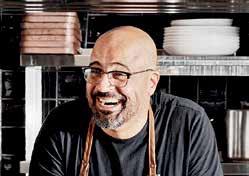
Global meat trends
I’ve noticed businesses trying to reduce meat products in their menus due to climate change concerns. Farming livestock causes 14.5 percent of global greenhouse gas emissions and contributes significantly to water pollution. We’re creating our own burger for the hotel which is 50 percent ground beef and 50 percent vegetables and have trialed it at events where customer feedback has been fully positive. From a cost, environment and culinary point of view, I see this small change as potentially having a big impact, representing our contribution to helping the environment.
FOOD PRODUCT ZONE
TAREK IBRAHIM
Certified master chef Meat & Livestock Australia
REID
InterContinental Muscat
HOSPITALITY NEWS ME | MAY-JUL 2023 82
A CUT ABOVE
Oscar Germán Navarrete Terán, USMEF corporate chef for México, Central America and the Dominican Republic, explains why the US beef industry is leading the way when it comes to sustainable practices, quality and meeting customers' demands.

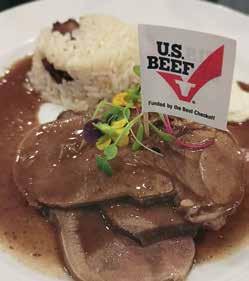
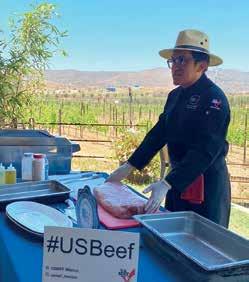

What role is US Meat playing in promoting sustainable practices across the red meat segment?
Sustainability is increasingly important to consumers and is often a factor in their dietary decisions. Cattlemen in the US can be considered among the original pioneers in sustainability, having focused on producing more with less for decades. Their livelihood depends on ensuring that the land they raise their cattle on is well taken care of so that it can be handed down to the next generation.
Cattle in the US are raised on dry, arid and rocky land that is generally unsuitable for other agriculture and play an important role in upcycling plants that cannot be consumed by humans into protein-rich, delicious beef. Grazing is an extremely important element in ensuring that the American grasslands, which capture and store vast amounts of carbon in the soil, remain healthy and productive. The average cattle herd size in the US is less than 50 animals. For US producers, raising cattle is a labor of love and very often an effort to carry on a family legacy. Animal welfare is front and center for American cattlemen. Without caring for their animals and ensuring they are healthy, they can’t produce the product that consumers expect.
What are the defining characteristics of US beef and its quality standards?
Elements that set US beef apart include the specialized genetics, obtained
through breeding the cattle that are used in production, the care taken during their raising to avoid any stress and the supervised attention given to the packing at the plants to ensure a safe product.
Because the animals are fed grainsmainly corn - during the final stages, the meat has the right amount of marbling (fat within the muscles) that guarantees great juiciness, flavor and tenderness. It is this factor that determines the quality classification given by independent graders from the US Department of Agriculture. The classification process is based on the amount of marbling found in the muscle between the 13th and 14th ribs.
That said, all US beef products are of the highest quality - the classification simply determines the different product profiles to be applied when deciding on the cooking methods and preparation procedures to obtain the best result. What US meat offerings are currently proving popular?
While rib-eyes and tenderloin are among the most sought-after US products, people have access to a much wider choice of cuts today. We can now find brisket, top sirloin cap, hanger steaks, tri-tip, flank and flap meat at both supermarkets and famous steakhouses. Suppliers in the Middle East are currently importing some of the underutilized cuts to keep up with these trends.
US ground beef is another popular item on menus, with restaurants now stuffing patties with all kinds of ingredients. We have also seen the ‘back to basics approach to cooking,’ with low and slow preparations found on menus. In another development, US beef producers have implemented Halal practices in some plants, allowing them to hold Halal certifications and respond to this expanding demand.
Meat preparation is a key part of the process. What are the latest trends in this area?
US beef can provide a unique gourmet experience because it is so flexible, working well with sought-after Korean flavors, Mexican spices, Asian sauces and Middle Eastern condiments, for example. As a Mexican, I have ventured into serving blind tasting dinners, where attendees have been able to try different US beef cuts with original Mexican sauces and flavors, once unheard of. The results and experiences have been extremely rewarding and some chefs have applied these ideas to their menus, always adding their personal touch of course, but proving that these new elements match US beef’s versatility and unique characteristics.
usameat.me usmef.org
usameatme german.chef MAY-JUL 2023 | HOSPITALITY NEWS ME 83
FOR TEA?
Spanning a variety of aromatic flavors and herbal infusions, created from leaves grown in the ancient gardens of China or Taiwanese mountains, tea is much more than a breakfast accompaniment or afternoon ritual. We asked four experts to share their thoughts on the perfect cup of tea, new trends and how the future’s shaping up for this ever-popular beverage.

Blending and harmonizing

There is an art to blending which demands respect for tea. Tea that is made in the traditional, orthodox style is blessed with the sense of place, the influence of soil, climate and local ecosystem, and expressed in specific aroma, flavor, texture and appearance. Combining tea with flavors requires multiple trials to harmonize them. Our most popular teas are our Ceylon, Single Origin tea, our Breakfast and Earl Grey teas, although we are seeing interesting trends in the tea category with a new and more adventurous generation.
Pairing potential
Traditionally, tea aficionados in the Middle East appreciated leafy teas with bold appearance and an earthy flavor, although that is changing. As a three-generation family of passionate tea growers, we look to present a variety of tea, working with luxury hospitality operators in the region to offer teas from different regions of Sri Lanka.
Gastronomy and mixology making waves
Benefiting from a natural synergy with food and key ingredients, tea has proved to have exciting potential for gastronomy and mixology projects. Since our first events, we have seen growing enthusiasm for tea paired with food. We have also worked with mixologists around the world to explore ways of combining tea with different terroir and other natural ingredients, spirits and methods to produce tea cocktails. These trends are engaging a new generation of tea drinkers who are attracted to tea for its natural, plant-based goodness, variety and purity. Tea lovers are able to enjoy the experience of fine tea and fine food, which, together, offer an almost magical harmony in taste.
BEVERAGE PRODUCT ZONE ANYONE
DILHAN C. FERNANDO CEO
Dilmah Ceylon Tea Company PLC
HOSPITALITY NEWS ME | MAY-JUL 2023 84
Preparation is key
When choosing tea, knowing where it is sourced from and how it is grown is essential. I take pride in personally visiting each tea farm and sourcing organically grown teas tea directly from the farmers, even though this can be challenging. Drinking tea is a very personal experience and when choosing what to serve to customers, various factors require our consideration, such as their mood and how they are feeling at the time. How the tea is prepared and served is crucial in offering the best experience - the temperature, the water quality and the steeping time all play a vital role in highlighting the best characteristics of each tea.
Going with the mood
I believe tea is a great mood enhancer and social tool for uplifting the spirit. In selecting teas, our team considers the time of day it should be taken. The perfect brews for mornings are teas that help induce energy and focus, while epicurean teas suit midday and teas that help with digestion and calming are perfect for evenings.
Extensive selections
We have a wide range, from white teas and green teas to Oolong and then specialty teas. We also have tisane, which are herbal infusions and caffeine-free teas, and are a great addition as an antioxidant alternative. Our house tea at The St. Regis is the Wuyi Oolong from the Huangcun Garden in Fujian, China, which is known as one of the world’s finest terroirs for high altitude Oolong. It is harvested mountainside in the autumn to preserve the aroma and gets its
The science
A few years ago, I wanted to discover more about the science behind tea leaves. Caffeine is extracted from tea with heat and time, however there is little variation in the amount of caffeine contained in different types of tea. Products labeled herbal teas or tisanes do not contain any caffeine at all, unless they are mixed with tea leaves. Most of our guests are business travelers. In order to help our guests relax and enjoy their stay with us, we offer selections of peppermint, chamomile and lemongrass & ginger options, which are made from other flowers, fruits, herbs and spices.



Big on brewing
Tea is a way in which guests are welcomed and considered the supreme form of hospitality in a variety of cultures. Today, there are many brewing techniques which
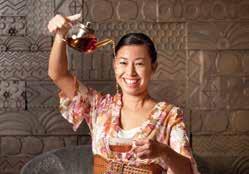
Regional varieties
At Chawan, we specialize in sourcing Japanese teas from different regions to offer an experience that juxtaposes flavors based on each tea region and growing method. These include Sencha from Aichi, Kagoshima or Yame prefecture. In addition, we also source Chinese and Taiwanese teas.
Getting creative
Although Matcha remains the focal interest across the tea community outside of Japan, tea-based mocktails are trending, offering an attractive choice on menus for restaurants and cafes. Aware of this, we provide a tea menu creation as part of our service at Chawan, which includes developing signature tea-based drinks to complement the theme of the restaurant or cafe we work with.
complexity from the mineral riches in soils and high altitude. Characterized by the fresh fragrance of rose, peach, fragrant wood and caramel, it has a buttery sweetness.
New trends
Artisanal, high-quality teas are becoming more popular, while rare, exotic, small batches from unique growing areas is the future. Teas with health benefits and mood enhancing ingredients are on the rise, as are cold brew teas.
Provenance is becoming the major driver of listing teas, with fairtrade and ethical farming practices at the core of any new company selling teas. Organic and biodynamic teas are also in high demand. On a business level, tea subscriptions have become a fast-growing trend, helping to introduce unusual and sometimes exotic teas to an untapped market.
tea lovers routinely use. My top three are: gong fu cha, concentrated amounts of tea leaf brewed in small vessels for a short period; cold brew tea, which involves pouring water over tea leaf, before leaving it in the fridge for few hours to steep; and western style - the most traditional at home - one big tea pot for gong fu brewing.
A fiesta of flavors
There are six main ways to process tea and these methods create the six types: green; organic; white; herbal; black; and matcha. But even within these different tea types, there can be many nuances of flavor, aroma and texture, creating a fantastic array of tastes to explore. We pride ourselves on offering the world’s finest selection of Jing tea, from the ancient gardens of China to the high mountains of Taiwan.
BUDOOR STEELE Tea master and sommelier, Founder of Chawan Japanese Tea House
CHRISTIAAN OLIVIER
Multi property beverage manager and sommelier
The St. Regis Downtown Dubai
HEIDY VILLACRESES
MAY-JUL 2023 | HOSPITALITY NEWS ME 85
Assistant F&B restaurant manager Four Seasons Hotel Riyadh
TIRA BAR
This mouth-watering sweet treat, made of top quality ingredients, is the perfect accompaniment for morning coffee or afternoon tea. Alternatively, simply indulge yourself when an irresistible urge for something special and chocolatey strikes.
BASE Ingredients
800g Callebaut Dark Chocolate 811
400g Callebaut Pure Hazelnut Paste PNP 663
80g roughly ground coffee
5g salt
360g Pailleté Feuilletine Callebaut M-7Pail
GANACHE Ingredients
520g even cream
200g glucose

1.5 scraped vanilla pod
2500g Callebaut White Chocolate W2
200g Callebaut Milk Chocolate 823
80g Amaretto liqueur
Preparation
For the base spread a thin layer of melted Callebaut Dark Chocolate 811 in a frame.
Melt the remaining Callebaut Dark Chocolate 811 at 29°C. Add the Callebaut Hazelnut Paste PNP and gently fold.
Add coffee, salt and Pailleté Feuilletine Callebaut M-7 Pail. Stir well and pour into the frame. Spread and leave to harden.
For the Ganache
Boil the cream, glucose and scraped vanilla pod. Pour the cream mixture onto Callebaut White W2 and Milk 823 Chocolate.
Leave to cool to room temperature. Add the Amaretto liqueur to the chocolate and cream mixture, and mix well.
Pour into the frame and leave to harden.
Remove the frame once the entire mixture is hard and cut into bars. Enrobe the bars with melted Callebaut Milk Chocolate 823. Decorate with a line of Callebaut Dark Chocolate 811. Leave to harden.
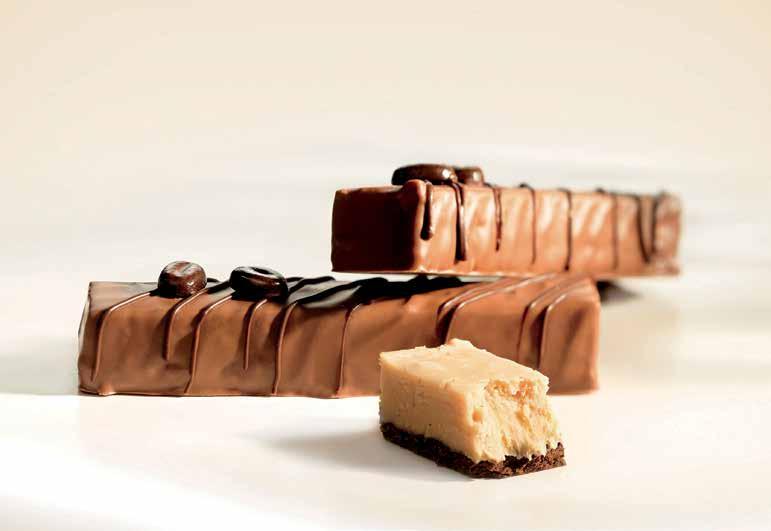
EMF Middle East t. +961 9 938732 | info@emf-me.com www.emf-me.com
CHOCOMANIA PRODUCT ZONE
HOSPITALITY NEWS ME | MAY-JUL 2023 86
ON THE MARKET
Invest in the right products and equipment to make cooking and other functions easier. Here’s a good place to start.
OCCEAN
Groupe GM is relaunching its Occean hotel line, with an emphasis on sustainability.
PRIMAT SAFE BOX
Primat safes are high-quality safe boxes that offer a solution for protecting your money, legal documents and valuables from theft, fire and other threats. These safes are the perfect solution for restaurants, hotels, nightclubs and similar establishments in the hospitality industry.

ZOD SECURITY
zodsecurity.com
HEMP & OAT M*LK
Gaia's original Hemp & Oat M*lk ‘Everyday’ is a barista standard milk alternative expertly developed with coffee in mind. Perfect in lattes, splashed in tea or poured over your cereal, it works every time. Hemp contains essential fatty acids. The ratio in hemp of omega-6 to omega-3 is between 2:1 and 3:1 making it optimal. It also contains all the essential amino acids.

GAIA’S FARMING CO. gaiasfarming.co
HEMP & COCO CHOCOLATE M*LK

This heavenly blend of coconut cream and sustainable cacao with Gaia’s original hemp m*lk base makes for a pretty spectacular chocolate
milk experience. Each 100ml serving contains under 55 calories and no artificial colors, flavors or preservatives, as well as being naturally gluten and soy free. The sweetness even comes from natural fruit sugar sourced from grapes, whilst hemp naturally has the perfect ratio of omega-3 and 6. It’s plant based, sustainable and tastes delicious.
GAIA’S FARMING CO. gaiasfarming.co
NUT BUTTERS
These 100 percent vegan spreads make for a delicious alternative for your morning slice of toast. Add to your overnight oats, pop on your pancakes or even stir into a stir-fry for a nutty twist. Gaia’s versatile nut butters are made with high-oleic peanuts and skin on whole almonds, mixed with hemp hearts. More sustainable and more nutritious, they’re a great source of plantbased protein and are high in omega 3 & 6. GAIA’S FARMING CO. gaiasfarming.co

Based on active marine principles, Occean is a line of cosmetic products rich in toning and vitalising accents offered by the ocean. Its certified vegan formulas contain up to 98 percent of natural ingredients. Abundant in marine oligo-elements and marine algae Laminaria Digitata, the line creates a feeling of wellbeing thanks to the freshness drawn from its properties.

GROUPE GM groupegm.com
RÊVE DE MIEL® AMENITIES


Groupe GM is renewing its hotel line from internationally renowned French brand NUXE. Celebrating their active collaboration since 2013, this specially tailored amenity range will be available worldwide thanks to Groupe GM’s extensive distribution network.
The line, called Rêve de Miel®, is composed of products subtly enriched and scented with honey. With its delicate and honeyed fragrance, the range is perfectly suited for all skin types. The collection comes in a standard line and in a special edition, covering a wide range of amenities.
GROUPE GM groupegm.com
PIZZAS TAKEAWAY BOX
The ultimate takeaway box for pizzas –which is also perfect for serving.
The stepped structure of the surface gives the box a high stability, easy stacking and prevents pizza from sticking to the box. The radial arrangement of the steps toward the center corresponds to the cutting direction, preventing scratches from cutting.
The side vents allow excess moisture to escape, so pizzas stay nice and crispy. This very robust and durable pizza box is available in two sizes and is perfect for use in the food service industry.

MG HOTEL SUPPLIES mghotelsupplies.com
STYLEPOINT DISH
Experience nature with your food presentation. Stylepoint understand that chefs want to have something different with dishes for presenting their creations and to keep exploring their creativity beyond the boundaries of normative food presentation.
MG HOTEL SUPPLIES mghotelsupplies.com
NEW PRODUCTS
MAY-JUL 2023 | HOSPITALITY NEWS ME 87

ADVERTISERS Hospitality News ME is powered by: 79 ALABDALLA 45 AGRI MARKETING 53 ATM 2023 9 BANOPURATOS 18-19 CERTIFIED ANGUS BEEF 2 EMF MIDDLE EAST 5 EUROPEAN BIOPOM 57 FHS 2023 RIYADH 41 HODEMA 8 HOST MILANO 89 LE CORDON BLEU 70 LEBANESE FRANCHISE ASSOCIATION - LFA 71 MALAK AL TAWOUK 90 MEAT & LIVESTOCK AUSTRALIA 7 ROTANA HOTELS 88 SYNDICATE OF OWNERS OF RESTAURANTS, CAFÉS, NIGHT-CLUBS 29 VALHRONA READ MORE ONLINE HOSPITALITYNEWSMAG.COM HOSPITALITY NEWS ME | MAY-JUL 2023 88
Be an entrepreneur and launch your own culinary concept

From authentic to innovative, master this internationally recognised cuisine. Launching in 2023 at Le Cordon Bleu Lebanon institute only.
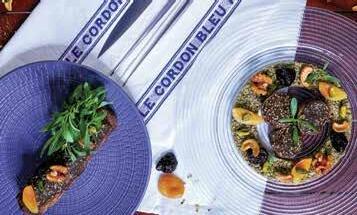
Upskill your techniques and create unique desserts

STUDY IN LEBANON cordonbleu.edu The Institute is located in the 5-star hotel Burj On Bay overlooking the breathtaking Jounieh Bay and offers acclaimed culinary programmes: • Grand Diplôme® • Diplôme de Cuisine • Diplôme de Pâtisserie Contact us: Beirut-admissions@cordonbleu.edu • +961 9 857557 WATCH OUR VIDEO CULINARY ARTS & GASTRONOMY • NUTRITION & PLANT BASED • WINE & BEVERAGES HOSPITALITY, RESTAURANT & TOURISM MANAGEMENT OVER 30 INSTITUTES 20 COUNTRIES 20,000 GRADUATES PER YEAR OVER 100 NATIONALITIES 18 UNIVERSITY PARTNERSHIPS Learn new skills and become a leader DIPLOMA IN CULINARY MANAGEMENT
DIPLOMA IN LEBANESE CUISINE
DIPLOMA IN PÂTISSERIE INNOVATION AND WELLNESS
NEW
The Leading Global Network of Culinary Arts and Hospitality Management Institutes
BEEF AND LAMB
Bringing natural flavour to your menu
Aussie Beef and Lamb is tender, juicy and full of flavour. Australia, with its lush green pastures, clean air and golden sunlight is the ideal environment for producing consistently high quality meat. Factor in one of the Middle East’s most trusted Halal systems and you'll see why it has become the world’s favourite provider of beef and lamb.
By choosing Australian meat, you can be confident you are selecting a cut above, literally bringing the real taste of Australia to your table.
 AUSSIE
AUSSIE
#AussieBeef | #AussieLamb | #AustralianBeef | #AustralianLamb lambandbeef.com /AussieBeefLambME
































































































 MARIA DAVIES
Managing director of global recruitment
Carers4World
MARIE-LOUISE EK
MARIA DAVIES
Managing director of global recruitment
Carers4World
MARIE-LOUISE EK




























































 LOUKAKIS CHRISTOS QC
Wisecup Coffee Roasters
MAHMOUD IZHIMAN Operations manager, Izhiman Coffee Ltd
LOUKAKIS CHRISTOS QC
Wisecup Coffee Roasters
MAHMOUD IZHIMAN Operations manager, Izhiman Coffee Ltd




























































 AUSSIE
AUSSIE